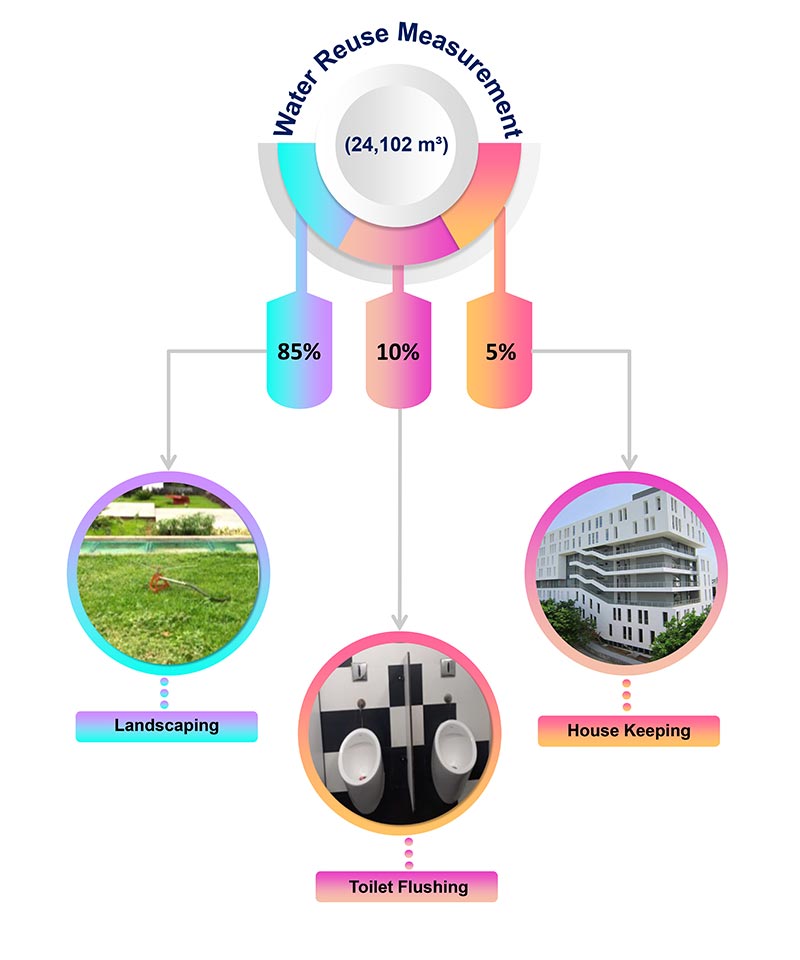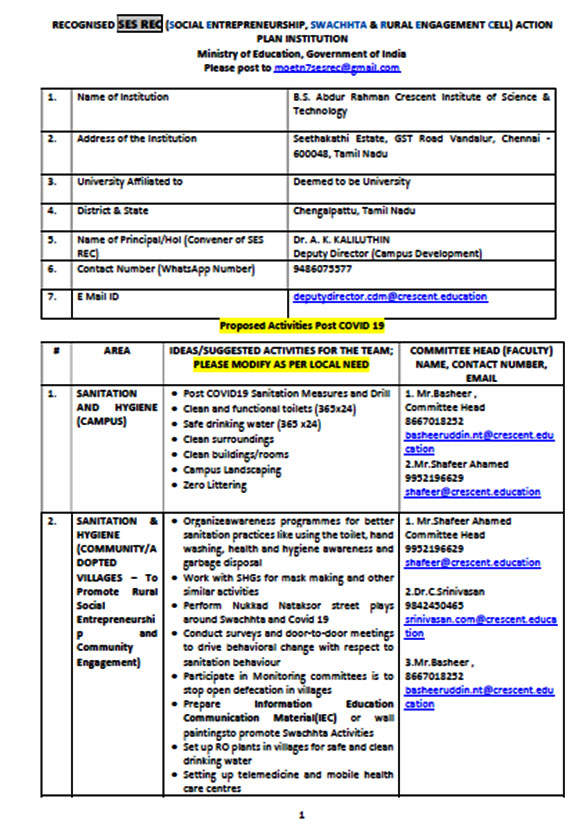Crescent Sustainability Initiatives
Clean Water and Sanitation (SDG 6)
The main source of water supply for the Institute includes,
The water is transported to the Institute by means of lorry.
| Sl.No. | Month / Year | No. of Loads | Total Qty. in (m3) | Annual consumption |
|---|---|---|---|---|
| 1 | Jun-21 | 510 | 510 | 22280 m3 |
| 2 | Jul-21 | 503 | 503 | |
| 3 | Aug-21 | 622 | 622 | |
| 4 | Sep-21 | 968 | 968 | |
| 5 | Oct-21 | 875 | 875 | |
| 6 | Nov-21 | 638 | 638 | |
| 7 | Dec-21 | 972 | 972 | |
| 8 | Jan-22 | 690 | 690 | |
| 9 | Feb-22 | 858 | 858 | |
| 10 | Mar-22 | 1431 | 1431 | |
| 11 | Apr-22 | 1656 | 1656 | |
| 12 | May-22 | 1483 | 1483 | |
| 13 | Jun-22 | 1792 | 1792 | |
| 14 | Jul-22 | 1459 | 1459 | |
| 15 | Aug-22 | 1395 | 1395 | |
| 16 | Sep-22 | 1646 | 1646 | |
| 17 | Oct-22 | 1590 | 1590 | |
| 18 | Nov-22 | 1685 | 1685 | |
| 19 | Dec-22 | 1507 | 1507 |


Water Treatment plants are provided 5 Nos. at various places in the campus to treat the water before use in toilets, quarters, Men’s Hostel & Ladies hostel.
| Location | Capacity | Remarks |
|---|---|---|
| College campus | 250KLD | Commissioned in 2003 as a 150KLd plant. Revamped and capacity increased to 250KLD in 2015 |
| Men’s Hostel | 350KLD | 250KLDCommissioned in 2014.100KLD additional added in 2023 |
| S. No | Location | Total water collected | Water recycled | % of water reutilized |
|---|---|---|---|---|
| 1 | College campus | 250 KL | 225KL | 90 |
| 2 | Men’s Hostel | 350 KL | 315KL | 90 |
| Sl.No. | Month / Year | Quantity of treated water (in m3) | Annual consumption |
|---|---|---|---|
| 1 | June 21 | 672 | |
| 2 | Jul-21 | 665 | 24102 m3 |
| 3 | Aug-21 | 773 | |
| 4 | Sep-21 | 1084 | |
| 5 | Oct-21 | 1000 | |
| 6 | Nov-21 | 787 | |
| 7 | Dec-21 | 1088 | |
| 8 | Jan-22 | 834 | |
| 9 | Feb-22 | 985 | |
| 10 | Mar-22 | 1501 | |
| 11 | Apr-22 | 1703 | |
| 12 | May-22 | 1547 | |
| 13 | Jun-22 | 1826 | |
| 14 | Jul-22 | 1526 | |
| 15 | Aug-22 | 1468 | |
| 16 | Sep-22 | 1694 | |
| 17 | Oct-22 | 1644 | |
| 18 | Nov-22 | 1729 | |
| 19 | Dec-22 | 1569 |
| S. No | Details | Total No. of days | Water Consumption / per day |
|---|---|---|---|
| 1 | Faculty / Staff | 180 | 9 m³ |
| 2 | Students – Day Scholars | 180 | 28 m³ |
| 3 | Students – Men’s Hostel | 250 | 41 m³ |
| 4 | Students – Women’s Hostel | 250 | 12 m³ |
| 5 | Staff Quarters | 300 | 14 m³ |
| 6 | Estate Office | 300 | 3 m³ |
| 7 | Kitchen & Canteen | 250 | 2 m³ |
| Total Consumption per day | 109 m³ | ||
Academic Year 2020-21
B.S. Abdur Rahman Crescent Institute of Science and Technology measures the total volume of water used in the Institution. The main source of water supply for the Institute includes
- Raw water from private suppliers (Extracted from rivers, lakes and aquifers): The water is transported to the Institute by means of lorry.
- University Bore wells: The water required is also met by extracting the water from the bore wells (3 Nos) and open wells (3 Nos ) facility available in the Institute. The Institute also ensures that the quality of water obtained from the private supply and also from the well meets the drinking water standards by frequently conducting the water quality test.
- Treated Water: Water Treatment plants are provided 5 Nos. at various places in the campus to treat the water before use in toilets, quarters, Men’s Hostel & Ladies hostel.
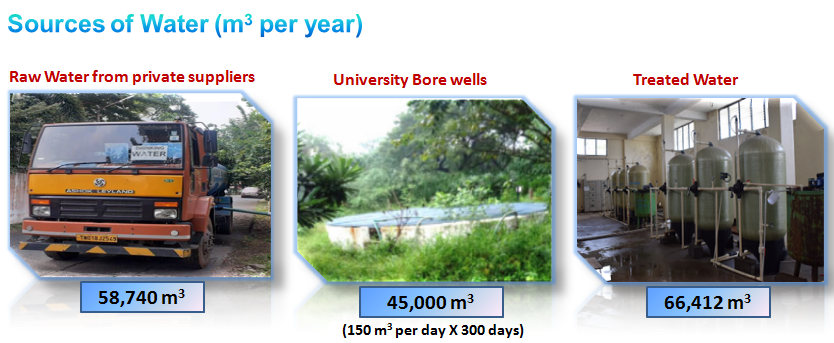
| Sl.No. | Month / Year | No.of Loads | Total Qty. in (Ltrs.) | Annual Total Consumption |
|---|---|---|---|---|
| 1 | Jun-20 | 561 | 56,10,000 | 5,87,40,000 litres (58,740 m3) |
| 2 | Jul-20 | 408 | 40,80,000 | |
| 3 | Aug-20 | 471 | 47,10,000 | |
| 4 | Sep-20 | 409 | 40,90,000 | |
| 5 | Oct-20 | 437 | 43,70,000 | |
| 6 | Nov-20 | 229 | 22,90,000 | |
| 7 | Dec-20 | 57 | 5,70,000 | |
| 8 | Jan-21 | 147 | 14,70,000 | |
| 9 | Feb-21 | 741 | 74,10,000 | |
| 10 | Mar-21 | 1120 | 1,12,00,000 | |
| 11 | Apr-21 | 755 | 75,50,000 | |
| 12 | May-21 | 539 | 53,90,000 | |
| 13 | Jun-21 | 510 | 51,00,000 | |
| 14 | Jul-21 | 503 | 50,30,000 | |
| 15 | Aug-21 | 622 | 62,20,000 | |
| 16 | Sep-21 | 968 | 96,80,000 | |
| 17 | Oct-21 | 875 | 87,50,000 | |
| 18 | Nov-21 | 638 | 63,80,000 | |
| 19 | Dec-21 | 972 | 97,20,000 |
| Sl.No. | Month / Year | Qty. of treated water in Ltrs. | Annual Total Consumption |
|---|---|---|---|
| 1 | Jun-20 | 45,55,000 | 6,64,12,200 litres (66,412 m3) |
| 2 | Jul-20 | 4,45,000 | |
| 3 | Aug-20 | 47,10,000 | |
| 4 | Sep-20 | 51,24,200 | |
| 5 | Oct-20 | 1,00,08,000 | |
| 6 | Nov-20 | 96,40,000 | |
| 7 | Dec-20 | 90,50,000 | |
| 8 | Jan-21 | 96,10,000 | |
| 9 | Feb-21 | 47,20,000 | |
| 10 | Mar-21 | 68,80,000 | |
| 11 | Apr-21 | 8,30,000 | |
| 12 | May-21 | 8,40,000 | |
| 13 | Jun-21 | 7,90,000 | |
| 14 | Jul-21 | 1,24,15,000 | |
| 15 | Aug-21 | 1,06,55,000 | |
| 16 | Sep-21 | 1,15,75,000 | |
| 17 | Oct-21 | 1,15,50,000 | |
| 18 | Nov-21 | 1,23,00,000 | |
| 19 | Dec-21 | 1,16,00,000 |
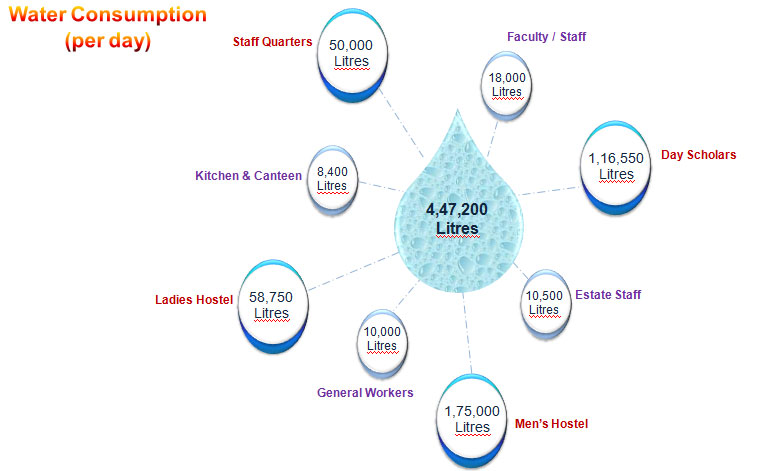

B.S. Abdur Rahman Crescent Institute of Science and Technology takes sufficient measures to treat the wastewater generated within the premises and it ensures that the treated water is reused within the campus. Estate office has established suitable and sustainable sewage treatment plants with the design features to completely treat the wastewater generated in the university.
- An additional of 100 KLD capacity of Sewage treatment plant has been commissioned IN THE YEAR 2022 in the KBA Men’s hostel to treat the Sewage water.
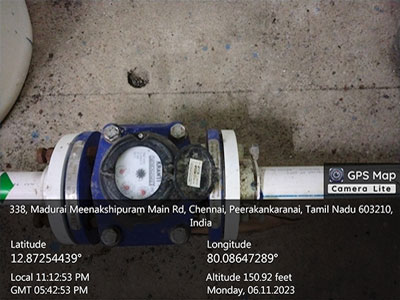
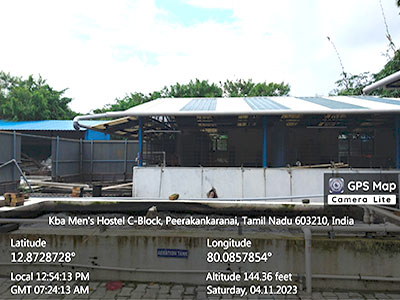
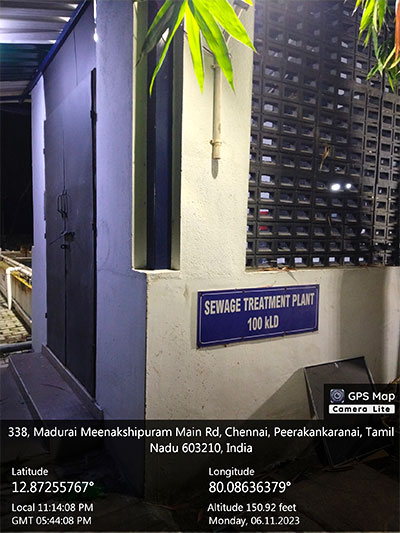
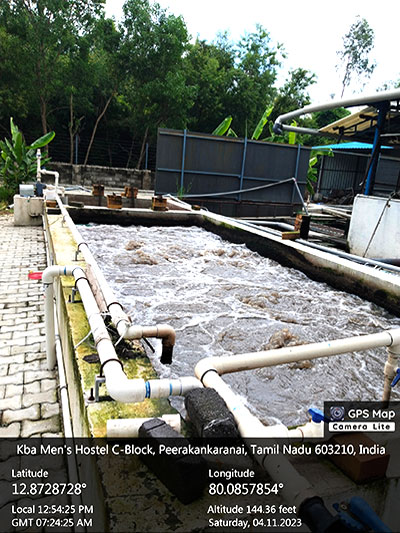
- 2 nos. of Sewage treatment plants of 250KLD capacity are available, one for Men’s Hostel and one for Institute campus
| Location | Capacity | Remarks |
|---|---|---|
| College campus | 250KLD | Commissioned in 2003 as a 150KLd plant. Revamped and capacity increased to 250KLD in 2015 |
| Men’s Hostel | 350KLD | 250KLDCommissioned in 2014.100KLD additional added in2023 |
| S.No | Location | Total water collected | Water recycled | % of water reutilized |
|---|---|---|---|---|
| 1 | College campus | 250 KL | 225 KL | 90 |
| 2 | Men’s Hostel | 350 KL | 315 KL | 90 |
- The sewage generated in the University is generally characterized by the presence of organic, inorganic and suspended solids.
- The chain of treatment is aimed to remove such pollutants from the wastewater so that it can be effectively reused.
- The treatment system consists of preliminary treatment system followed by the primary and secondary treatment process.
- The preliminary treatment system aims the removal of floating bodies and grits from the waste water. Bar Screens are used in the treatment plant to remove materials like plastics and other floating objects.
- The grit chambers are used to remove sand and silts from the wastewater.
- The primary sedimentation tank helps in the removal of the suspended solids.
- The biological treatment system is the secondary treatment process used in the removal of organics from the wastewater
- The suspended solids are removed using the primary sedimentation tank and after this the wastewater is subjected to biological treatment to remove the organic content from the waste.
- The secondary treatment process is incorporated with ECO-BIO BLOCK so as to increase the efficiency of the treatment system.
- The Eco-Bio Bricks helps in the attachment of bacteria in the treatment system and helps in the better removal of organic content from the wastewater.
- This attached system will also help the treatment system to handle shock loadings if there is an increase in the organic loading rate in the biological treatment system.
- The sewage treatment plant is working on the principle of attached growth aerobic system (Eco-Bio Block) followed by sand filter and carbon filter.
- The carbon and sand filter ensures that any amount of organics that is left in the wastewater is suitably adsorbed from the wastewater and it is stored in the collection tank.
- The entire Sewage Treatment Plant is periodically subjected to maintenance regularly.
- The working of all the pumps and valves are checked periodically to ensure the smooth functioning of the sewage treatment plant.
- The treated water is used for landscaping and toilet flushing purpose.
- This helps the university to reduce its dependency of fresh water from wells for gardening.
- The physical, chemical and biological characteristics of the treated water are tested to ensure the efficiency of the treatment systems.
- Some of the important parameters checked include pH, solids, Chemical oxygen demand, Biochemical oxygen demand, Nitrates, chlorides etc.
- The treated wastewater is checked periodically to ensure its quality so that it can be effectively reused for gardening and as well for the toilet flushing.

| Sl.No. | Month / Year | Quantity of treated water (in m3) | Annual consumption |
|---|---|---|---|
| 1 | June 21 | 672 | |
| 2 | Jul-21 | 665 | 24102 m3 |
| 3 | Aug-21 | 773 | |
| 4 | Sep-21 | 1084 | |
| 5 | Oct-21 | 1000 | |
| 6 | Nov-21 | 787 | |
| 7 | Dec-21 | 1088 | |
| 8 | Jan-22 | 834 | |
| 9 | Feb-22 | 985 | |
| 10 | Mar-22 | 1501 | |
| 11 | Apr-22 | 1703 | |
| 12 | May-22 | 1547 | |
| 13 | Jun-22 | 1826 | |
| 14 | Jul-22 | 1526 | |
| 15 | Aug-22 | 1468 | |
| 16 | Sep-22 | 1694 | |
| 17 | Oct-22 | 1644 | |
| 18 | Nov-22 | 1729 | |
| 19 | Dec-22 | 1569 |
Academic Year 2020-21
LIQUID WASTE MANAGEMENT
- The University takes sufficient measures to treat the wastewater generated within the premises and it ensures that the treated water is reused within the campus. Estate office has established suitable and sustainable sewage treatment plants with the design features to completely treat the wastewater generated in the university.
- 2 nos. of Sewage treatment plants of 250KLD capacity are available, one for Men’s Hostel and one for Institute campus.
- The sewage generated in the University is generally characterized by the presence of organic, inorganic and suspended solids.
- The chain of treatment is aimed to remove such pollutants from the wastewater so that it can be effectively reused.
- The treatment system consists of preliminary treatment system followed by the primary and secondary treatment process.
- The preliminary treatment system aims the removal of floating bodies and grits from the waste water. Bar Screens are used in the treatment plant to remove materials like plastics and other floating objects.
- The grit chambers are used to remove sand and silts from the wastewater.
- The primary sedimentation tank helps in the removal of the suspended solids.
- The biological treatment system is the secondary treatment process used in the removal of organics from the wastewater
- The suspended solids are removed using the primary sedimentation tank and after this the wastewater is subjected to biological treatment to remove the organic content from the waste.
- The secondary treatment process is incorporated with ECO-BIO BLOCK so as to increase the efficiency of the treatment system.
- The Eco-Bio Bricks helps in the attachment of bacteria in the treatment system and helps in the better removal of organic content from the wastewater.
- This attached system will also help the treatment system to handle shock loadings if there is an increase in the organic loading rate in the biological treatment system.
- The sewage treatment plant is working on the principle of attached growth aerobic system (Eco-Bio Block) followed by sand filter and carbon filter.
- The carbon and sand filter ensures that any amount of organics that is left in the wastewater is suitably adsorbed from the wastewater and it is stored in the collection tank.
- The entire Sewage Treatment Plant is periodically subjected to maintenance regularly.
- The working of all the pumps and valves are checked periodically to ensure the smooth functioning of the sewage treatment plant.
- The treated water is used for landscaping and toilet flushing purpose.
- This helps the university to reduce its dependency of fresh water from wells for gardening.
- The physical, chemical and biological characteristics of the treated water are tested to ensure the efficiency of the treatment systems.
- Some of the important parameters checked include pH, solids, Chemical oxygen demand, Biochemical oxygen demand, Nitrates, chlorides etc.
- The treated wastewater is checked periodically to ensure its quality so that it can be effectively reused for gardening and as well for the toilet flushing.
LIQUID WASTE MANAGEMENT – SEWAGE TREATMENT PLANT – 500KLD
- 2 nos. of Sewage treatment plants of 250KLD capacity are available, one for Men’s Hostel and one for Institute campus. The STP is of Eco-Bio Block type. The treated water is used for landscaping and toilet flushing purpose.
- The sewage treatment plant is working on the principle of attached growth aerobic system (Eco-Bio bricks) followed by sand filter and carbon filter. The treated water is having a COD about 100 mg/L and BOD about 16 mg/L.
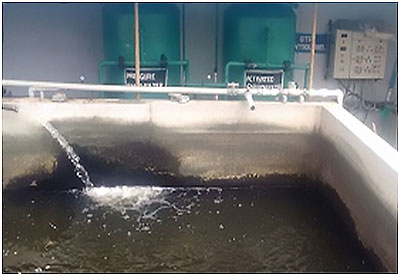
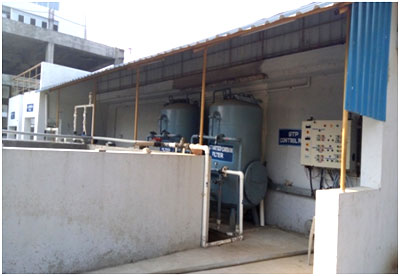
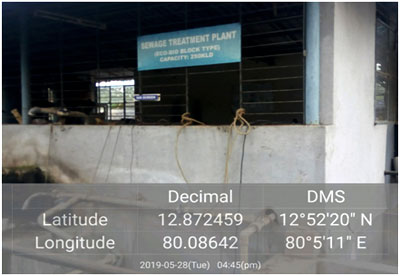

| Location | Capacity | Remarks |
|---|---|---|
| College campus | 250KLD | Commissioned in 2003 as a 150KLd plant. Revamped and capacity increased to 250KLD in 2015 |
| Men’s Hostel | 250KLD | Commissioned in 2014 |
| S.No | Location | Total water collected | Water recycled | % of water reutilized |
|---|---|---|---|---|
| 1 | College campus | 250 KL | 220KL | 90 |
| 2 | Men’s Hostel | 250 KL | 220KL | 90 |
| Sl.No. | Month / Year | Qty. of treated water in Ltrs. | Annual Total Consumption |
|---|---|---|---|
| 1 | Jun-20 | 45,55,000 | 6,64,12,200 litres (66,412 m3) |
| 2 | Jul-20 | 4,45,000 | |
| 3 | Aug-20 | 47,10,000 | |
| 4 | Sep-20 | 51,24,200 | |
| 5 | Oct-20 | 1,00,08,000 | |
| 6 | Nov-20 | 96,40,000 | |
| 7 | Dec-20 | 90,50,000 | |
| 8 | Jan-21 | 96,10,000 | |
| 9 | Feb-21 | 47,20,000 | |
| 10 | Mar-21 | 68,80,000 | |
| 11 | Apr-21 | 8,30,000 | |
| 12 | May-21 | 8,40,000 | |
| 13 | Jun-21 | 7,90,000 | |
| 14 | Jul-21 | 1,24,15,000 | |
| 15 | Aug-21 | 1,06,55,000 | |
| 16 | Sep-21 | 1,15,75,000 | |
| 17 | Oct-21 | 1,15,50,000 | |
| 18 | Nov-21 | 1,23,00,000 | |
| 19 | Dec-21 | 1,16,00,000 |
MIRA CARBON SEWAGE TREATMENT PLANT
Our Institute has established MIRA CARBON SEWAGE TREATMENT PLANT of 2 m3 capacity in association with M/S.Kanyo Group of Companies to treat domestic wastewater generated from the Institute.
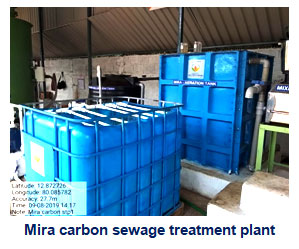
PROTECTED WATER SUPPLY
Water Treatment plants are provided – 5 Nos. at various places in the campus to treat the water before use in toilets, quarters, Men’s Hostel & Ladies hostel.
The capacity and quantity of water treated by each plant is tabled below.
| S.NO | LOCATION | CAPACITY | WORKING HOURS | |
|---|---|---|---|---|
| 1 | New staff Quarters | 5m3/hr | 10 | |
| 2 | New ladies hostel | 5m3/hr | 12 | |
| 3 | Men’s hostel service block | 10m3/hr | 18 | |
| 4 | VC Villa | 1m3/hr | 4 | |
| 5 | Life Science block | 5m3/hr | 8 | |
| Total Treated Water | 3,35,000 Liters per day | |||
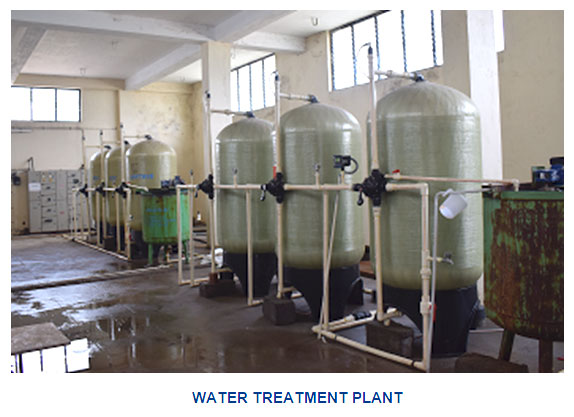

| sl. No | Water Consumption / Day | Occupancy in Nos | consumption/day in liters |
|---|---|---|---|
| Occupants | |||
| 1 | College Student day scholars 45 lit/day @ 70% usage | 3700 | 116550 |
| 2 | Ladies Hostel 125 lit/day | 470 | 58750 |
| 3 | Men’s Hostel 125 lit/day | 1400 | 175000 |
| 4 | Employees : (1) Teaching staff 45 lit/day | 450 | 20250 |
| (2) Non-Teaching staff 30lit/day | 300 | 9000 | |
| (3) General workers | 280 | 8400 | |
| (4) Kitchen and canteen | 50 | 10000 | |
| 5 | Quarters 125lit/day | 400 | 50000 |
| 7050 | 447200 | ||
| 6 | Floating @ 5% | 7403 | 10575 |
| Total water consumption/day in liters | 4,57,775 | ||
| Avg water consumption per capita/day | 62 |
The below submitted water sample meets the TNPCB Standards
Ref. Decision Rule: EES/QSP/012
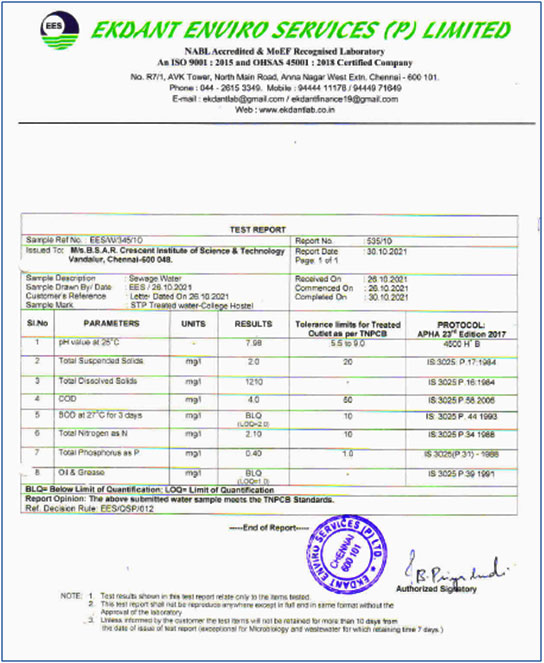
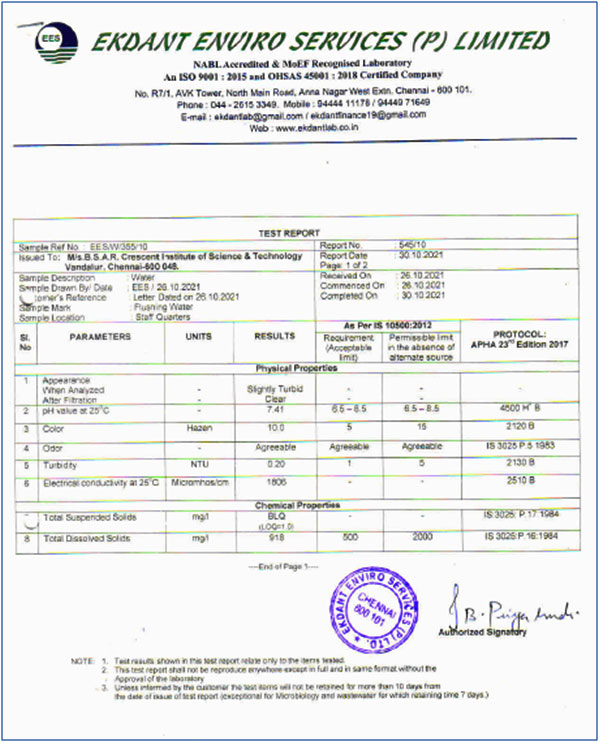
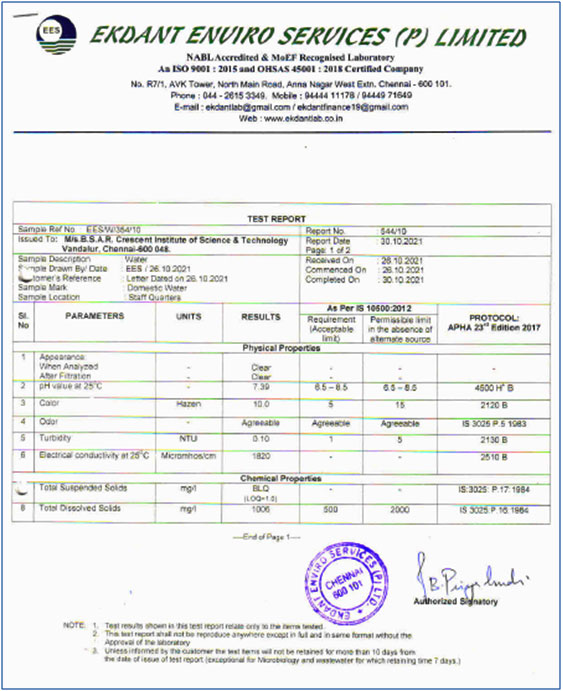
RAM-KALAM CENTRE FOR ENERGY CONSULTANCY AND TRAINING
Mobile: +91- 80567 19372, 99420 14544, (Whatsapp) E-mail: ramkalamcect@gmail.com
A. Description of Environment, Green & Water Audit Process:
- Environment, Green & Water Audit is essentially a management tool for measuring the effects and impacts of activities undertaken in the university campus on environment more particularly atmospheric air, Soil and Water.
- Primarily analyse the utilization of all types of energy, assessment of environmental condition, estimation of annual CO2 emission from all the defined activities and mapping with campus greenery system
- Also it keeps the university accountable by examining their practices and determining what measures need to be implemented in order to maintain the the sustainability
B: Scope of the Audit:
- Identification of history of activities, present environmental practices followed, monitoring records and known sources of environmental issues inside the university
- Adoption of natural resources as input (such as energy and water), processing and utilization and generation of wastes (including hazardous and toxic)
- Handling and storage of all types of wastes (Solid, liquid and gas), transportation of waste from source to yard, reuse and recycling possibilities, storage mechanism and effective disposal
- Measurement of effectiveness of pollution control (air, water and soil pollution), maintenance logs, emission test reports and routine analytical reports.
- Judicious usage of water, effective water distribution network, maintaining best system efficiency and usage of water saving equipments/methods/standards.
- Providing constant awareness to all stakeholders on Environment impacts, risk analysis and Ecology.
C: Outcomes of the Audit Process:
- Use as a basis for the development of environmental management policies or efforts to improve the existing plants
- Identification of possible cost and energy saving from energy conservation, waste reduction, reuse and recycling
- Development of rule based system to become a sustainable environment inside the university campus and nurture the importance of less energy and less environmental impacts.
- Formation of methodology for long term road map for maintaining green environment within the campus and encourage the stakeholders for continuous improvements
D: Focus Areas in the Audit Process:
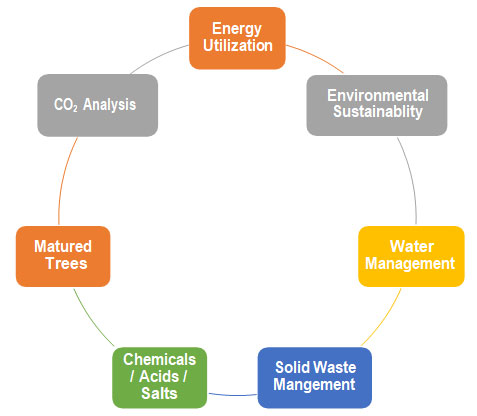
E. Audit Coverage:
| ENVIRONMENTAL AUDIT | |
| Chemical/Salt/Acid Usage Study | · Analysis of chemical/Salt/Acid Usage in different laboratories, method of storage and dilution, application of chemicals, method of disposal. |
| Transport system | · Examination of no. of vehicles, make and model, fuel used, pollution certificates and best operating practices followed to conserve fuel. |
| Air, Water & Soil Quality | · Assessment on indoor and ambient air atmosphere, Review of water quality, Codes and Standards followed in testing of water & soil. |
| Bio-gas Generation | · Capacity, location, collection of food and vegetable wastes, storage tank, gas distribution, utilization and reduction of LPG. |
| GREEN AUDIT | |
| Roof top Solar PV Plants | · Assessment of solar PV plants, capacity, location, yearly energy generation, inverter capacity, energy utilization and common connection in MV panel, panel cleaning methods, schedule and dedicated earthing system. |
| Solar Thermal System | · Inspection of solar hot water generation for bathing in hostel area, capacity, input water and hot water distribution. |
| Campus Greenery | · Assessment of no. of matured trees, location, botanical names, amount of CO2 reduction. |
| WATER AUDIT | |
| Water distribution system | · Incoming raw water, water purification system (RO), potable water distribution and water conservation measures |
| · Water distribution for general utilities (cooking and bathing), taps and control values, water distribution for hostel and best practices in water distribution. | |
| Rain Water Harvesting | · Assessment of RWH, capacity and location, bore-well pit recharge, open ended water storage and utilization and study on ground water improvement. |
| Sewage Treatment Plant (Liquid Waste Management) | · Sewage collection, storage and treatment, capacity, type of aerator, collection and distribution tank, treated water usage (gardening and toilet flushing) and sludge collection and usage. |
F: Standards Adopted:
- Bureau of Energy Efficiency (BEE) Guidelines to conduct the detailed energy audit process
- ISO 14064-Part-1 – Specification with guidance at the organization level for quantification and reporting of GHG emissions and removals (Second Edition)
- ISO 14064-Part-2 – Specification with guidance at the project level for quantification, monitoring and reporting of GHG emissions reductions or removal enhancement (Second Edition-2019)
- ISO 14064-Part-3 – Specification with guidance for the verification and validation of GHG statements (Second Edition-2019)
- The Greenhouse Gas Protocol – A Corporate Accounting and Reporting Standard (Revised Edition) released by World Resources Institute & World Business Council for SustainableDevelopment–2014
- Ministry of Environment, Forest and Climate Change Notification on “Battery Waste Management Rules, 2020” & “E-Waste (Management) Rules, 2016”, & “Solid Waste Management Rules, 2015”
- Minstry of Jal Shakthi, Guidelines to regulate and control Ground Water Extraction in India and Other Water related Standards
G: Summary & Recommendations of the Audit Process:
In order to make the B.S. Abdur Rahman Crescent Institute of Science & Technology campus 100 % Environmental sustainability and lush Greenery; the audit team recommends to implement the following measures:
G-1: Environmental Management:
- Properly follow scientific method of handling chemicals/Acids/Salts and safe disposal through 3rd party
- Plan for BS-IV vehicles in future
- It is recommended to use natural ingredients like orange peel extract & vinegar
- Indoor Environment Quality (IEQ) refers to the environmental condition inside a building which is influenced by i) Thermal comfort, ii) Lighting comfort, iii) Acoustic comfort and iv) Indoor Air quality (IAQ). The audit team recommends to conduct the IEQ audits and confirm each building comfort level.<
G-2: Green Campus Management:
- S. Abdur Rahman Crescent Institute of Science & Technology campus is blessed with more varieties of resident birds (species always living inside the campus) and amphibians (Amphibians are small vertebrates that need water, or a moist environment, to survive).
- Bird Sighting and Survey: Conduct a dedicated bird sighting and identify the list of birds both residing birds and migratory birds available in the college campus
- Reptile & Amphibian survey: Similar to bird survey; conduct a survey to list the amphibians available in the campus
- One Student – One Tree: This is an Initiative of AICTE to increase the green coverage inside the campus and committed to reduce the Urban Heat Island Effect (UHIE), college may plan to plant nearly 2,000 trees in future, make the entire campus with complete green cover and maintain an excellent bio-diversity
- Indoor plants: Not only looks beautiful, but also brings life to our living space. They also help purify the air. According to a study of NASA even a small plant inside the workspace can help remove at least three household toxins (think benzene, formaldehyde, and trichloroethylene, which are carcinogenic chemicals commonly found in stagnant indoor environments)
G-3: Waste Management:
- Cotton, Syringe, Needles are to be kept separately as these are treated as Bio-Medical wastes
- Yellow dust bins must be placed to collect these bio-medical wastes
- After COVID; mask, sanitizer bottles, gloves and other medical items must be trashed only through the yellow bins
- This must be informed to all the students and stakeholders. Suitable steps have to be taken to disseminate this information
- All the solid wastes are to be properly stored in a separate place and should be maintained as a record mentioning its quantity
- The food waste must be weighted and marked in a record before keeping into the digester unit. This must be checked with the amount of gas generated using suitable calculation and check with the designed output
- Any waste items given to trust office or to the 3rdparty must have a record of the respective department
- Reduction of Paper: Workout a policy to move towards paperless office. Present system of paper usage may be reviewed and wherever possible; digitalize the activities and reduce the paper
- Adopt College Management System (CMS) and try to automate
- Automation saves energy, saves man power, saves paper, leads to better transparency, efficient man power utilization and thus saves cost
G-4: Water Conservation & Management:
- Utilize more amount of treated water from STP plant since most of the approving agencies like AICTE, UGC etc., are now requesting to utilize the treated water
- To check the quantity of water utilized by each buildings by connecting digital water flow meter and optimize the water usage
- Similar to raw water measurement; water inlet to the STP & treated STP water pipe line must be fitted with flow meter and check the quantity of inlet & outlet water
- Prepare and maintain a Single Line Diagram (SLD) for water distribution network
- Try to reduce water tapped from the ground water source since it is not environmental friendly
- Paste water and energy saving slogans at appropriate places
- Generate your own power and water for regular activities and move towards Net Zero Energy and Net Zero Water Building
- Retrofit aerator based water taps for good water For hand washing applications, all the pipes must be fitted with aerators
- In future; install Bio-Sewage Treatment Plant as it reduces the amount of energy required to operate the plant and environmental friendly operation
- Captures almost 100 % rain water harvesting through i) Recharging pits and ii) Open well type storage pits
- Water treatment log must be maintained indicating the water inlet, treated and outlet water quantity
- Install sensor based water controller in each Over Head Tanks and reduce the water waste and power required to operate the pump
- Energy required to process the water treatment must be calculated
- Overall cost of treated water by accounting i) consumables, ii) manpower iii) energy and iv) other conventional expenses
- Also it is highly recommended to use the treated STP water for toilet flushing system as this is much essential for the AICTE, UGC norms of treated water usage
- Display the specifications of the STP (Like RWH display)
- Use the treated water at the maximum in whatever possible areas and try to minimize the fresh water intake (from any source)
- Set a policy and fix a target for usage of treated water; ensure that the plan is being executed without any deviation. Increase the % of usage of treated water year by year
- With the advent of smart technologies, it is possible to have centralized monitoring in real-time using Internet of Things (loT), Geographic Information System (GIS) software, etc. as per Jal Jeevan Mission, Department of Drinking Water & Sanitation Ministry of Jal Shakti
- In hostel building; try to introduce “Ernerqency Water Line” during day time (usually from 9.00 AM tO 4.00 PM). The gate valve of the common line is closed during that time and hence water wastage is avoided in the knowingly or unknowingly opened taps
- Introduce Power Wash floor cleaning mechanism which removes the stains easily with reduced water usage
- Awareness campus must be conducted to all the stakeholders at regular interval. Through this initiative; Painting, Photography, Slogan and Poster making contest are conducted to create consciousness among the students and faculties
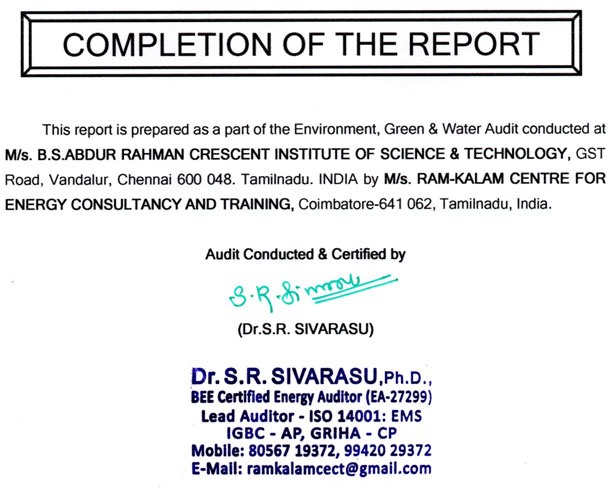
B.S.Adbur Rahman Crescent Institute of Science and Technology have implemented sufficient measures to prevent the polluted water entering the water sources /water pipelines Some of the processes practised and provisions available in the Institute are given below
In the Institute, the plumbing facility for collection of water from the well and subsequently transporting it for the treatment unit and also for supply has been meticulously planned and implemented. The pipes are laid at a suitable gradient and the water is transported safely . It is also ensured that there is no leakages in the water pipelines through frequent inspection. The water pipes are also subjected to an immediate replacement if there is any problem of breakage has occurred because of any accidents. Similary the wastewater collected from the various locations of the Instituion is conveyed in a separate sewer pipe lines.Sufficient manholes are provided at several junctions to conduct the inspection of the pipelines. The pumps and other valves placed in the sewer pipelines are also checked for its performance and it is maintained properly. The treated wastewater is also transported safely and used for flushing and gardening.
There are separate markings indicated in the plumbing lines for the easy identifications of water and sewer lines. These measures has helped the Institute the manage the wastewater generated in the premises and it is been prevented from entering the water pipelines or any other water sources.
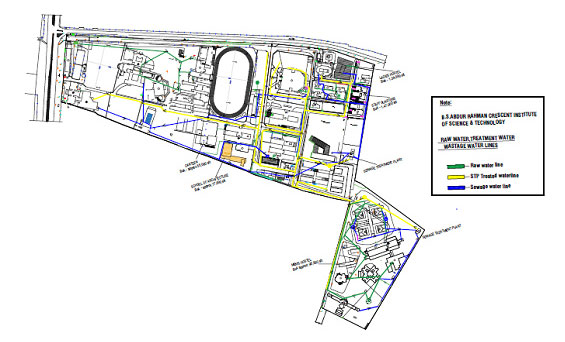
The colour indication is given in the pipes for easy identification
Green colour: Raw water from wells
Blue colour: Treated water from STP used for toilet flushing
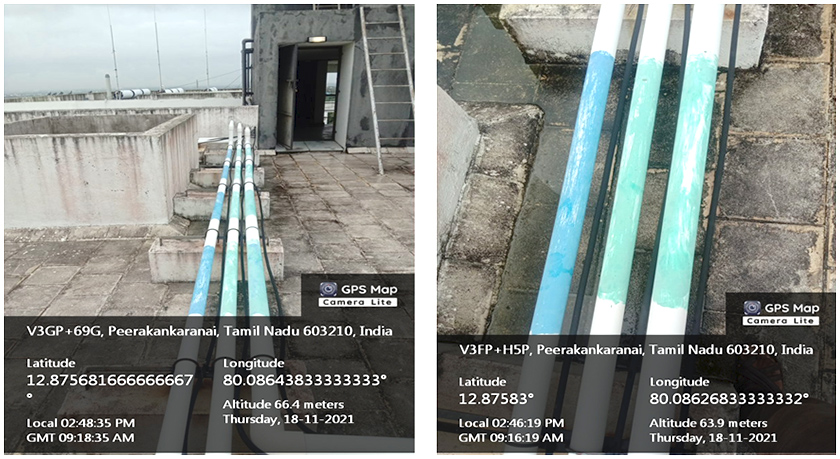
B.S.Adbur Rahman Crescent Institute of Science and Technology have implemented sufficient measures to prevent the water pollution caused by accidents and incidents at the university. The water system can also be contaminated due to the improper disposal of the solid waste. Especially the waste like plastics can clog the pipelines and affect the quality as well as the flow of the water.Institue has ensured that a proper solid waste management is in parctised and hence preventing the water pollution. Some of the processes practised in the Institute are given below
In order to avoid water pollution and enhance the solid waste management, the following preventive measures have been applied in the campus.
- Segregation of Garbage to be controlled and monitored at entry point i.e from major areas like Hostel and canteen
- Mimimisation of the waste throwing (plastic,papers& bottles ) to the dumbing yard.
- Height of garbe stocked is almost to the height compound wall to be restricted
- Clearing the entire gargabe from dumping yard very frequently
- Sewer connection to old bio gas plant should be diverted to STP by direct connections – Mixing of sewer and rainwater may be restricted.
- Closing all the holes contributing to the seepage of water from zoo and other neighbourhood all along the boundary of the Institute
- Frequent disposal of existing stoked waste (plastic,papers& bottles)
- Utilisation of the additional raw water storage tank during emergency time.

Academic Year 2020-21
EFFICIENT INFRASTRUCTURE FACILITY
B.S.Adbur Rahman Crescent Institute of Science and Technology have implemented sufficient measures to prevent the polluted water entering the water sources /water pipelines Some of the processes practised and provisions available in the Institute are given below
EFFICIENT INFRASTRUCTURE FACILITY FOR COLLECTION AND TREATMENT OF WATER AND WASTEWATER
In the Institute, the plumbing facility for collection of water from the well and subsequently transporting it for the treatment unit and also for supply has been meticulously planned and implemented. The pipes are laid at a suitable gradient and the water is transported safely . It is also ensured that there is no leakages in the water pipelines through frequent inspection. The water pipes are also subjected to an immediate replacement if there is any problem of breakage has occurred because of any accidents. Similary the wastewater collected from the various locations of the Instituion is conveyed in a separate sewer pipe lines.Sufficient manholes are provided at several junctions to conduct the inspection of the pipelines. The pumps and other valves placed in the sewer pipelines are also checked for its performance and it is maintained properly. The treated wastewater is also transported safely and used for flushing and gardening.
There are separate markings indicated in the plumbing lines for the easy identifications of water and sewer lines. These measures has helped the Institute the manage the wastewater generated in the premises and it is been prevented from entering the water pipelines or any other water sources.

The colour indication is given in the pipes for easy identification
Green colour: Raw water from wells
Blue colour: Treated water from STP used for toilet flushing

SOLID WASTE MANAGEMENT
B.S.Adbur Rahman Crescent Institute of Science and Technology have implemented sufficient measures to prevent the water pollution caused by accidents and incidents at the university. The water system can also be contaminated due to the improper disposal of the solid waste. Especially the waste like plastics can clog the pipelines and affect the quality as well as the flow of the water.Institue has ensured that a proper solid waste management is in parctised and hence preventing the water pollution. Some of the processes practised in the Institute are given below
SOLID WASTE MANAGEMENT IN THE CAMPUS
In order to avoid water pollution and enhance the solid waste management, the following preventive measures have been applied in the campus.
- Segregation of Garbage to be controlled and monitored at entry point i.e from major areas like Hostel and canteen
- Mimimisation of the waste throwing (plastic,papers& bottles ) to the dumbing yard.
- Height of garbe stocked is almost to the height compound wall to be restricted
- Clearing the entire gargabe from dumping yard very frequently
- Sewer connection to old bio gas plant should be diverted to STP by direct connections – Mixing of sewer and rainwater may be restricted.
- Closing all the holes contributing to the seepage of water from zoo and other neighbourhood all along the boundary of the Institute
- Frequent disposal of existing stoked waste (plastic,papers& bottles)
- Utilisation of the additional raw water storage tank during emergency time.
THE SEQUENCE OF SOLID WASTE MANAGEMENT PROCESS IN THE CAMPUS IS GIVEN BELOW

- B.S Abdur Rahman Crescent Institute of science and technology is one of the pioneers in implementing solutions to save water.
- The institute has implemented rain water harvesting system in the campus with a strong desire to utilize the rain water at maximum extent.
- The Institute has taken tremendous efforts to reduce the water consumption and also to treat the wastewater generated within the campus so that it can be effectively reused for gardening and toilet flushing.
- In the forefront to save water, our institute of science and technology has initiated and executed the rainwater harvesting in the campus.
- Rainwater harvesting facility is done in all blocks to collect rainwater from the roof of all buildings.
- The harvested water is diverted to open wells in institute campus, Men’s Hostel and ladies hostel.
- The placement of rainwater facility within the campus is decided upon by considering the profile of the land so as to drain the maximum amount of water collected with ease.
- In the buildings, sufficient plumbing connections are provided to trap the rain water from the roof tops.
- Underground connections are ensured to connect the collected water from the roof top to the rainwater recharge pit.
- It was also ensured that the rainwater harvesting structures are constructed as per the norms. The recharge pit provided to collect the rain water is series of filter bed.
- This initiative took shape when the institute faced shortage of water during summer. Cost of buying water was becoming a financial burden. The only alternative to the water crisis was to use the available water more effectively.
- The features of the recharge pit are described below.
- A mesh is provided at the inlets of rain water pipes so that solid waste/debris is prevented B.S.Abdur Rahman Crescent Institute of Science and Technology has taken initiatives to install rain water harvesting pits in the campus from entering the pit system.
- The recharge pits are of size 2m x 2m x 2m is excavated
- The recharge pit comprises different set of filter media. The filter media comprises of thick layers of boulders at the bottom followed by layers of gravels and coarse sand.
- This enables the filtration of water and also prevents the deposition of silt on the recharge pit.
- Access Manhole frames and covers are provided.
- The rain water is also stored in Underground sumps of Life Science block, Mechanical Science Block and New Staff Quarters.
RAIN WATER HARVESTING STRUCTURES AND UTILIZATION IN THE CAMPUS
B.S. Abdur Rahman Crescent Institute of Science and Technology has taken initiatives to install rain water harvesting pits in the campus.
Rain Water Harvesting
Rainwater harvesting facility is done in all blocks to collect rain water from the terrace. The harvested water is diverted to open wells in institute campus, Men’s Hostel and ladies hostel. The rain water is also stored in Underground sumps of Life Science block, Mechanical Science Block and New Staff Quarters. The rain water is stored after passing through the pre-filter as shown in Figure below.
| S.No | CAMPUS/BLOCKS | Number of Rain Water Harvesting | Quantity of Water Collected(L) |
|---|---|---|---|
| 1 | College/Life Sciences Block | 1 | 10000(Approx) |
| 2 | New Architecture Block | 1 | 10000 (Approx) |
| 3 | Computer Science block | 1 | 10000 (Approx) |
| 4 | Pharmacy Block | 1 | 10000 (Approx) |

The special features of the filtration unit connected with the rain water harvesting system is given as follow
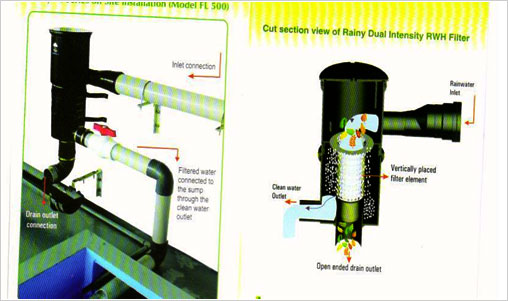
Special Features:
- Dual Intensity Filter works on the principle of cohesive & centrifugal force.
- Works on Gravitational force (No external energy required)
- Compact in size and wall mounted
- Automatic flush out of dirt particles
- Flexibility in pipe connection to any angle and degree
- Provision of bypass valve
In our Institute Rainy filter –FL 500 is used as part of the rainwater harvesting system. The technical specifications of Model FL 500 is given below
Rainy Filter – FL 500
Technical Specifications & Parameters of Model FL 500
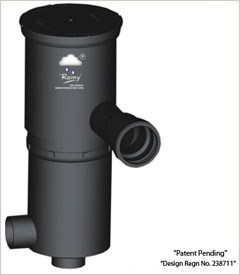 | Suitable up to area: | 500 SQMTRS |
| Max: Intensity of Rainfall: | 75 mm/hr | |
| Working Principle : | Cohesive Force & Centrifugal force | |
| Operating Pressure: | Less than 2 feet of head (0.060kg/cm2) | |
| Capacity: | 480 LPM | |
| Filter Element: | SS-304 Screen | |
| Mesh Size: | 250 Microns | |
| Inlet: | 110 MM | |
| Clean Water Outlet: | 90 MM | |
| Drain Outlet: | 110 MM | |
| Housing: | High Density Polyethylene | |
| Efficiency of Filter: | Above 90% | |
| Source of Power: | Gravity |
The characteristic features of FL Series Dual Intensity RWH Filter are its capacity to take up the load up to 10 to 500 square meters of Roof area with variable intensity of rainfall of 5 to 75 mm/ hour with a discharge capacity of 10 To 480 Liters per minute.
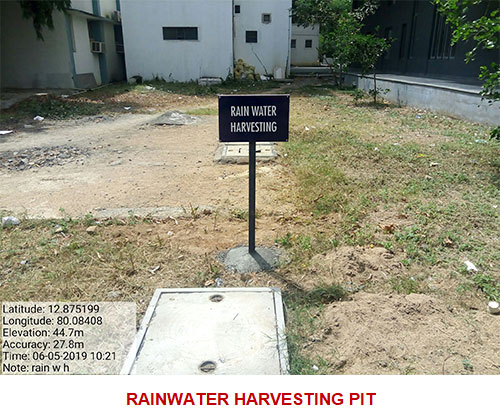
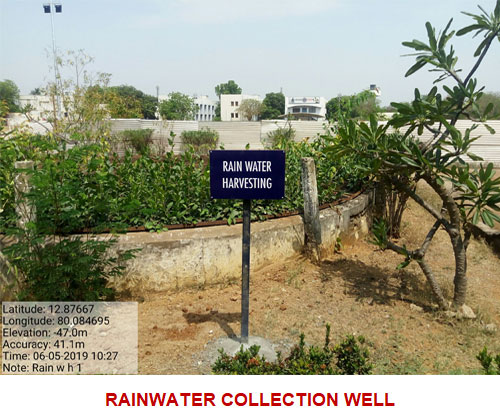
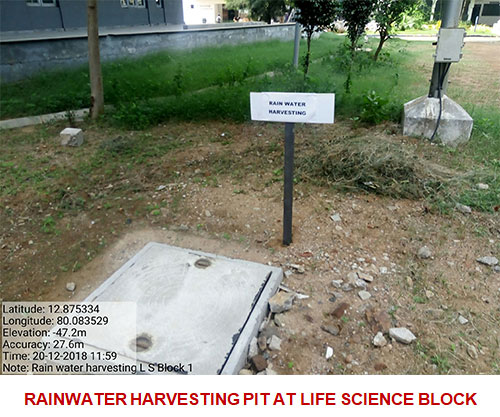
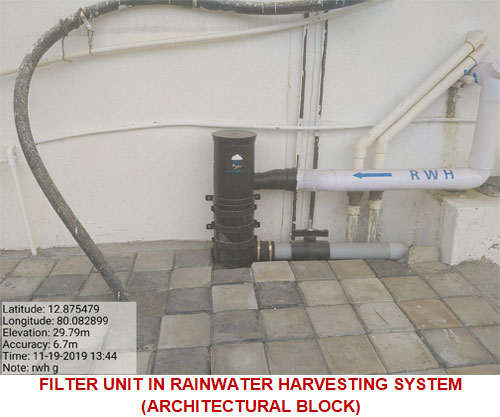
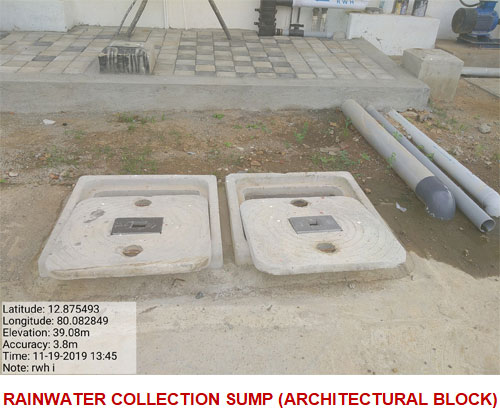

Rain Water Harvesting Details
| S.No | Inlet Pit Detail | Area (sq. m) | Rain water filter capacity ( Litres) | Location |
|---|---|---|---|---|
| 1 | Inlet pit-1 | 156 | 200 | Mechanical Science Block |
| Inlet pit-2 | 122 | 200 | ||
| Inlet pit-3 | 296 | 300 | ||
| Inlet pit-4 | 175 | 200 | ||
| Inlet pit-5 | 243 | 300 | ||
| 2 | Inlet pit-1 | 191 | 200 | Ladies Hostel-New Block |
| Inlet pit-2 | 188 | 200 | ||
| Inlet pit-3 | 132 | 200 | ||
| 3 | Inlet pit-1 | 68 | 100 | New Staff quarters |
| Inlet pit-2 | 65 | 100 | ||
| Inlet pit-3 | 81 | 100 | ||
| Inlet pit-4 | 66 | 100 | ||
| Inlet pit-5 | 81 | 100 | ||
| Inlet pit-6 | 66 | 100 | ||
| 4 | Inlet pit-1 | 61 | 100 | Men’s Hostel-A&B BLOCK |
| Inlet pit-2 | 71 | 100 | ||
| Inlet pit-3 | 43 | 100 | ||
| Inlet pit-4 | 132 | 200 | ||
| Inlet pit-5 | 132 | 200 | ||
| Inlet pit-6 | 43 | 100 | ||
| Inlet pit-7 | 71 | 100 | ||
| Inlet pit-8 | 61 | 100 | ||
| 5 | Inlet pit-1 | 297 | 300 | Men’s Hostel -C& D BLOCK |
| Inlet pit-2 | 297 | 300 | ||
| 6 | Inlet pit-1 | 71 | 100 | Men’s Hostel -PG BLOCK |
| Inlet pit-2 | 71 | 100 | ||
| Inlet pit-3 | 71 | 100 | ||
| Inlet pit-4 | 71 | 100 | ||
| Inlet pit-5 | 71 | 100 | ||
| Inlet pit-6 | 71 | 100 | ||
| Inlet pit-7 | 71 | 100 | ||
| Inlet pit-8 | 71 | 100 | ||
| 7 | Inlet pit-1 | 275 | 300 | Pharmacy Block |
| 8 | Inlet pit-1 | 340 | 300 | Library Block |
BSA Crescent Institute of Science and Technology has Reverse Osmosis (RO) Plant to provide Free drinking water to the college and hostel. The entire college campus is facilitated with pure Reverse Osmosis (RO) drinking water with Water Dispensers in every block to cater to the need of pure and safe drinking water to all for free. We have 44,500 liters / day RO systems installed in the campus and water dispensers are available in each floor in every building. Our water treatment plants provide safe drinking water at every tap on the campus. A high level of maintenance attention and regular testing ensure the quality of the water. Water treatment plant with reverse osmosis technology is available to provide quality drinking water.
| S.No | Building name | Number of water Dispensers | Number of RO units | Total capacity (in Ltrs) |
|---|---|---|---|---|
| 1 | Electrical Science Block | 4 | 4 | 320 |
| 2 | Crescent Business School | 4 | 4 | 320 |
| 3 | Architecture Block | 5 | 5 | 200 |
| 4 | Science Block | 4 | 4 | 320 |
| 5 | Basic science block | 1 | 1 | 80 |
| 6 | Mechanical block | 4 | 4 | 180 |
| 7 | Life Science block | 8 | 8 | 340 |
| 8 | Main canteen | 3 | 3 | 180 |
| 9 | Men’s hostel A Block | 4 | 4 | 320 |
| 10 | Men’s Hostel B block | 5 | 5 | 320 |
| 11 | Men’s Hostel C block | 3 | 3 | 120 |
| 12 | Men’s Hostel D block | 5 | 5 | 320 |
| 13 | Men’s Hostel Masque | 1 | 1 | 80 |
| 14 | Ladies hostel A Block | 3 | 3 | 240 |
| 15 | Ladies hostel B Block | 3 | 3 | 240 |
| 16 | Ladies hostel C Block | 7 | 7 | 320 |
| Total | 64 | 3900 |
 |  |  |
 |  |  |
 |  |  |
 |  |  |
 |


Academic Year 2020-21
POTABLE WATER SUPPLY
BSA Crescent Institute of Science and Technology has Reverse Osmosis (RO) Plant to provide drinking water to the college and hostel. The entire college campus is facilitated with pure Reverse Osmosis (RO) drinking water with water coolers in every block to cater to the need of pure and safe drinking water to all. We have 44,500 liters / day RO systems installed in the campus and water dispensers are available in each floor in every building. Our water treatment plants provide safe drinking water at every tap on the campus. A high level of maintenance attention and regular testing ensure the quality of the water. Water treatment plant with reverse osmosis technology is available to provide quality drinking water.
| S.No | Location | Capacity Liters/Hr | Working Hours Per day | Qty. of Treated Water in liters |
|---|---|---|---|---|
| 1 | University Main Plant-Near to Main block | 1500 | 6 | 9000 |
| 2 | Science Block Terrace | 1000 | 5 | 5000 |
| 3 | Ladies Hostel New block Terrace | 500 | 5 | 2500 |
| 4 | Men’s Hostel Dining Hall | 2000 | 4 | 8000 |
| 5 | Men’s Hostel Service block | 2000 | 5 | 10000 |
| 6 | Aeronautical Block terrace | 500 | 2 | 1000 |
| 7 | Life Sciences block terrace | 500 | 2 | 1000 |
| 8 | New architecture terrace | 2000 | 4 | 8000 |
| Total treated Water | 10000 | 44500 | ||
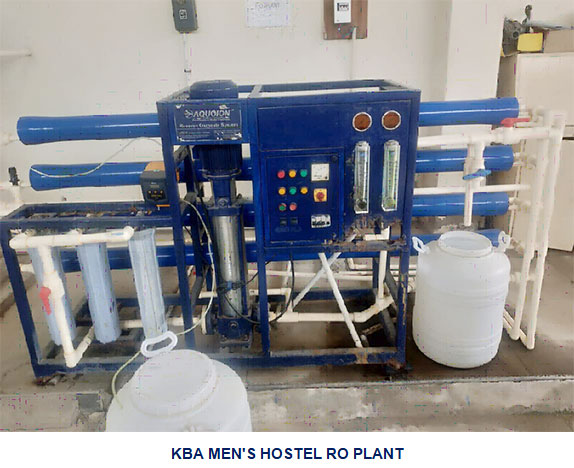

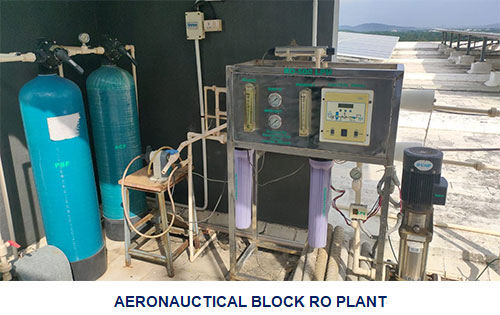
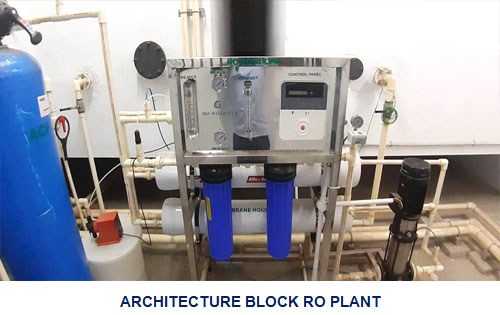
The below submitted water sample complies with acceptable limits of drinking water specification as per IS 10500:2012 with respect to the below tests.
Ref. Decision Rule: EES/QSP/012
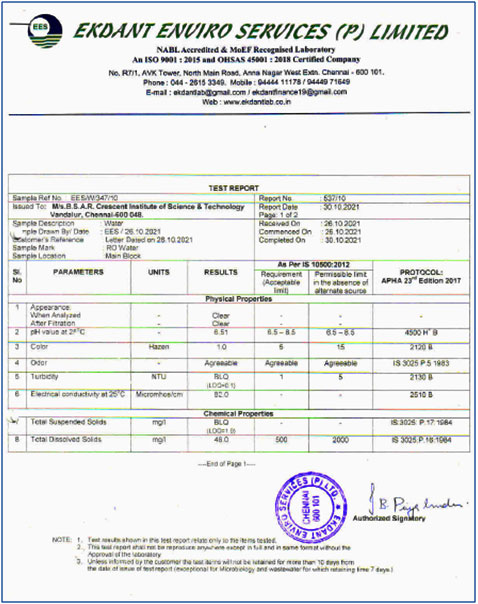

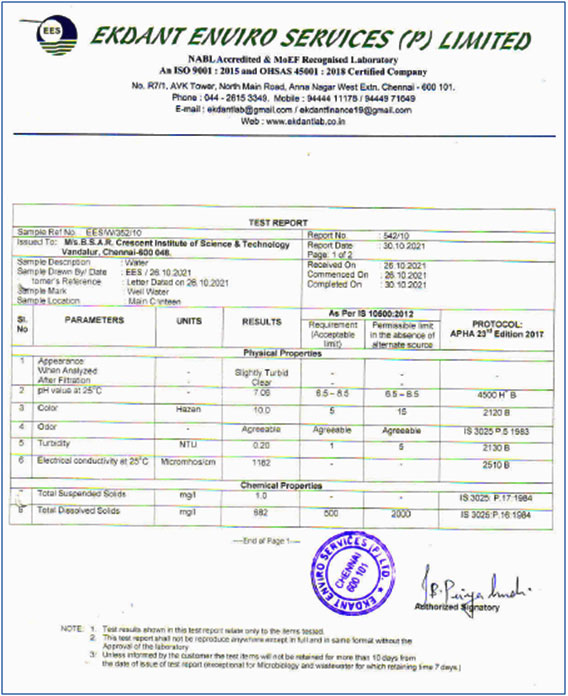
POU WATER COOLERS-WATER DISPENSER
Institution Water Dispensers are the Point-of-Use (POU) water dispenser that equips with hot and cold system to directly connect to RO feed water. The POU water coolers are user-friendly and environmentally-friendly, it helps to decrease the waste of plastic water bottles and is a great choice to replace bottled water and bottled water coolers.
Water dispensers can be directly connected to the in-house RO treated water source for continuous dispensing of hot and cold drinking water. POU units are generally more hygienic than bottled water coolers, provided the students has access to clean water sources.
Moreover, these advanced dispensers is plumbed directly into your existing RO water line – so employees, guests, and students can enjoy an endless supply of filtered drinking water whenever they need it.
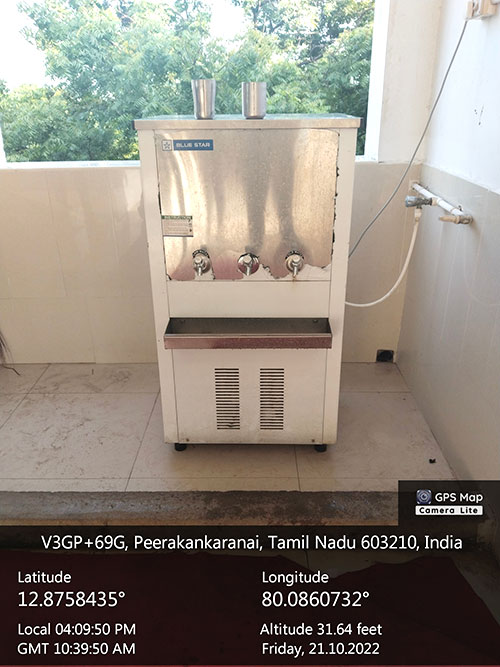
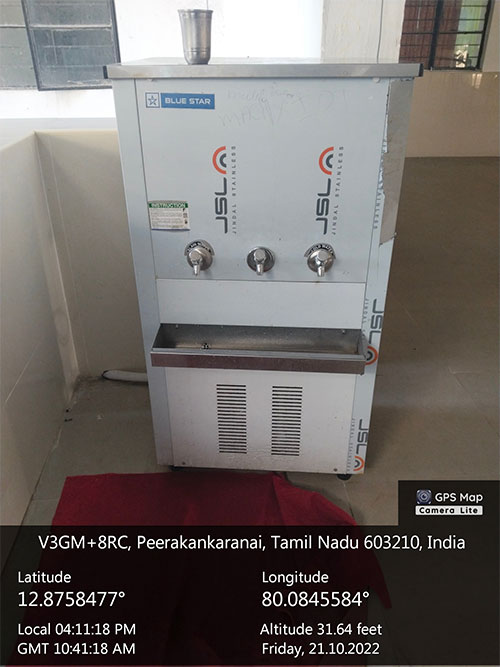
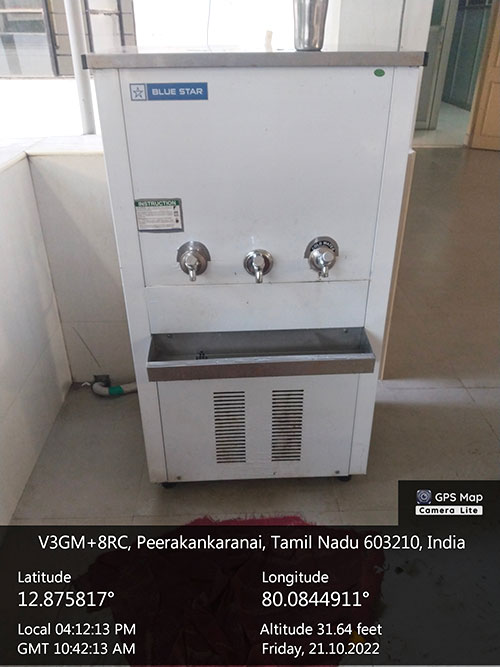
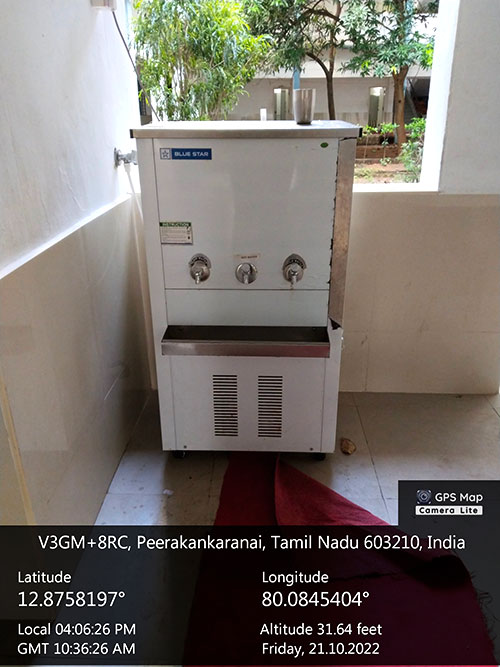
| S. No. | Name of the Building | Indian Standards |
|---|---|---|
| 01 | Extension of Mechanical Block | Loading Standards as per BIS-875, Seismic Force as per BIS-1893 and BIS – 456 https://www.bis.gov.in/ https://standardsbis.bsbedge.com/ https://www.bis.gov.in/standards/technical-department/national-building-code/ |
| 02 | Aeronautical Block | |
| 03 | Staff Quarters | |
| 04 | Ladies Hostel |
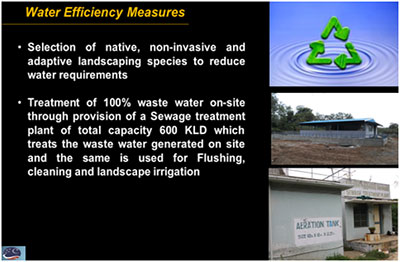
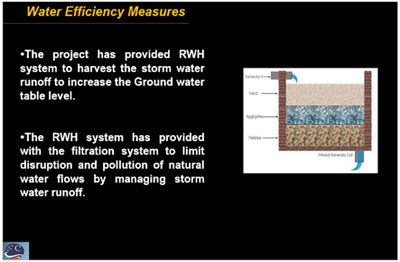
| Green Buildings & Certification | |
|---|---|
| 1 | All existing buildings are registered with Indian Green Building Council (IGBC) for green building certification under IGBC – EB rating |
| 2 | New buildings are constructed over the last six years and those under construction are registered with GBCI EDGE and USGBC LEED for green building certification for Gold rating. |
| 3 | GBCI-EDGE Green building certification received for New Ladies Hostel & New staff quarters on 23.04.2018. |
| 4 | Crescent School of Architecture block is conceived as a Net Zero Energy building and registered under USGBC-LEED for Gold rating certification. |
Sustainable and eco-friendly campus development has been adopted with following materials
- Grass Crete: Method of laying Grass paver flooring, walkways, sidewalks and driveways to improve storm water absorption and drainage
- Ash Crete: Fly ash (recycled) content with cement is being used for all Reinforced Cement concrete works.
- Low – VOC paints: Painting with low VOC less than 50gm/liter is using for all painting works – Nippon and Berger
- Engineered wood: MDF (Medium Densified Fibre) wood used for interior partition, doors and furniture’s.
- Structural Insulated Panels (SIP): Foam board wall panels are used for prefab structures such as class room and indoor game space.
- Insulated Concrete Forms: GFRC Technology being adopted to construct parent waiting guest rooms and essential staff quarters.
- Steel: Steel roof panels (recyclable) used for workshop roofing.
- Composites: Roof panels made of composite materials such as foam sandwiched between two metal sheets used for prefab class room ceiling.
- Fibreglass:Fibreglass is also used in insulation in the form of Fibreglass batts for interior partition works.
- AAC Blocks: Autoclaved Aerated Concrete blocks (non- toxic product) are used for the construction of all buildings to reduce low environmental impact.
- Thermatek Roof tile: Heat Resistant Terrace tiles are used for all buildings.
- VAV system: Variable air volume HVAC system is adopted to reduce energy consumption
# GST Road, Vandalur, Chennai 600 048. Tamilnadu. INDIA
28 & 29 DECEMBER 2021
RAM-KALAM CENTRE FOR ENERGY CONSULTANCY AND TRAINING
(Chennai, Coimbatore, Erode)
Mobile: +91- 80567 19372, 99420 14544 (Whatsapp) E-mail: ramkalamcect@gmail.com
A. Description of Environment, Green & Water Audit Process
- Environment, Green & Water Audit is essentially a management tool for measuring the effects and impacts of activities undertaken in the university campus on environment more particularly atmospheric air, Soil and Water.
- Primarily analyse the utilization of all types of energy, assessment of environmental condition, estimation of annual CO2 emission from all the defined activities and mapping with campus greenery system.
- Also it keeps the university accountable by examining their practices and determining what measures need to be implemented in order to maintain the sustainability
B. Scope of the Audit
- Identification of history of activities, present environmental practices followed, monitoring records and known sources of environmental issues inside the university
- Adoption of natural resources as input (such as energy and water), processing and utilization and generation of wastes (including hazardous and toxic),
- Handling and storage of all types of wastes (Solid, liquid and gas), transportation of waste from source to yard, reuse and recycling possibilities, storage mechanism and effective disposal
- Measurement of effectiveness of pollution control (air, water and soil pollution), maintenance logs, emission test reports and routine analytical reports.
- Judicious usage of water, effective water distribution network, maintaining best system efficiency and usage of water saving equipments/methods/standards.
- Providing constant awareness to all stakeholders on Environment impacts, risk analysis and Ecology.
C. Outcomes of the Audit Process
- Use as a basis for the development of environmental management policies or efforts to improve the existing plants.
- Identification of possible cost and energy saving from energy conservation, waste reduction, reuse and recycling.
- Development of rule based system to become a sustainable environment inside the university campus and nurture the importance of less energy and less environmental impacts.
- Formation of methodology for long term road map for maintaining green environment within the campus and encourage the stakeholders for continuous improvements.
D. Focus Areas in the Audit Process
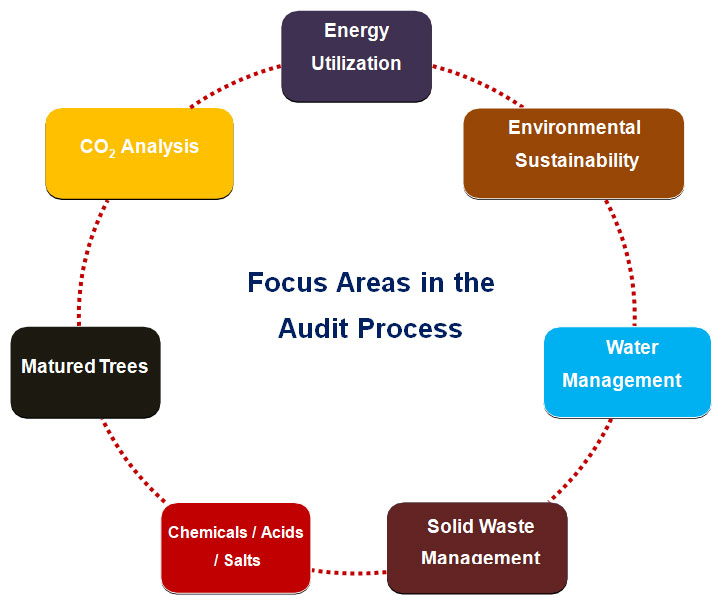
E. Audit Coverage
| ENVIRONMENTAL AUDIT | |
|---|---|
| Chemical/Salt/Acid Usage Study | Analysis of chemical/Salt/Acid Usage in different laboratories, method of storage and dilution, application of chemicals, method of disposal. |
| Transport system | Examination of no. of vehicles, make and model, fuel used, pollution certificates and best operating practices followed to conserve fuel. |
| Air, Water & Soil Quality | Assessment on indoor and ambient air atmosphere, Review of water quality, Codes and Standards followed in testing of water & soil. |
| Bio-gas Generation | Capacity, location, collection of food and vegetable wastes, storage tank, gas distribution, utilization and reduction of LPG. |
| GREEN AUDIT | |
| Roof top Solar PV Plants | Assessment of solar PV plants, capacity, location, yearly energy generation, inverter capacity, energy utilization and common connection in MV panel, panel cleaning methods, schedule and dedicated earthing system. |
| Solar Thermal System | Inspection of solar hot water generation for bathing in hostel area, capacity, input water and hot water distribution. |
| Campus Greenery | Assessment of no. of matured trees, location, botanical names, amount of CO2 reduction. |
| WATER AUDIT | |
| Water distribution system | Incoming raw water, water purification system (RO), potable water distribution and water conservation measures |
| Water distribution for general utilities (cooking and bathing), taps and control values, water distribution for hostel and best practices in water distribution. | |
| Rain Water Harvesting | Assessment of RWH, capacity and location, bore-well pit recharge, open ended water storage and utilization and study on ground water improvement. |
| Sewage Treatment Plant (Liquid Waste Management) | Sewage collection, storage and treatment, capacity, type of aerator, collection and distribution tank, treated water usage (gardening and toilet flushing) and sludge collection and usage. |
F. Standards Adopted
- Bureau of Energy Efficiency (BEE) Guidelines to conduct the detailed energy audit process
- ISO 14064-Part-1 – Specification with guidance at the organization level for quantification and reporting of GHG emissions and removals (Second Edition)
- ISO 14064-Part-2 – Specification with guidance at the project level for quantification, monitoring and reporting of GHG emissions reductions or removal enhancement (Second Edition-2019)
- ISO 14064-Part-3 – Specification with guidance for the verification and validation of GHG statements (Second Edition-2019)
- The Greenhouse Gas Protocol – A Corporate Accounting and Reporting Standard (Revised Edition) released by World Resources Institute & World Business Council for Sustainable Development – 2014
- Ministry of Environment, Forest and Climate Change Notification on “Battery Waste Management Rules, 2020” & “E-Waste (Management) Rules, 2016”, & “Solid Waste Management Rules, 2015”
- Ministry of Jal Shakthi, Guidelines to regulate and control Ground Water Extraction in India and Other Water related Standards
G. Summary & Recommendations of the Audit Process:
In order to make the B.S. Abdur Rahman Crescent Institute of Science & Technology campus 100 % Environmental sustainability and lush Greenery; the audit team recommends to implement the following measures:
G-I: Environmental Management
- Properly follow scientific method of handling chemicals/Acids/Salts and safe disposal through 3rd party
- Plan for BS-IV vehicles in future
- It is recommended to use natural ingredients like orange peel extract & vinegar
- Indoor Environment Quality (IEQ) refers to the environmental condition inside a building which is influenced by i) Thermal comfort, ii) Lighting comfort, iii) Acoustic comfort and iv) Indoor Air quality (IAQ). The audit team recommends to conduct the IEQ audits and confirm each building comfort level.
G-2: Green Campus Management
- B.S. Abdur Rahman Crescent Institute of Science & Technology campus is blessed with more varieties of resident birds (species always living inside the campus) and amphibians (Amphibians are small vertebrates that need water, or a moist environment, to survive).
- Bird Sighting and Survey: Conduct a dedicated bird sighting and identify the list of birds both residing birds and migratory birds available in the college campus
- Reptile & Amphibian survey: Similar to bird survey; conduct a survey to list the amphibians available in the campus
- One Student – One Tree: This is an Initiative of AICTE to increase the green coverage inside the campus and committed to reduce the Urban Heat Island Effect (UHIE), college may plan to plant nearly 2,000 trees in future, make the entire campus with complete green cover and maintain an excellent bio-diversity
- Indoor plants: Not only looks beautiful, but also brings life to our living space. They also help purify the air. According to a study of NASA even a small plant inside the workspace can help remove at least three household toxins (think benzene, formaldehyde, and trichloroethylene, which are carcinogenic chemicals commonly found in stagnant indoor environments)
G-3: Waste Management
- Cotton, Syringe, Needles are to be kept separately as these are treated as Bio-Medical wastes
- Yellow dust bins must be placed to collect these bio-medical wastes
- After COVID; mask, sanitizer bottles, gloves and other medical items must be trashed only through the yellow bins
- This must be informed to all the students and stakeholders. Suitable steps have to be taken to disseminate this information
- All the solid wastes are to be properly stored in a separate place and should be maintained as a record mentioning its quantity
- The food waste must be weighted and marked in a record before keeping into the digester unit. This must be checked with the amount of gas generated using suitable calculation and check with the designed output
- Any waste items given to trust office or to the 3rdparty must have a record of the respective department
- Reduction of Paper: Workout a policy to move towards paperless office. Present system of paper usage may be reviewed and wherever possible; digitalize the activities and reduce the paper
- Adopt College Management System (CMS) and try to automate
- Automation saves energy, saves man power, saves paper, leads to better transparency, efficient man power utilization and thus saves cost
G-4: Water Conservation & Management
- Utilize more amount of treated water from STP plant since most of the approving agencies like AICTE, UGC etc., are now requesting to utilize the treated water
- To check the quantity of water utilized by each buildings by connecting digital water flow meter and optimize the water usage
- Similar to raw water measurement; water inlet to the STP & treated STP water pipe line must be fitted with flow meter and check the quantity of inlet & outlet water
- Prepare and maintain a Single Line Diagram (SLD) for water distribution network
- Try to reduce water tapped from the ground water source since it is not environmental friendly
- Paste water and energy saving slogans at appropriate places
- Generate your own power and water for regular activities and move towards Net Zero Energy and Net Zero Water Building
- Retrofit aerator based water taps for good water savings. For hand washing applications, all the pipes must be fitted with aerators
- In future; install Bio-Sewage Treatment Plant as it reduces the amount of energy required to operate the plant and environmental friendly operation
- Captures almost 100 % rain water harvesting through i) Recharging pits and ii) Open well type storage pits
- Water treatment log must be maintained indicating the water inlet, treated and outlet water quantity
- Install sensor based water controller in each Over Head Tanks and reduce the water waste and power required to operate the pump
- Energy required to process the water treatment must be calculated
- Overall cost of treated water by accounting i) consumables, ii) manpower iii) energy and iv) other conventional expenses
- Also it is highly recommended to use the treated STP water for toilet flushing system as this is much essential for the AICTE, UGC norms of treated water usage
- Display the specifications of the STP (Like RWH display)
- Use the treated water at the maximum in whatever possible areas and try to minimize the fresh water intake (from any source)
- Set a policy and fix a target for usage of treated water; ensure that the plan is being executed without any deviation. Increase the percentage of usage of treated water year by year
- With the advent of smart technologies, it is possible to have centralized monitoring in real-time using internet of things (IoT), Geographic Information System (GIS) software etc. as per Jal Jeevan Mission, Department of Drinking Water and Sanitation , Ministry of Jal Sakthi
- In hostel building; try to introduce “Emergency Water Line” during day time (usually from 9.00 AM to 4.00 pm). The gate valve of the common line is closed during that time and hence water wastage is avoided in the knowingly or unknowingly opened taps
- Introduce power wash floor cleaning mechanism which removes the stains easily with reduced water usage
- Awareness campus must be conducted to all the stakeholders at regular interval. Thorough this initiative; Painting, Photography, Slogan and Poster making contest are conducted to create consciousness among the students and the faculties.
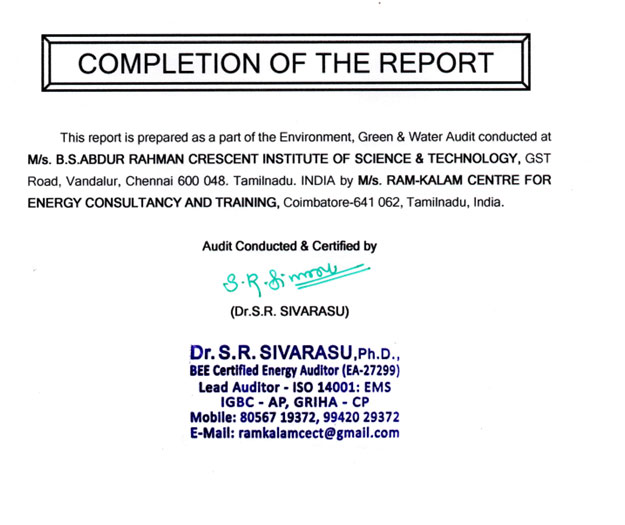

The B.S. Abdur Rahman Crescent Institute of Science and Technology, located in Chennai, has prepared students in India to pursue careers in engineering, science and technology for over 32 years. In addition to inspiring innovation among its students, the university has also chosen to improve its campus by adding green buildings. The new women’s residences and staff quarters have many green features that have all been implemented at no additional cost to the university. When utility bills are taken into consideration, the result is a positive sum gain.
The university has many green features such as solar hot water collectors and energy-saving lighting systems to reduce energy consumption, and UPVC windows to reduce embodied energy in materials. Located in a region that experiences frequent droughts and shortages of water, the university can also conserve its supply of water with the help of low-flow showerheads and faucets and dual flush water closets. The university hopes to use EDGE for future buildings on the campus, to further its resource-efficient and environmentally-friendly approach.
The B.S. Abdur Rahman Crescent Institute has received final EDGE certification from GBCI India.
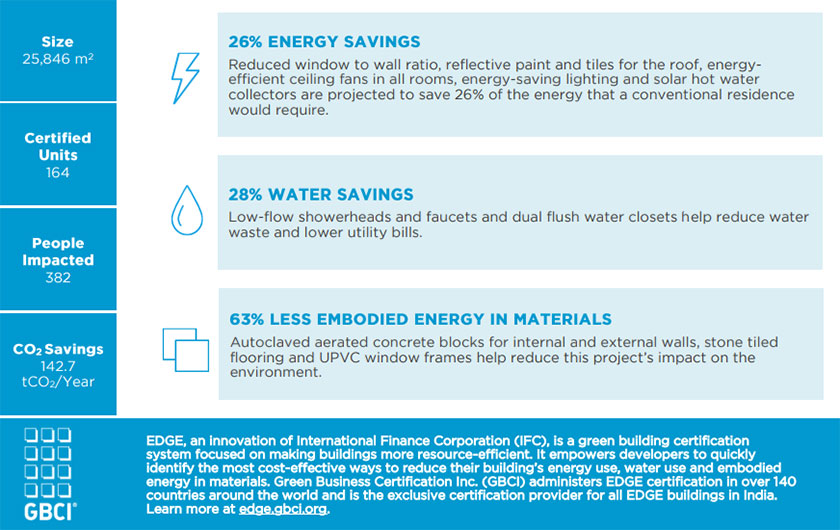
BSA Staff Quarters & Ladies Hostel – Hostel Block – GBCI EDGE Project Study
BSA Staff Quarters and Ladies Hostel – EDGE Details

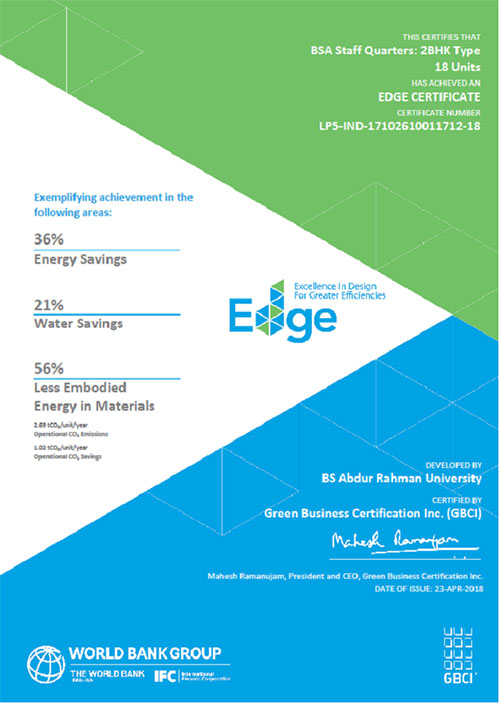

Academic Year 2020-21

The B.S. Abdur Rahman Crescent Institute of Science and Technology, located in Chennai, has prepared students in India to pursue careers in engineering, science and technology for over 32 years. In addition to inspiring innovation among its students, the university has also chosen to improve its campus by adding green buildings. The new women’s residences and staff quarters have many green features that have all been implemented at no additional cost to the university. When utility bills are taken into consideration, the result is a positive sum gain.
The university has many green features such as solar hot water collectors and energy-saving lighting systems to reduce energy consumption, and UPVC windows to reduce embodied energy in materials. Located in a region that experiences frequent droughts and shortages of water, the university can also conserve its supply of water with the help of low-flow showerheads and faucets and dual flush water closets. The university hopes to use EDGE for future buildings on the campus, to further its resource-efficient and environmentally-friendly approach.
The B.S. Abdur Rahman Crescent Institute has received final EDGE certification from GBCI India.

BSA Staff Quarters & Ladies Hostel – Hostel Block – GBCI EDGE Project Study
BSA Staff Quarters and Ladies Hostel – EDGE Details



The entire campus of B.S. Abdur Rahman Crescent Institute of Science and Technology is adorned with well-maintained trees, plants, and lawns. The green cover on the campus is estimated to be around 30%. The total built-up area of the campus is 1,618,024 square feet, while the landscape occupies 656,876 square feet.”
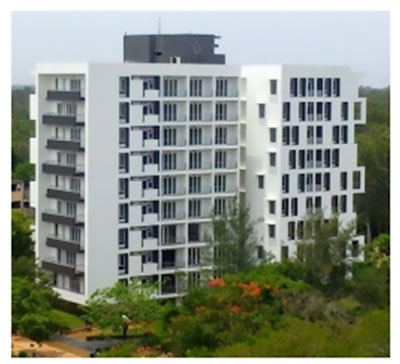
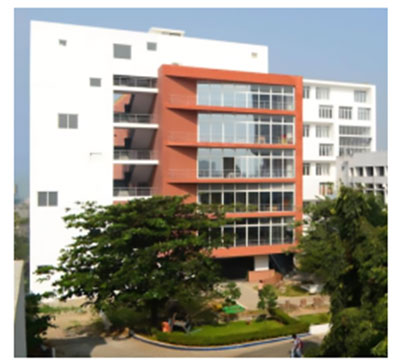
School of Mechanical Sciences
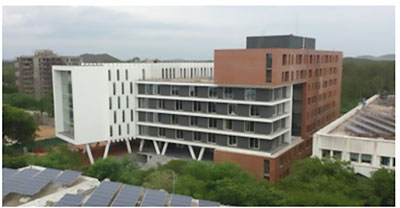
Institute Entrance Pathway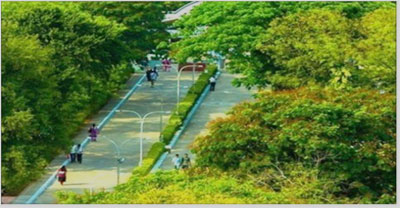
In December 2016, B.S. Abdur Rahman Crescent Institute of Science and Technology had 909 trees. Unfortunately, a total of 341 trees were uprooted during the cyclone. As of now, the campus boasts approximately 3094 trees. Additionally, an organic vegetable garden has been established in the open land space near the Men’s Hostel area.
Bougainvillea “The presence of drought-tolerant Bougainvillea at B.S. Abdur Rahman Crescent Institute of Science and Technology makes it a superb option for regions with arid climates and restricted water availability.” |  |
Aloe veraAloe vera plants have their origins in desert-like settings characterized by hot weather and sandy soil. As a result, they flourish in arid, warm climates and exhibit limited tolerance to over-watering. |  |
Ash Guard -Benincasa pruriensAsh gourds are easy-to-care-for plants that require minimal fertilizer. Moreover, they exhibit drought tolerance, necessitating watering only once every 5-6 days in dry spells. Initially, male flowers bloom, succeeded by the appearance of female flowers |  |
Tecoma stans“The plant belongs to the Bigoniaceae family, also known as the Trumpet Creeper Family, which predominantly consists of tropical trees or shrubs. It is also referred to by various common names such as Esperanza (meaning ‘hope’ in Spanish), Trumpet Flower, Yellow Bells, Yellow Elder, Yellow Trumpet Flower, and Yellow Bignonia.” |  |
Calotropis giganteaThey are commonly known as milkweeds because of the latex they produce. Calotropis species are considered common weeds in some parts of the world. The flowers are fragrant and are often used in making floral tassels. Fibers of these plants are called madar or mader. Calotropis species are usually found in abandoned farmland. |  |
Bamboo Plants“Bamboo initially requires a generous amount of water to initiate growth. However, once the rhizome root system becomes established, bamboo can thrive with minimal irrigation. While certain varieties may have higher water needs than others, there are specific species of bamboo known for their impressive drought tolerance. |  |
Oleander

Moringa

Terminalia catappa

Eucalyptus Globulus

Academic Year 2020-21
B.S.Abdur Rahman Crescent Institute of Science and Technolgy has always taken intaitves to develop a good landscape in the campus. The Institue has more than 30 varieties of trees planted across the campus. The Institute has also focused on to plant trees to minimise water usage.

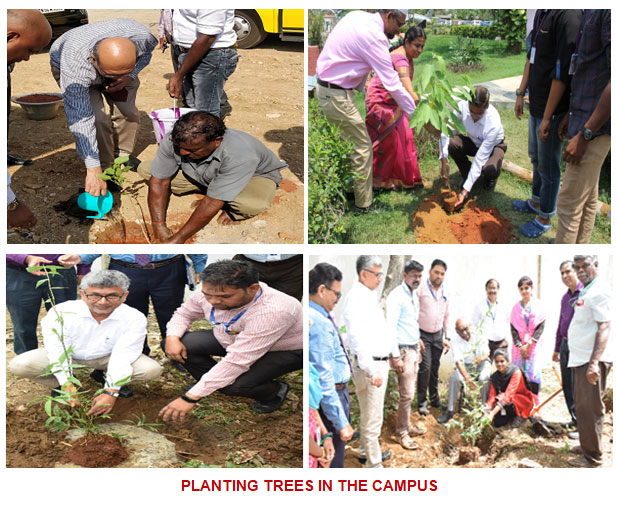
OXYZONE CAMPUS – BEEMA BAMBOO PLANTATION
Bamboo plants are effective for conserving water due to their culms ability in keeping water for a long period and maintain underground water flow. It also gives contribution to natural system such as oil erosion control, water conservation, land rehabilitation, and carbon sequestration.
The Institute has planted bamboo saplings for 5000 sft run area throughout our compound to absorb dust, reduce CO2 , to release more oxygen and to create pollution free environment. In future, the upcoming Central bus stand in vandalur is expected to produce lot of pollution inside the campus. Hence by planting bamboo, the campus will be dust free zone with good oxygen supply.The Institute has provided first OXYZONE inside the campus. Beema Bamboo Plants 2000 Nos are planted in whole campus for CO2 reduction.
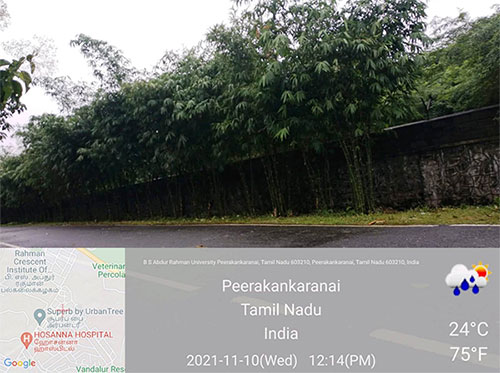
OXY PARK
The Institue is the proud owner of “Tissue culture bamboo plant” of variety “ BEEMA”. This is one of the super bamboo, Every plant generates over 300 kh of oxygen every year which is sufficient for one person for a year. These plants are also contribute to water conservation . Oxy Park is created in the campus opposite to Convention Centre
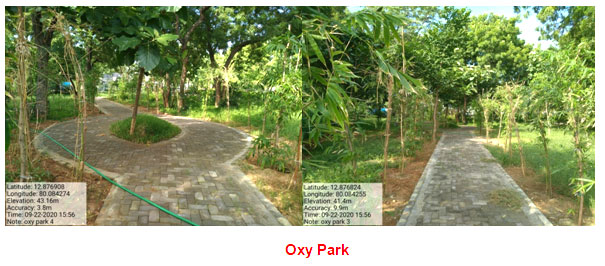


(Powered by Google Maps)

Responsible Executive: Director (IQAC)
Responsible Office: Internal Quality Assurance Cell, Estate Office, and SDG Cell
Contacts: Registrar, Director (IQAC)
6.1 STATEMENT OF POLICY
- Achieve universal and equitable access to safe and affordable drinking water for all
- Achieve access to adequate and equitable sanitation and hygiene for all and end open defecation, paying special attention to the needs of women and girls and those in vulnerable situations
- Improve water quality by reducing pollution, eliminating dumping and minimizing release of hazardous chemicals and materials, halving the proportion of untreated wastewater and substantially increasing recycling and safe reuse globally
- Substantially increase water-use efficiency across all sectors and ensure sustainable withdrawals and supply of freshwater to address water scarcity and substantially reduce the number of people suffering from water scarcity
- Implement integrated water resources management at all levels, including through transboundary cooperation as appropriate
- Protect and restore water-related ecosystems, including mountains, forests, wetlands, rivers, aquifers and lakes
- Expand international cooperation and capacity-building support to developing countries in water- and sanitation-related activities and programmes, including water harvesting, desalination, water efficiency, wastewater treatment, recycling and reuse technologies
- Support and strengthen the participation of local communities in improving water and sanitation management
Promotion / Implementation of Water Reuse Policy
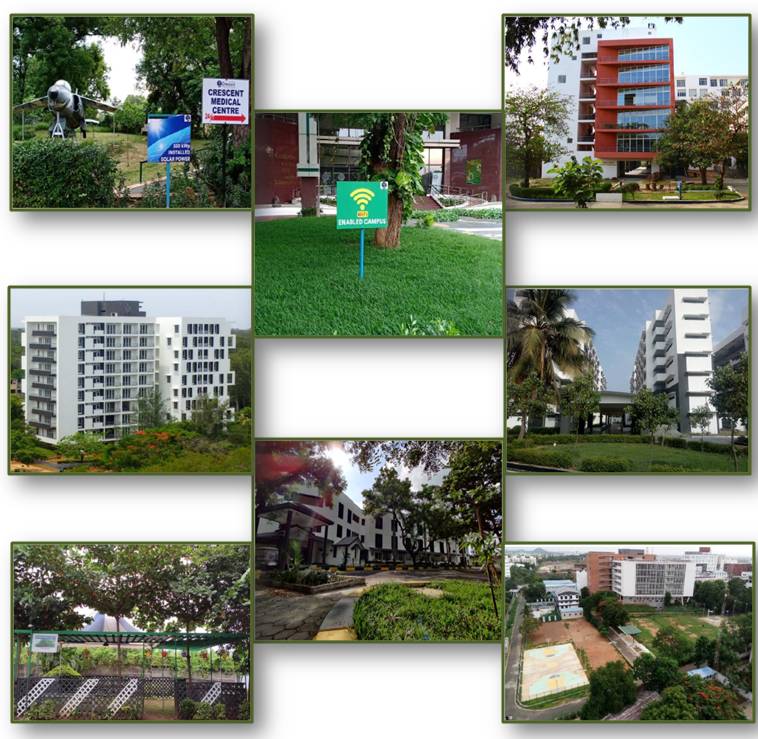
Academic Year 2020-21
Water reuse generally denotes the process of capturing wastewater, stormwater, or greywater and treating it as required for a designated beneficial uses such as drinking, or surface or ground water replenishment. The water reuse in the Institute is looked upon in two aspects.
- Recylcing of the treated water from the sewage treatment plant for benefial purposes like gardening and toilet flushing
- Harvesting of the Rain water
Treat the Wastewater and Reuse
Liquid Waste Management – Sewage Treatment Plant – 500KLD
- 2 nos. of Sewage treatment plants of 250KLD capacity are available, one for Men’s Hostel and one for Institute campus. The STP is of Eco-Bio Block type. The treated water is used for landscaping and toilet flushing purpose.
- The sewage treatment plant is working on the principle of attached growth aerobic system (Eco-Bio bricks) followed by sand filter and carbon filter

| Location | Capacity | Remarks |
|---|---|---|
| College campus | 250KLD | Commissioned in 2003 as a 150KLd plant. Revamped and capacity increased to 250KLD in 2015 |
| Men’s Hostel | 250KLD | Commissioned in 2014 |
| S.No | Location | Total water collected | Water recycled | % of water reutilized |
|---|---|---|---|---|
| 1 | College campus | 250 KL | 220KL | 90 |
| 2 | Men’s Hostel | 250 KL | 220KL | 90 |
Mira Carbon Sewage Treatment Plant
Our Institute has established MIRA CARBON SEWAGE TREATMENT PLANT of 2 m3 capacity and Vermi filtration Unit in association with M/S.Kanyo Group of Companies to treat domestic wastewater generated from the Institute.
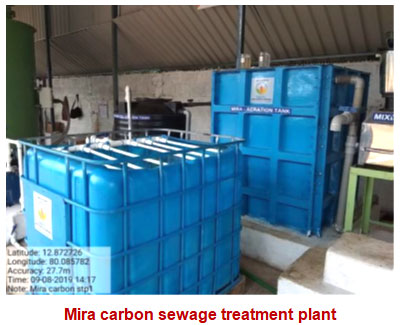
Rain Water Harvesting Structures and Utilization in the Campus
- The institute has implemented rain water harvesting system in the campus with a strong desire to utilize the rain water at maximum extent.
- In the forefront to save water, our institute of science and technology has initiated and executed the rainwater harvesting in the campus.
- Rainwater harvesting facility is done in all blocks to collect rainwater from the roof of all buildings.
- The harvested water is diverted to open wells in institute campus, Men’s Hostel and ladies hostel.
- The placement of rainwater facility within the campus is decided upon by considering the profile of the land so as to drain the maximum amount of water collected with ease.
- In the buildings, sufficient plumbing connections are provided to trap the rain water from the roof tops.
- Underground connections are ensured to connect the collected water from the roof top to the rainwater recharge pit.
- It was also ensured that the rainwater harvesting structures are constructed as per the norms. The recharge pit provided to collect the rain water is series of filter bed.
- This initiative took shape when the institute faced shortage of water during summer. Cost of buying water was becoming a financial burden. The only alternative to the water crisis was to use the available water more effectively.
- The features of the recharge pit are described below.
- A mesh is provided at the inlets of rain water pipes so that solid waste/debris is prevented B.S.Abdur Rahman Crescent Institute of Science and Technology has taken initiatives to install rain water harvesting pits in the campus from entering the pit system.
- The recharge pits are of size 2m x 2m x 2m is excavated
- The recharge pit comprises different set of filter media. The filter media comprises of thick layers of boulders at the bottom followed by layers of gravels and coarse sand.
- This enables the filtration of water and also prevents the deposition of silt on the recharge pit.
- Access Manhole frames and covers are provided.
- The rain water is also stored in Underground sumps of Life Science block, Mechanical Science Block and New Staff Quarters.
B.S.Abdur Rahman Crescent Institute of Science and Technology has taken initiatives to install rain water harvesting pits in the campus.
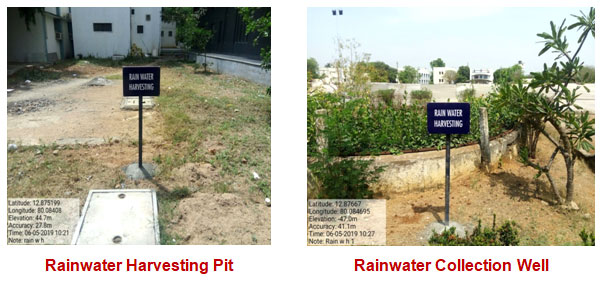
Rainwater harvesting facility is done in all blocks to collect rain water from the terrace. The details are listed below.
| Rain Water Harvesting Details | ||||
|---|---|---|---|---|
| S.No | Inlet Pit Detail | Area (sq. m) | Rain water filter capacity (Litres) | Location |
| 1 | Inlet pit-1 | 156 | 200 | Mechanical Science Block |
| Inlet pit-2 | 122 | 200 | ||
| Inlet pit-3 | 296 | 300 | ||
| Inlet pit-4 | 175 | 200 | ||
| Inlet pit-5 | 243 | 300 | ||
| 2 | Inlet pit-1 | 191 | 200 | Ladies Hostel-New Block |
| Inlet pit-2 | 188 | 200 | ||
| Inlet pit-3 | 132 | 200 | ||
| 3 | Inlet pit-1 | 68 | 100 | New Staff quarters |
| Inlet pit-2 | 65 | 100 | ||
| Inlet pit-3 | 81 | 100 | ||
| Inlet pit-4 | 66 | 100 | ||
| Inlet pit-5 | 81 | 100 | ||
| Inlet pit-6 | 66 | 100 | ||
| 4 | Inlet pit-1 | 61 | 100 | Men’s Hostel-A&B BLOCK |
| Inlet pit-2 | 71 | 100 | ||
| Inlet pit-3 | 43 | 100 | ||
| Inlet pit-4 | 132 | 200 | ||
| Inlet pit-5 | 132 | 200 | ||
| Inlet pit-6 | 43 | 100 | ||
| Inlet pit-7 | 71 | 100 | ||
| Inlet pit-8 | 61 | 100 | ||
| 5 | Inlet pit-1 | 297 | 300 | Men’s Hostel -C& D BLOCK |
| Inlet pit-2 | 297 | 300 | ||
| 6 | Inlet pit-1 | 71 | 100 | Men’s Hostel -PG BLOCK |
| Inlet pit-2 | 71 | 100 | ||
| Inlet pit-3 | 71 | 100 | ||
| Inlet pit-4 | 71 | 100 | ||
| Inlet pit-5 | 71 | 100 | ||
| Inlet pit-6 | 71 | 100 | ||
| Inlet pit-7 | 71 | 100 | ||
| Inlet pit-8 | 71 | 100 | ||
| 7 | Inlet pit-1 | 275 | 300 | Pharmacy Block |
| 8 | Inlet pit-1 | 340 | 300 | Library Block |
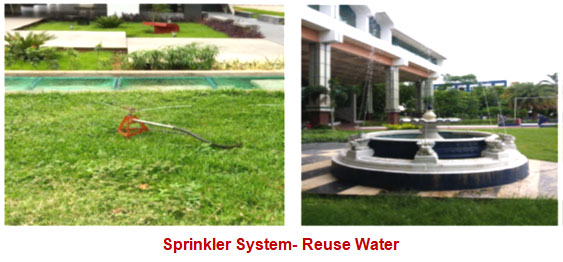
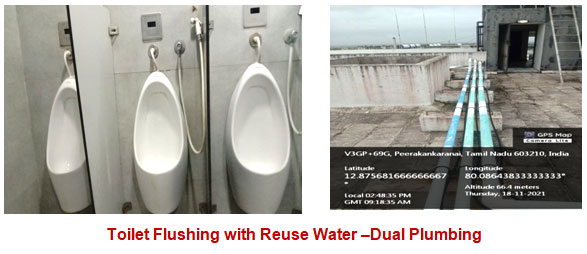
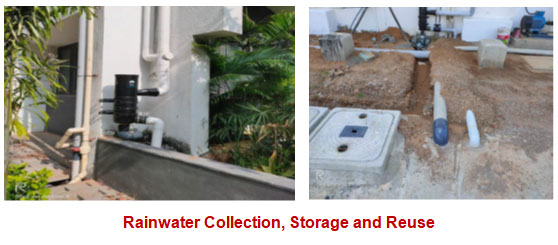
Academic Year 2020-21
- The wastewater generated from the STP is also measured and it is approximately 4,05,000 Liters
- The quantity of the wastewater treated is assessed (3,44,000 Liters) and around 85% of the treated water is stored in the sump
- Form this around 1,35,000 Liters of treated effluent is used for the toilet flushing
- Around 1,59,000 Liters of treated water is used for landscaping and 50,000 L is used for building maintenance

Speaker
- Mridula Ramesh- CEO, Sundaram Textiles
- Amith Chandra- Chairman, Bain capital
- Rajendra Singh- Indian water Conservationist and Environmentalist
- Ranganath NK- Grundfos pumps India
Ms. Mridula Ramesh’s research, conducted by the Sundaram Climate Institute, reveals the severity of the water crisis in India and proposes solutions to address it. The research was based on detailed field data and involved speaking to thousands of people across the country. The study found that the water crisis is deep and unequal, and without intervention, it will only worsen. The research suggests that each individual must take responsibility for building water resilience in their respective cities, and this can only be achieved by working together.
There were some notable observations made by experts in the field. Mam suggested that urban people should pay for water to increase their awareness of water conservation. Dr. Rajendra Singh, who is from a rural area, noted that people in rural Rajasthan are more conscious of water conservation and are capable of building their own dams without government funding. Mr. Ravichandran Purushothaman concluded that Ms. Ramesh’s research is primarily suited for urban people because they tend to be less conscious about water conservation. He further suggested that urban people need to be educated about water conservation.
Overall, Ms. Ramesh’s research highlights the need for urgent action to address the water crisis in India, which can be achieved through individual responsibility and collective effort.

One day Seminar on “Sustainable Management of Clean Water & Sanitation in Rural and Urban Areas” was sponsored and organised by the Institution of Engineers (India),Kanchepuram Local Centre in association with the Department of Civil Engineering, School of Infrastructure, B.S.Abdur Rahman Crescent Institute of Science & Technology on 15th February 2023. Dr.Vasanthi Padmanabhan, Professor & Student Advisor IE(I) School of Infrastructure welcomed the chief guest Dr.D.Elango, FIE,National Council Member & Chairman IE(I)-Kanchepuram Local Centre and the audience. Dr.M.S.Haji Sheik Mohammed, Professor & Dean, School of Infrastructure, delivered the presidential address. The seminar had four sessions. The Chief guest Dr.D.Elango, FIE,National Council Member & Chairman IE(I)-Kanchepuram Local Centre inaugurated and delivered a keynote address on the topic “Water Quality and Treatment facilities for Urban and Rural Areas”, the second session by Dr.T.Selvakumar, Retd.Engineer (CMWSSB) and Research Consultant on thetopic “Urban Water Supply & Sanitation in Rural & Urban Areas in India”, the third session on the topic “Faecal Sludge and Septage Management in Rural and Urban areas” by Dr.Suneethi Sundar, Research Scientist, Water & Effluent Treatment IC, L&T Construction and last session by Dr.V.S.Priya , Associate Professor, Department of Civil Engineering, School of Infrastructure, BSACIST, on the topic Urban Sanitation in India: Opportunities and challenges.
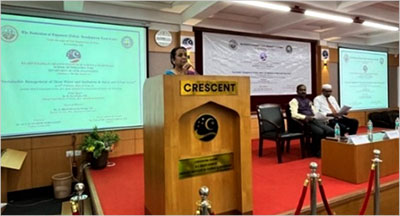

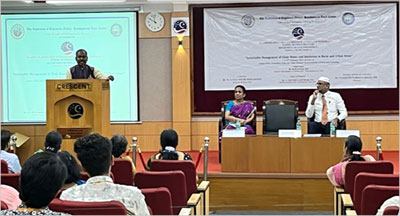
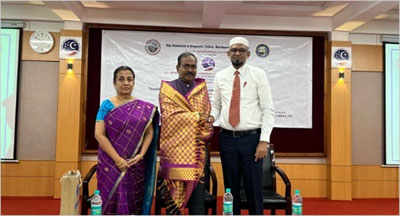
“World Water Day 2022” was celebrated on March 22nd, 2022 by the Department of Civil Engineering. Around 75 participants including faculty members and students participated in this programme. The guest speaker Dr R.Ramachandran, Superintending Engineer (Retd), PWD, Madurai, delivered a lecture on “Water Resources Management”. He highlighted the importance of saving water and the fundamental details of the water sector.
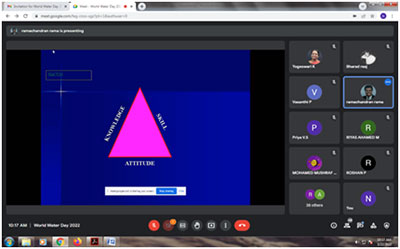
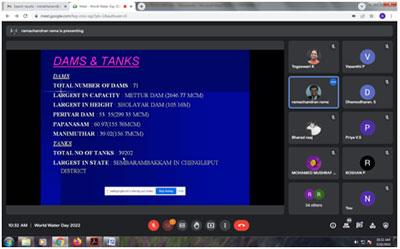
We the Rotaract Club of Crescent joined hands with Rotaract Club of New College for a New College and 62 other clubs.
PROJECT 3232 is one of the prime attempt of integrating all the thought process of Rotary & Rotaract under one roof. Our club hosting this project with 32 International District Clubs & 31 Home District Clubs of RID 3232, all together of 64 Clubs.
These 64 Clubs focus on Rotary’s 7 areas + Elevate Roatarct = 8 Focusing Group functioning with 4 avenues of Rotaract. To the point, These clubs done 32 Projects covering with aforementioned Propaganda at various geographical locations globally.
Water & Sanitation (GROUP 3)
Project 9 – Swach School – cleaning in Kodambakkam, Royapettah, Luzira Africa, Matalae – Sri Lanka
Project 10 – Grant Bin – donation of dustbin at Anna Nagar Guild school
Project 11 – Webinar on Water awareness – Principal of Alpha School
Project 12 – Esaay Writing competition – Water & Sanitation PROJECT 3232

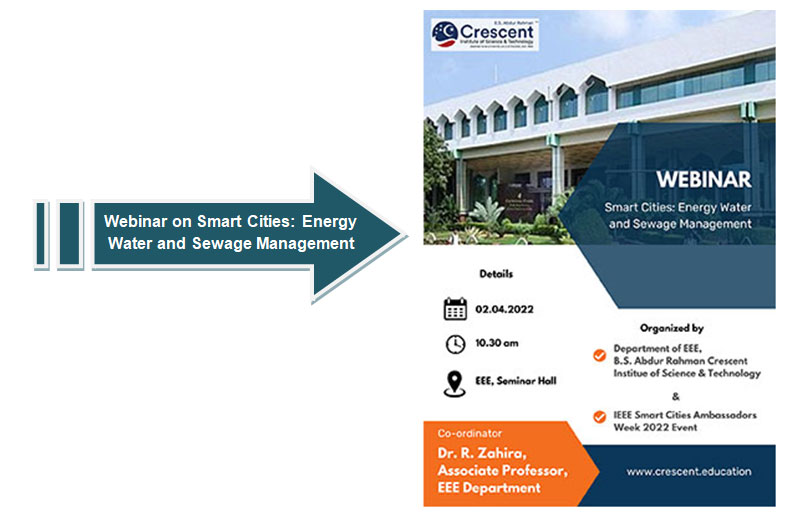
Academic Year 2020-21
Department of Civil Engineering, School of Infrastructure organized two day “International Conference on Recent Advances in Sustainable Construction Technologies and Environment (ICRASCE-2022)” during 15.06.2022 & 16.06.2022 at B.S. Abdur Rahman Crescent Institute of Science and Technology in virtual mode. More than 100 papers in 6 major streams such as Construction Technology and Building Materials, Transportation Engineering, Structural Engineering, Environmental Engineering and Water Resource Management, Geotechnical Engineering, Advanced Surveying and Remote sensing & GIS were presented during the conference.
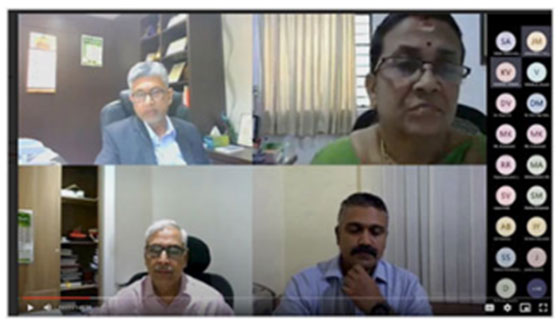
World Water Day 2022 (22.03.2022)
“World Water Day – 2022” was celebrated on 22.03.2022 by Department of Civil Engineering. Around 75 participants including faculty members and students participated in this programme. The guest speaker Er.R.Ramachandran, Superintending Engineer (Retd), PWD, Madurai, delivered lecture on “Water Resources Management”, in which he highlighted the importance of saving water and the fundamental details about the water sector.

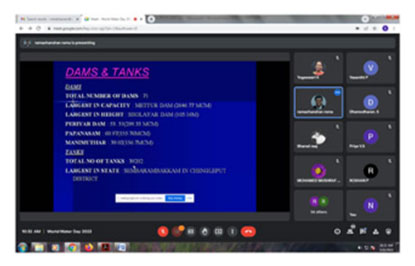
NSS Special Camp on cleaning of school premises, awareness of healthy food habits, importance of hygiene and sanitation, manuring and irrigation, importance of disaster management, farm pond, rainwater harvesting and conservation methods- and various sports, funs and cultural programmes for the school children’s
SPECIAL CAMP
27.09.2021 to 01.10.2021
Venue: Panchayath Union Middle School Keerapakkam, kattankulathur Union Kancheepuram, District.
The Five days special camp has been organized by the NSS units of BS Abdur Rahman Crescent Institute of Science and Technology at Keerappakam, Arungal, and Murugamangalam panchayaths in the Kattankullathur union of Kanchipuram district of Tamil Nadu during the period of 27.09.2021 to 01.10.2021. There were various programmes and functions were organized under the leadership of the NSS units of the Crescent Institute. Programmes like cleaning of school premises, awareness of healthy food habits, importance of hygiene and sanitation, manuring and irrigation, importance of disaster management, farm pond, rainwater harvesting and conservation methods- and various sports, funs and cultural programmes for the school children’s and for NSS volunteers. The main motives for conducting the special camp is to develop the society , enlighten the villagers and NSS volunteers by giving awareness on various socio- economic issues facing by the downtrodden sections. Around 150 volunteers from the three III units of the NSS Crescent Institute of Science and Technology including boys and girls were actively participated each and every programme conducted in the village as part of special camp.
The inaugural function was organized at the panchayath Middle school Keerappakkam village. The very first day the swachh bharat mission programme was started with the welcome address of the Dr. Ayub Khan Dawood, NSS Coordinator of the institute. Earlier the programme was started by the reciting of the Qirat which was followed by the Tamil Thaivalthu. During the welcome address the Dr. Ayub Khan Dawood was discussed about the importance of conducting the swachh bharat mission in the village and what are the advantages getting by the villages while conducting the programme . The special address given by the Dr.N Raja Hussain, the deputy registrar of the institute. He showed the very interest and happy to conduct the cleaning programme in the village and explain the importance of NSS and various programmes to be conducted as part of the Swachh bharat mission. He stressed the functions and programmes of NSS for the development of society particularly and overall community generally. This will help the students from the schools for their mental and moral enrichments.
Mr. K Babu the headmaster of Keerapakkam panchyath middle school gave the gesture of happiness for conducting the special camp in their school. In his speech he stressed the importance of conducting such type of camps in the schools for the development of school generally and for the mental and moral well being for the students. Dr. Vijayprasad, Dean Crescent School of Phramacy, Mr. S Babu, BDO kattangaluathur, Mr. L Tamilselvan , VAO of Keerapakkam, Mr. D Harikrishnan ex-panchayath president of Keerapakkam, Mr. R Rajendran, ex panchayath president of Keerapakkam, were present in the inaugural function. NSS volunteers from the Crescent, school childrens, teachers from the school and general public were presented at the time of inaugural function.
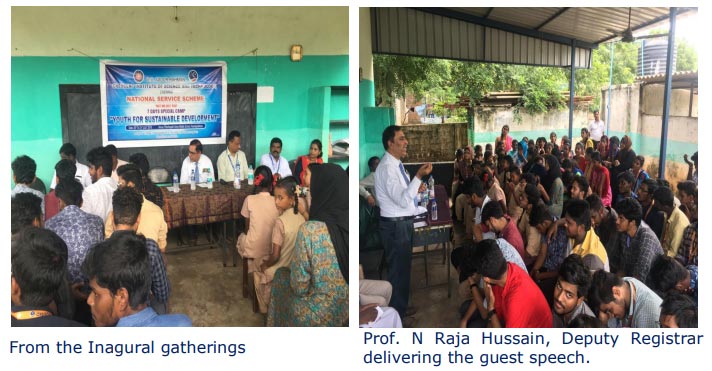

Day second started with the cleaning of both schools-Panchayath union middle school, Keerappkkam and another belong to the Arungal Panchayath Union primary school. The NSS boys volunteers were engaged in the white washing while the girls volunteers were involved in the cleaning of school ground. The school’s compound wall was not good enough to look, so Crescent NSS volunteers were initiated the cleaning of the walls by whitewashing.

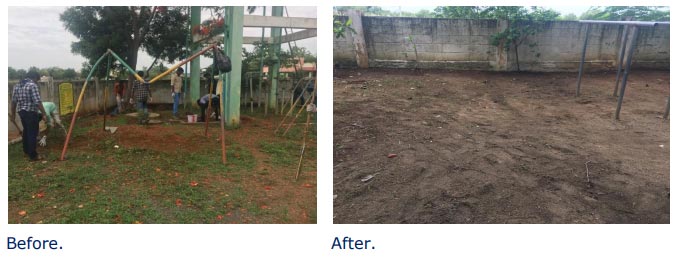
The day third started with cleaning of Crescent Institute of Science and Technology campus premises. As part of the programme boys and girls volunteers wholeheartedly participated the cleaning drive. The volunteers cleaned the areas of children’s park in the staff quarters, premises to the staff quarters, the way to the staff quarter which is near to the basketball quart and the way from the staff quarters to the college. More than 60 volunteers participated in the progamme.

The fourth day started with white washing of the two schools. Panchayath Union middle school, Keerappakkam and Panchayath primary school at Arungal. Both schools’ compound wall has been whitewashed by our volunteers. After the white washing Dr. Geetanjali, President of IWC, KK Nagar gave a guest lecture on healthy food habits. In her talk she gave an idea about the importance of healthy food among the teenagers especially among the girls. The talk was very interesting and thought provoking. Dr.
Parimala BSMS, PGDYM, Appolo Hospital Chennai had delivered the lecture on Importance of Hygiene and sanitation. The talk was very useful for the girls volunteers, especially they got awareness of importance of Hygiene during the menstrual period. After that Ms. Harini, Chairman, International service organization gave a talk on the evils of plastic. In her talk she gave wonderful narration about the disadvantages of usage of plastic in our society.
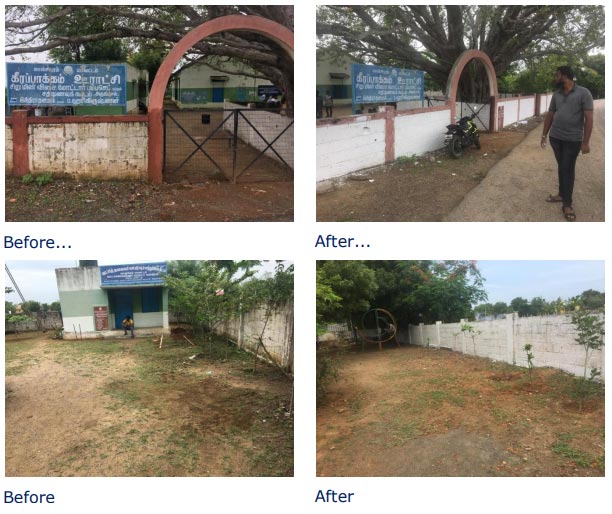

The Keerappakkam panchayath Union middle school’s was again engaged for cleaning the playground. Too much bushes and grasses were there in ground and due that it was unused for playing. So our Crescent NSS volunteers cleaned the entire area of the ground and makes it better and comfortable place to play. As part of the cleaning programme Crescent NSS donated one volleyball net and one volley ball to the students of the school. As tone of happiness Crescent Institute gifted two ceiling fans for the Panchayath Union Middle school and further offered four computers for giving computer awareness to the students in the school.

The tree plantation drive was arranged in the Keerappakkam panahcyatht premises. The tree sapling drive was inaugurated by our Honourable registrar Dr. A. Azad of BSA Crescent Institute of Science and Technology, by planting a tree. Followed by the tree plantation an awareness programme were organized among the villagers in order to provide an understanding about the tree plantation, manuring and watering the trees. More than 100 tree sapling were planted in the three villages of the special camp.

Valedictory function was organized in the last day of the special camp at the Keerapakkam panchayath middle school premises. The function was inaugurated by our Honourable registrar Dr. A. Azad of BSA Crescent Institute of Science and Technology. In his speech, he recollected the memory of his school days and delivered the speech on importance of conducting such special camps in the villages for the development of personality of the students particularly. He also promised to the villages such types of programmes will be conducting in the village in near future. Before, the welcome address given by the Dr. Ayub Khan Dawood, NSS Coordinator of the institute. Mr. K Babu the headmaster of Keerapakkam middle school gave the gesture of happiness for conducting the special camp in their school and Honored our Registrar with a shawl. NSS special camp certificate were distributed to the volunteers. Finally the vote of thanks given by the Ms. Sonya NSS programme Officer of the Crescent Institute of Science and Technology.
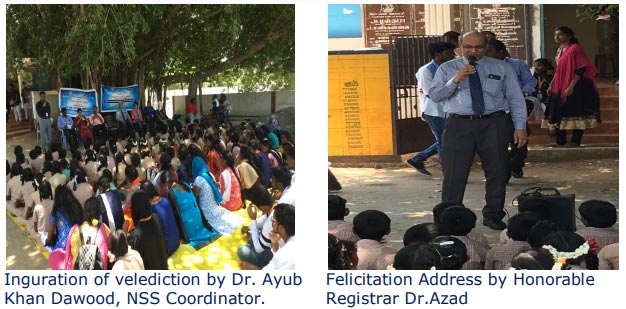
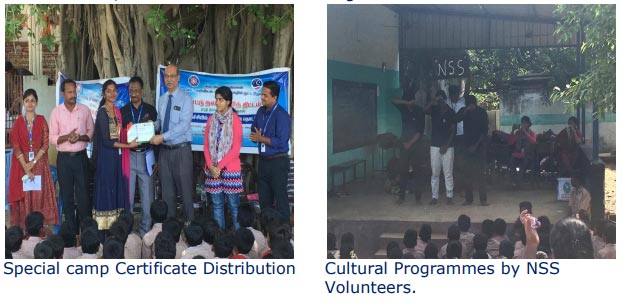
World Water Day 2021 (22.03.2021)
The Department of Civil Engineering, School of Infrastructure organized World Water Day 2021, through online on 22.03.2021. Around 83 participants including faculty members and students participated in this programme. The guest speaker Dr.Sekhar Raghavan, Director, Rain Centre, Adyar, Chennai delivered lecture on “Rain Water Harvesting for Urban Areas”, in which he highlighted the importance of Rainwater and its conservation through various methods.

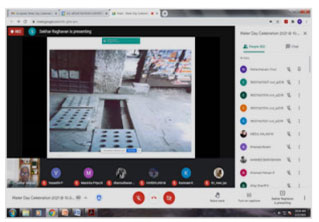
STTP on Disaster Mitigation
on
DISASTER MITIGATION
A shift from disaster management towards disaster preparedness
PHASE 2 – 19.10.2020 to 24.10.2020
PHASE 3 – 16.11.2020 to 21.11.2020
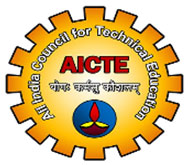
About the Short term training programme
The world is facing various environmental disasters which will ultimately affect the sustainability of human kind. Integrated approach embedded with disaster preparedness and risk reductions are the key factors to focus on to achieve sustainable hazard mitigation. Disaster preparedness provide a platform to design and coordinate the activities that would predict, prevent disaster and reduce the effects of their impact on vulnerable population. Community preparedness, early warnings, assessment of vulnerability, contingency planning, training in disaster management, capacity building, well prepared initiatives from the government are some of the tools that would serve as sustainable options that would reduce the risk of disaster and help community to effectively cope during the disaster and also to face the consequences. Basic understanding on the impacts caused by the disasters and development of eco- friendly recovery methods would favour mitigation and enhance the development of sustainable community.
The main objectives of the STTP are
i) To understand various categories of disaster and challenges posed by the disaster.
ii) To explore on the disaster management cycles and risk reduction options.
(iii) To analyse the impacts of the development projects on the disaster and to find effective measures to develop eco friendly recovery options.
07.09.2020 to 12.09.2020
AICTE sponsored Short Term Training Programme (STTP) –“Disaster mitigation: A shift from disaster management towards disaster preparedness”- Phase I was conducted through online mode with the speakers as listed in the below table using Google Meet video conferencing.
| Programme schedule | ||
| 07.09.2020 (Day – 1) | ||
| 10.00 AM-10.30 AM | Inauguration | |
| 10.30AM -11.30 AM | Inaugural Address – Climate change adaptation: Challenges | Dr.K.PALANIVELU Professor & Director Centre for Climate Change and Disaster Management, College of Engineering Guindy, Anna University |
| 11.45 AM – 01.00 PM | Landslide risk reduction strategies | Dr.G.P.GANAPATHY Professor& Director, Centre for Disaster Mitigation and Management, Vellore Institute of Technology, Vellore |
| 01.00 PM-02.00 PM | Lunch Break | |
| 02.00 PM-03.15 PM | First response for water, wastewater & waste management during disaster | MR.VARUN SRIDHARAN, CEO, M/S. Greenevironment, Chennai |
| 08.09.2020 (Day – 2) | ||
| 10.00 AM-11.30 AM | Role of Geomatics in Disaster mitigation and management | DR.S.VASANTHA KUMAR Associate Professor, Department of Civil Engineering,VIT, Vellore |
| 11.45 AM – 01.00 PM | Disaster management for coastal structures during cyclonic events | MR.PARAMESAWARA PANDIAN S Technical Director, BMT Consultant India |
| 01.00 PM-02.00 PM | Lunch Break | |
| 02.00 PM-03.15 PM | Earthquake disaster mitigation | Dr.MUTHUMANI K (Former Director ASTAR Lab – CSIR-SERC) Professor, Dean, School of Civil Engineering,VIT University, Chennai |
| 09.09.2020 (Day – 3) | ||
| 10.00 AM-11.30 AM | Disaster management for industrial pollution | Dr.ARYA V, Assistant Professor, Department of Civil Engineering, IIT Delhi |
| 11.45 AM – 01.00 PM | Adaptation as coastal disaster preparedness to changing climate and rising sea levels | Dr.A.SALEEM KHAN Postdoctoral Fellow and Fulbright Scholar, IIT Madras |
| 01.00 PM-02.00 PM | Lunch Break | |
| 02.00 PM-03.15 PM | Extreme weather events and climate change: Lessons from Kerala | Mr.NIDHIN DAVIS K Former Hazard Analyst- Kerala State Disaster Management Authority. Technical expert Climate Change –GIZ India |
| 10.09.2020 (Day – 4) | ||
| 10.00 AM-11.30 AM | Vulnerability assessment and ERP- Water treatment plant | Prof.K.S.LOKESH Professor &Former Registrar, JSS Scientific and Technical university, Mysuru. |
| 11.45 AM-01.00 PM | Computing Tools, Techniques and Methods for Natural Calamities warning and Response system | Dr. SUDALAI MUTHU T, Associate Professor, Department of Computer Sciences and Engineering HITS, Chennai |
| 01.00 PM-02.00 PM | Lunch Break | |
| 02.00 PM-03.15 PM | Role of Environmental management, types of disaster and mitigation | Dr.LAKSHMI C Associate Professor Department of Civil Engineering SJB Institute of Technology, Bengaluru, Karnataka |
| 11.09.2020 (Day – 5) | ||
| 10.00 AM-11.30 AM | Water shed management during disaster | Dr.S.V.MURUGAN Director, National Agro Foundation, Chennai |
| 11.45 AM – 01.00 PM | Scientific technology for coastal disaster management | Dr.SISIR KUMAR DASH Scientist E, National Centre for Coastal Research (NCCR), Chennai |
| 01.00 PM-02.00 PM | Lunch Break | |
| 02.00 PM-03.15 PM | Geotechnical aspects in seismic design of foundation and hazard mitigation | Dr.PREMALATHA K Professor, Department of Civil Engineering, College of Engineering Guindy, Anna University |
| 12.09.2020 (Day – 6) | ||
| 10.00 AM-11.30 AM | Disaster Risk Reduction Strategies- An Overview | Dr.J.S.SUDHARSHAN Assistant Professor, NICMAR, Pune |
| 11.30 AM- 1.30 PM | Certificate Examination for the participants | Conducted by Department of Civil Engineering |
| 1.30 PM – 2.30 PM | Lunch Break | |
| 02.30 PM-03.00 PM | Valedictory and Feedback session | |
Details of the Session
Dr.K.PALANIVELU
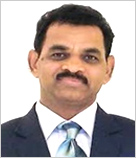
Dr.Palanivelu delivered a lecture on Climate Change Adaptation: challenges and way forward. Disaster and its classification was elaborated. The disaster preparedness and its management principles was elaborated . Climate change and the reasons for global warming effects were highlighted in the session. The global average surface temperature change and its scenario were forecasted.

Consequences and impacts of climate change was described followed by increase in sea level. Mitigation and adaption to climate change was discussed. Convention articles referring to adaptation and adaptation to climate change in national and international level was elaborated. Adaptation strategies for water resources sectors was clearly discussed. Major impacts and strategies for sustainable habitat was discussed.
Dr.G.P.Ganapathy
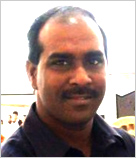
Dr. G.P.Ganapathy, delivered a lecture on landslides risk reduction strategies. Case study on different landslides like Darjeeling, Malpa, Mumbai, Amboori, Kedarnath and Malin was highlited in the session. Landslide, its causes and types were also elaborated. Technological tools for evaluation of landslides was discussed.
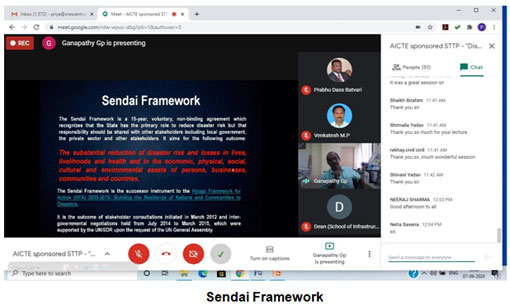
Three important criteria for landslide maps are landslide inventory map, landslide susceptibility map and landslide hazard map. Usage of instruments like piezometer, inclinometer and tiltmeter for landslide warning was also discussed. The role of GPS and data logger was elaborated. Landslide occurrences, population growth, geological map, geomorphological map and topography map in Nilgiris were discussed. During the discussion an app named “TN smart” for receiving disaster risk alerts, reporting emergency situations and providing feedback alerts was also described.
Mr.Varun Sridharan

Varun Sridharan delivered a lecture on “First response for water, wastewater & waste management during disaster”. The immediate response after the disaster with no potable water, sanitation and hygiene was elaborated. The significance of WASH(Water, Sanitation and Hygiene) in emergencies was discussed.
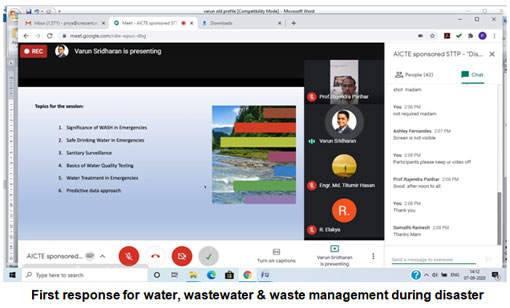
The importance of epidemiological triangle with environment, agent and host was introduced. The problems like low quality water and sanitary surveillance after a disaster was described. The steps required in water treatment in emergencies were discussed. Predictive data approach for water and wastewater distribution systems was discussed. Use of IoT enabled solution for water and sewer networks was introduced.
DR.S.VASANTHA KUMAR
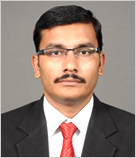
Dr.S.Vasantha Kumar presented a topic on “Role of Geomatics in Disaster Mitigation and Management”. He presented a case study on landslides, flood, soil pollution and accident related studies. Landslide in nilgiris and its frequency and its impacts were discussed. Case study on extraction of topographic and morphometric features for ooty- Mettupalayam highway was discussed.
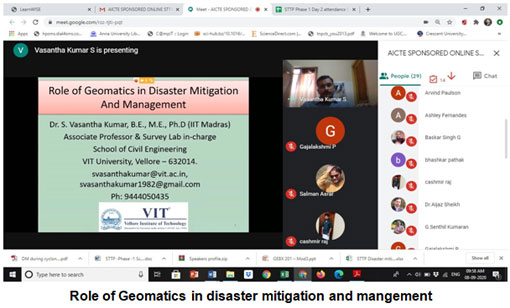
Usage of DEM for deriving topographic features such as slope, aspect and curvatures was explained. Case study on the effect of deforestation on landslides in Nilgiri district was elaborated. Case study on landslide hazard zonation of Nilgiri district using remote sensing and GIS. Flood simulation and inundation mapping of Adayar river using GIS was elaborated. Case study on the extent of soil contamination caused by Tanneries in and around Dindigul was also discussed. Accident analysis done in NH-209 (Dindigul – Palani Road) was discussed.
PARAMESWARA PANDIAN S

Parameswara Pandian delivered a lecture on “Disaster Management for Coastal structures during cyclonic events”. Initially the various terms related to coastal structures was briefed along with photographs. Different waves generated during cyclones and its pattern was discussed. Cyclone modeling and monitoring after warning was also elaborated.

Precautions that need to be followed in coastal construction areas during cyclones was highlighted in the session.
Dr.K.MUTHUMANI
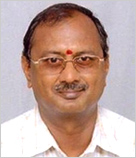
Dr. K.Muthumani delivered a lecture on “Earthquake disaster mitigation”. The case study on Kutch, Gujarat earthquake on January 26, 2001 was discussed. Natural disasters response and relief activities are described. The role of risk assessment and hazard risk map was also described. Vulnerability and its types (i.e) tangible and intangible was also described.

Flood vulnerability, drought vulnerability and earthquake vulnerability of Andhra Pradesh was described with hazards map. Global economic losses due to major earthquakes and also the economic losses in India was elaborated. Disaster management structure in India was elaborated. India’s vulnerability to various sets of disaster was described. Earthquake effects and development of earthquake resistant buildings was elaborated.
Dr.Arya V
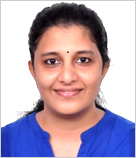
Dr.V.Arya delivered a lecture on “Disaster Management for Industrial Pollution”. Different industrial accidents like Minamata accident, Bhopal gas tragedy and Baia Marie cyanide spills were described. Prevention methods for industrial disaster was listed. Major polluting industries and chemical pollutants were elaborated.
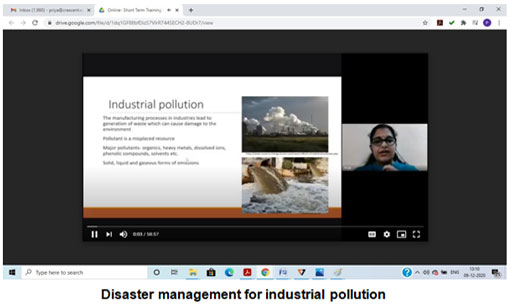
Self purification of river was illustrated. Fate of chemicals like dye, paint and fertilizers were described. Tannery industries in Kanpur and its pollution in Ganges were discussed. Ground water and surface water pollution in patencheru industrial area, medak district was mentioned. Heavy metal contamination in industrial area of Panipat city, Haryana was elaborated. Industry classification based on the pollutant level was described. The emerging contaminants and its exposure pathways were also discussed.
Dr. A. SALEEM KHAN

Dr. A. Saleem khan delivered a lecture on “Adaptation” as coastal disaster preparedness to changing climate and rising sea levels. He elaborated global climate change and its impacts. The need for the climate change adaption was also listed. Sea- level rise and impacts of climate change in coasts was also discussed. Different types of adaption methods were elaborated.

Coastal adaption to SLR(Sea Level Rise) and its strategies was explained. Importance of mangroves and vulnerability assessment was discussed. The framing adaption strategies used in coastal areas were also listed. Mainstreaming SLR adaption strategies or policies were also discussed.
NIDHIN DAVIS K
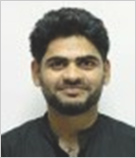
Nidhin Davis K delivered a lecture on “ climate change and extreme weather events: learnings from kerala”. He elaborated the recent disasters that occurred in the past five years. He also discussed about the anthropogenic green house effect. He also described about the extreme weather events and climate change due to disasters like cyclone storms, landslides, floods.

He also described about the climate risks and global warming. The current scenario of kerala for different disasters was also elaborated. The different emergency operations in the regional level was also discussed. The learnings from Kerala experience was elaborated briefly with flood vulnerability maps.
Prof.Dr. K.S.LOKESH
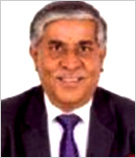
Prof. K.S. Lokesh delivered a lecture on “Vulnerability assessment and ERP- Water treatment plant”. He elaborated the Vulnerability assessment and emergency response plan. Vulnerability assessment checklist is designed to identify potential areas of vulnerability associated with these assets and appropriate actions that can be taken to minimize the vulnerabilities identified.

An emergency response plan is vital in case there is an incident that requires immediate response. It should be reviewed at least annually (or more frequently if necessary) to ensure it is up-to-date and addresses security emergencies including ready access to laboratories capable of analyzing wastewater samples.
Dr. SudalaiMuthu T

Dr. Sudalai Muthu T delivered a lecture on “Computing tools, techniques and methods for natural calamities warning and response system”. Different natural and man- made calamities or disasters were elaborated. The various disaster preparedness tools were listed. The application of geographic information systems for disaster management were also elaborated.
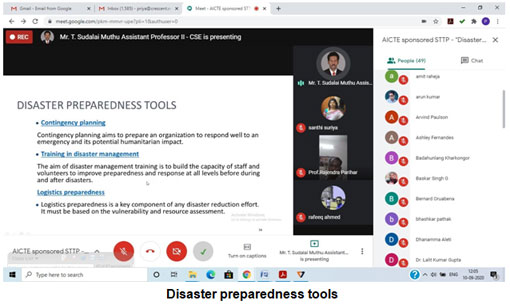
The important tools in GIS like clip tool, merge tool, dissolve tool, intersect tool, union tool and erase tool was discussed. The remote sensing in natural hazard assessments like aerial photography, airborne radars and thermal IR scanners were also described. He briefed the role of social media and artificial intelligence to disaster response.
Dr.Lakshmi.C
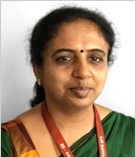
Dr. Lakshmi.C delivered a lecture on “Role of environmental management: types of disaster and mitigation”. The process of environmental management plan was described. Environmental disaster management was elaborated along with goals and principles. Environmental disasters along with the direct and indirect damages were also briefed.
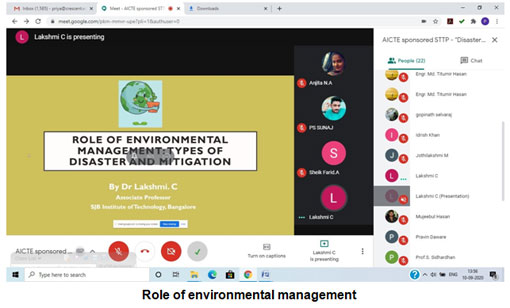
Case study on flooding of river Ganga and Marbi disaster in Gujarat was also discussed. Drought management factors and case study of great Bengal famine 1770 was elaborated. It was followed by other disasters like earthquake and cyclone along with a case study. The mitigation strategies for the above mentioned disasters was also discussed. The causes and mitigation measures for landslide was also discussed.
Dr S V Murugan
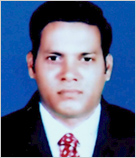
Dr.S.V Murugan delivered a lecture on “watershed management during disaster”. Watershed concept and its importance was explained. It was followed by the evolution of watershed and principles of watershed. Water related Disasters in the world was elaborated. Strategies of IWM towards disaster management were discussed.
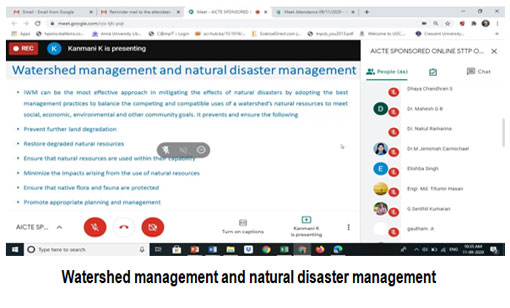
Watershed management and natural disaster management was also elaborated. The various mitigation measures of water related disaster was also discussed.
Sisir Kumar Dash

Sisir Kumar Dash delivered a lecture on “Scientific technology for coastal disaster management”. He elaborated on different application of technology in coastal disaster management. He also elaborated in detail about the GIS and remote sensing. GIS provides a tool for effective and efficient storage and manipulation of remotely sensed data and other spatial and non-spatial data types for both scientific management and policy oriented information.
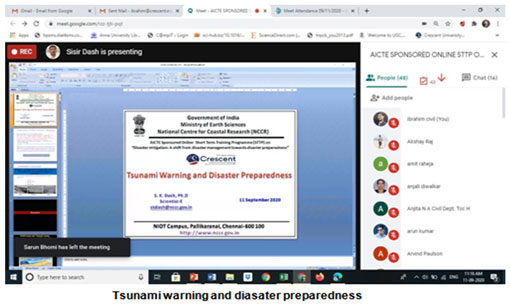
Remote sensing makes observation of any object from a distance. He also explained about the need of warning and forecasting system. An advance system of forecasting, monitoring and issuing early warnings plays the most significant role in determining whether a natural hazard will assume disastrous proportions or not.
Dr.PREMALATHA K
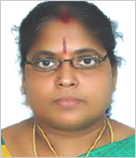
Dr.K, Premalatha delivered a lecture on “Geotechnical aspects in seismic design of foundation and hazard mitigation”. She explained about the seismological features of the earth and also about the seismic events. She also elaborated about the theory of plate tectonics and the evidence for its movement.
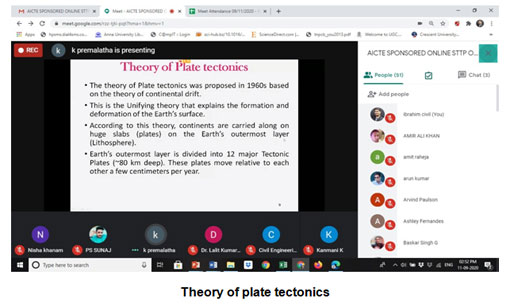
She also elaborated about the different types of seismic waves. She also elaborated major earthquake hazards and ground response analysis. Earthquake damages and local site effects in different region was also explained. Liquefaction and effects of liquefaction, flow failure, lateral spreading and related phenomenon was also elaborated.
Dr.J.S.SUDHARSHAN
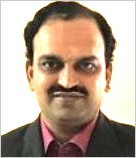
Dr. J.S.Sudharshan delivered a lecture on “Disaster Risk Reduction Strategies- An Overview “. He explained the concepts of disaster risk and key components of risk. He also elaborated on key disaster trends and the underlying driving factors. Actions involved in disaster risk reduction were also explained.
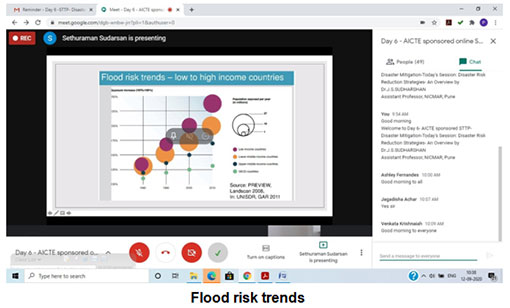
Feedback Analysis Report
Feedbacks about the STTP were collected from the participants through Google forms for carrying out improvement in the upcoming STTP. The analyses of the report are given below.
Regarding the effectiveness of the webinar, nearly 85.9% of the participants found that the webinar to be excellent and more than 12.7% of the participants registered that the webinar was good. Overall 98.6% found that the STTP was effective.
CERTIFICATE OF PARTICIPATION
The sample participation certificate for the participants is given below

19.10.2020 to 24.10.2020 (6 days)
AICTE sponsored Short Term Training Programme (STTP) –“Disaster mitigation: A shift from disaster management towards disaster preparedness”- Phase II was conducted through online mode with the speakers as listed in the below table using Zoom video conferencing platform.
| Programme schedule | ||
|---|---|---|
| 19.10.2020 (Day – 1) | ||
| 10.00AM -11.30 AM | Role of remote sensing and GIS in Disaster management | Prof P K GARG Civil Engg Deptt IIT Rorrke, Roorkee (Uttarakhand) & Former Vice Chancellor Uttarakhand Technical University, Dehradun |
| 11.30 AM – 01.00 PM | Impact of Waste disposal on Climate Change and mitigation options | Dr.S.V. Srinivasan Principal Scientist Central Leather Research Institute, Adyar, Chennai – |
| 01.00 PM-02.00 PM | Lunch Break | |
| 02.00 PM-03.30 PM | A practical demonstration on the role of remote sensing and GIS in Disaster management | DR.S.VASANTHA KUMAR Associate Professor, Department of Civil Engineering,VIT, Vellore |
| 20.10.2020 (Day – 2) | ||
| 10.00 AM-11.30 AM | Transportation Planning and Management for Disasters, Emergencies and related events | Dr. P. Partheeban Dean – Planning and Development Chennai Institute of Technology Kundrathur, Chennai – 600 069. |
| 11.30 AM – 01.00 PM | Hazards and disaster management | Dr.K.P.Jaya Director-Centre for Research, Division of Structural Engineering Department of Civil Engineering Anna University Chennai |
| 01.00 PM-02.00 PM | Lunch Break | |
| 02.00 PM-03.30 PM | Activities of National Disaster Management Authority | Prof. Dr. S. GANAPATHY VENKATASUBRAMANIAN, Professor (Environmental Law And Management) Anna University Chennai |
| 21.10.2020 (Day – 3) | ||
| 10.00 AM-11.30 AM | Water shed management In Tsunami affected areas using GIS | Dr. S. POONGOTHAI,Professor, Department Of Civil Engineering, Annamalai University, Chidambaram. |
| 11.30 AM – 01.00 PM | Disaster due to Nuclear radiation | Mr.J.Rooby,Scientist – H, Nuclear power corporation of India Limited, Kalpakkam |
| 01.00 PM-02.00 PM | Lunch Break | |
| 02.00 PM-03.30 PM | Disaster Management and preparedness in Seawater Reverse Osmosis Desalination Plant | Mr. Syed Amir Basha, Chief Technology Officer, Desalination & Head, Nemmelli Desalination Plant Operation, VA Tech WABAG. |
| 22.10.2020 (Day – 4) | ||
| 10.00 AM-11.30 AM | Chennai flood 2015: Lesson learned and way forward | Er.G.R.RadhaKrishna, Assistant Executive Engineer,WRD.,PWD., Lower Palar Basin Sub Division, Chengalpattu |
| 11.30 AM-01.00 PM | Design of Commercial Buildings with Disaster mitigation measures – a case study | Mr.Velan, City Head – Chennai Operations & PAN Indu Head – property Management, Capitaland Indo Limited, Taramani, Chennai |
| 01.00 PM-02.00 PM | Lunch Break | |
| 02.00 PM-03.30 PM | Role of Advanced survey in Disaster management | Ms.V.S.Kalaranjini, FT research Scholar, Institute of Remote sensing . CEG campus, Anna university, Guindy |
| 23.10.2020 (Day – 5) | ||
| 10.00 AM-11.30 AM | Important structural elements to protect the steel structures from cyclone | Dr. R. BASKAR, Professor, Department Of Civil And Structural Engineering, Annamalai University, Chidambaram |
| 11.45 AM – 01.00 PM | Solid waste management during disaster | Dr.R.Rajamanikam, Project coordinator, Centre for Environment and Humanity, Kodaikanal International school, Kodaikanal |
| 01.00 PM-02.00 PM | Lunch Break | |
| 02.00 PM-03.15 PM | Applications of 3D Mapping in Disaster Management. | Mr.Allah Pitchai K, Senior Engineer, Application sales and support Allterragulf, Doha, Qatar |
| 24.10.2020 (Day – 6) | ||
| 10.00 AM-11.30 AM | Keeping Schools safe in Earthquakes | Prof. Dr. S. KOTHANDARAMAN, Principal, Pondicherry Engineering College, Pudhucherry. |
| 11.30 AM- 1.30 PM | Certificate Examination for the participants and Valedictory and Feedback session | Conducted by Department of Civil Engineering |
Details of Session
Dr. Prof Pradeep Kumar Garg
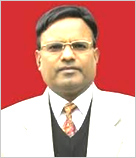
Dr.P.K. Garg delivered a lecture on role of remote sensing and GIS in disaster management. He discussed about Disaster Information and Monitoring Systems which make use of remote sensing data in the operative process of early warning, mitigation and management of natural disasters.

He also desribed how Remote sensing can that assist in damage assessment and aftermath monitoring, providing a quantitative base for relief operations. He also elaborated that, in the disaster rehabilitation phase GIS is used to organise the damage information and the post -disaster census information, and in the evaluation of sites for reconstruction. He elaborated the details of plan form index and how it works. He describes space technology for disaster management in view of pre-disaster and post-disaster.
Dr. S. V. Srinivasan
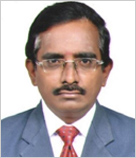
Dr. S. V. Srinivasan, delivered a lecture on Impact of Waste disposal on Climate Change and mitigation options. He clearly explains how most of the rubbish ends up in dumpsites or in landfills. When organic waste decomposes, carbon dioxide and methane gas is created.
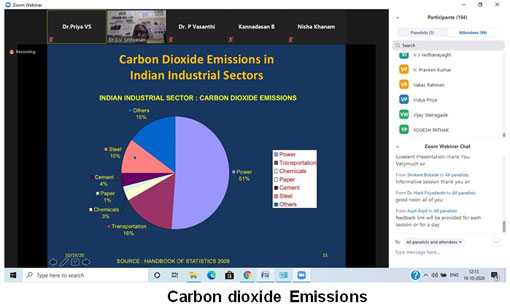
Both carbon dioxide and methane are greenhouse gases, which contribute to global warming and climate change. He also discussed about Kyoto protocol. The Kyoto Protocol is an international agreement that aimed to reduce carbon dioxide (CO2) emissions and the presence of greenhouse gases (GHG) in theatmosphere. The essential tenet of the Kyoto Protocol was that industrialized nations needed to lessen the amount of their CO2 emissions. He elucidates with the statistical data of carbon dioxide emissions in Indian industrial sectors. Finally he concluded with the impacts of climate change and global warming.
DR.S.VASANTHA KUMAR
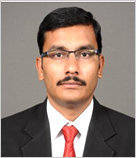
Dr.S.Vasantha Kumar presented a topic on, “A practical demonstration on the role of remote sensing and GIS in Disaster management”. He explains how GIS and remote sensing are incredibly useful and effective tools in disaster management.
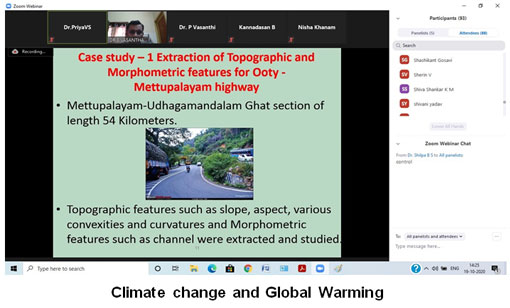
Remotely sensed data can be used very effectively for quickly assessing severity and impact of damage due to, earthquakes, landslides, flooding, forest fires, cyclones and other disasters. In the presentation he clearly explains with the case studies. Particularly the extraction of topographic and morphometric features for Ooty to Mettupalayam highway case study was clearly understandable. He finally explains how Remote sensing can assist in damage assessment and aftermath monitoring, providing a quantitative base for relief operations. In the disaster rehabilitation phase GIS is used to organise the damage information and the post -disaster census information, and in the evaluation of sites for reconstruction.
DR. P. PARTHEEBAN
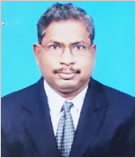

Dr.K.P.Jaya
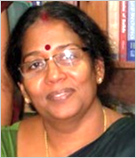
Dr. K.P. Jaya delivered lecture on, ”Earthquake hazards”. In which she explained what are the major earthquake hazards, risk of earthquake, and Importance of studying earthquake hazards. She elaborates that In any given earthquake produced by slip along a fault can produce a number of hazards including ground shaking, liquefaction, ground displacement, fires, and tsunamis.

Ground shaking is simply the vibration of the land surface while liquefaction transforms what was a solid to a liquid‐like state. In contrast, ground displacement is a direct result of the slippage along the fault. These three processes, in combination or acting alone, can produce tremendous damage to buildings and other structures. In some instances, they can rupture dams and gas lines and thus produce flooding and fires. Though such processes are dangerous their ability to affect large numbers of people are limited by the size of the community that the earthquake occurs in or near. In contrast, tsunami produced by earthquakes on distant lands can devastate large regions hundreds of kilometers or miles away.
Dr. S. GANAPATHY VENKATASUBRAMANIAN
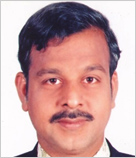
Dr S Ganapathy venkatasubramanian delivered lecture on, “Activities of National Disaster Management Authority”. In which he describes about National Disaster Management Authority, and the activities carried out by them. He explains that the policies, plans and guidelines for Disaster Management to ensure timely and effective response to disasters.
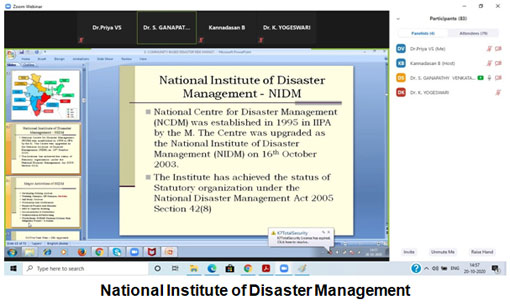
Also it holds the authority to Lay down policies on disaster management, Approves the National Plan, Approve plans prepared by the Ministries or Departments of the Government of India in accordance with the National Plan, Lay down guidelines to be followed by the State Authorities in drawing up the State Plan, Lay down guidelines to be followed by the different Ministries or Departments of the Government of India for the purpose of integrating the measures for prevention of disaster or the mitigation of its effects in their development plans and projects, Coordinate the enforcement and implementation of the policy and plans for disaster management, Recommend provision of funds for the purpose of mitigation, Provide such support to other countries affected by major disasters as may be determined by the Central Government, Take such other measures for the prevention of disaster, or the mitigation, or preparedness and capacity building for dealing with threatening disaster situations or disasters as it may consider necessary, Lay down broad policies and guidelines for the functioning of the National Institute of Disaster Management.
Dr. S. POONGOTHAI
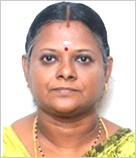
Dr. S. Poongothai delivered lecture on, “Water shed management In Tsunami affected areas using GIS”. In which she explained Watershed management is used to describe the process of implementing land use practices and water management practices to protect and improve the quality of the water and other natural resources within a watershed by managing the use of those land and water resources in a comprehensive manner.
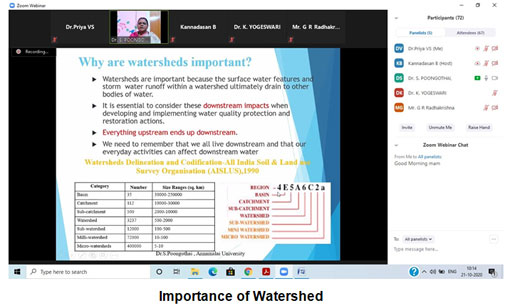
She elaborated the methods of watersheds such as Contour bunding / graded bunding, Check dams and gully control structures, Land levelling / land smoothening, Bench terracing, Farm ponds, Percolation ponds, Waterways, Diversion drains. Also she explains the uniqueness of coastal watersheds and importance of it. Finally she discussed the tools of GIS used in watershed management.
Mr. J. Rooby
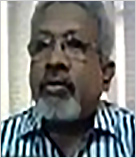
Mr. J. Rooby delivered lecture on, “Disaster due to Nuclear radiation” in which he explains about Disaster Management Guidelines: Management of Nuclear and Radiological Emergencies. He describes how Radiation can either kill cells or damage the DNA within them, which damages their ability to reproduce and can eventually lead to cancer.

When radiation is present, high energy particles pass through your body. These can collide with atoms in your body and disrupt atomic structure. He explained about Emergency Classification Levels, Emergency Classification & Notifications, then he specifically elaborated about Prophylaxis. He finally explains the Emergency Preparedness Plans, Training for Off-site personnel, Site Emergency exercises, EP Programme audits, Corporate Social Responsibility and public awareness activities that followed at kalpakkam nuclear power plant.
K. SYED AMIR BASHA
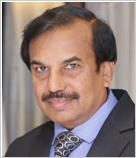
K. Syed Amir Basha delivered lecture on,” Disaster Management and preparedness in Seawater Reverse Osmosis Desalination Plant” in which he explains how is reverse osmosis used in desalination and also explained types of membrane process used for desalination: reverse osmosis (RO) and electro dialysis (ED).

In the RO process, water from a pressurized saline solution is separated from the dissolved salts by flowing through a water-permeable membrane. He discussed about process flow diagram on disaster management in SWRO plants. Finally he elaborated that the Cellulose acetate powder is a fiber derived from wood pulp and according to the researchers, cheap and easy to make in any laboratory. According to that, the membrane can quickly desalinate highly concentrated seawater and purify even badly contaminated seawater.
Er. G.R. RADHA KRISHNA
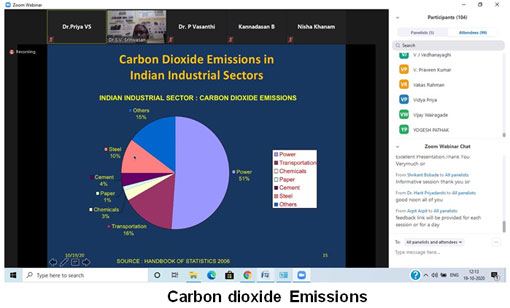
Er. G.R. Radha Krishna delivered lecture on,” Chennai flood 2015: Lesson learned and way forward” in which he explains about storm water drainage system. He emphasized that the area of the Corporation was expanded from 176 sq.km to 426 sq.km in the year 2011. The Population of the Chennai city is fast approaching 1 crore. The Greater Chennai Corporation has taken various steps to provide necessary infrastructure facilities in the newly added areas of the City.
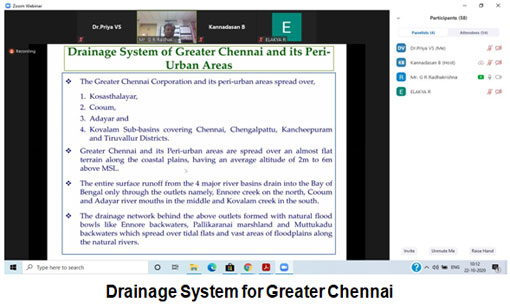
The flat terrain of Chennai City needs effective Storm Water Drainage System to prevent water stagnation in roads, and average level of the land in the city is only 2.0m above the Mean Sea Level (MSL). Because of this flat terrain and tidal effects, flooding and water stagnation happens in the city during the monsoons. In order to mitigate flood from low lying and flood prone areas of Chennai city, it is necessary to provide Storm water drain net work. He finally concluded with the meteorological statistics of Chennai flood 2015 and the details about unprecedented rainfall during Chennai flood 2015.
Dr. C. VELAN
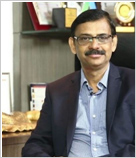
Dr C. Velan delivered lecture on,” Design of Commercial Buildings with Disaster mitigation measures – a case study” in which he explains about Disaster Management which can be defined as the organization and management of resources and responsibilities for dealing with all humanitarian aspects of emergencies, in particular preparedness, response and recovery in order to lessen the impact of disasters.

He also elaborated that the Disaster management plans are multi-layered and are planned to address issues such as floods, hurricanes, fires, mass failure of utilities, rapid spread of disease and droughts. India is especially vulnerable to natural disasters because of its unique geo-climatic condition, having recurrent floods, droughts, cyclones, earthquakes, and landslides. As India is a very large country, different regions are vulnerable to different natural disasters. For example, during rainy season the peninsular regions of South India are mostly affected by cyclones and states of West India experience severe drought during summer.
V. S. KALARANJINI
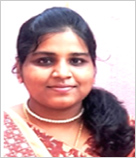
V.S. Kalaranjani is a full time research scholar in the Institute of Remote Sensing (Anna University) with accepted synopsis. Her research interests include Disaster Assessment with Geospatial techniques with particular focus on Space-based SAR data and InSAR technique.
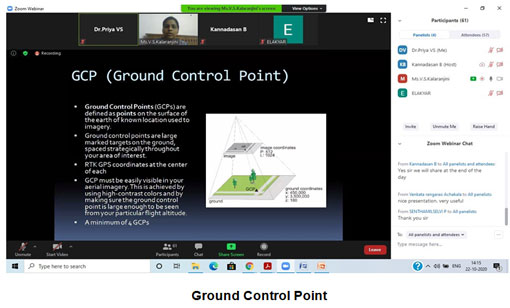
She was awarded with Meritorious Anna Centenary Research Fellowship from the Centre for Research (Anna University) in 2016. She has published the first scientific work on quantitative assessment of South Indian landslides using InSAR. She has presented disaster related papers in National and International Conferences in the recent years. She has visited NGI (Norwegian Geotechnical Institute) at Oslo, Norway as a part of DST-IRS project. She was certified P.G MASTER DIPLOMA IN CADD & BUILDING DESIGN in the year 2012. She was awarded a degree of Rashtrabhasha Praveen (B.A. equivalent) by The Executive Committee of The Dakshina Bharat Hindi Prachar Sabha, Chennai.
V.S. Kalaranjani delivered lecture on,” Role of Advanced survey in Disaster management” in which she explains about Conventional surveying techniques using high precision total stations, GNSS and laser scanners, are instruments of extreme operability but there are still many evident limits on their use especially regarding the survey of both the roofs and the facades of tall buildings or dangerous places, typical in post earthquake situations.Another very important disadvantage of the traditional surveying, especially during the post seismic periods, regards the overall safety of the instruments, operators and workers. In particular, the seismic sequence that may last for months after the main shock, causing collapses and ulterior damage that in most cases can also damage the transport and communication infrastructure creating important problems for all instruments located in that area and definitely posing a further serious risk for all operators. Moreover, some surveys have to be repeated periodically in order to achieve a final result.
Dr. R. BASKAR
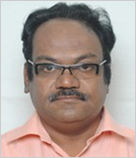
Dr. R. Baskar delivered lecture on, “Important structural elements to protect the steel structures from cyclone” in which he explains about the shape of new buildings and shape is the most important single factor in determining the performance of buildings in cyclones. Simple, compact, symmetrical shapes are best.

The square plan is better than the rectangle since it allows high winds to go around them. The rectangle is better than the L-shaped plan. This is not to say that all buildings must be square. But it is to say that one must be aware of the implications of design decisions and take appropriate action to counter negative features. The best shape to resist high winds is a square. If other shapes are desired, efforts should be made to strengthen the corners. If longer shapes are used, they must be designed to withstand the forces of the wind. Most houses are rectangular and the best layout is when the length is not more than three times the width. Finally he concluded that the good quality of design and construction is the single factor ensuring safety as well as durability in the cyclone hazard prone areas. Hence all building materials and building techniques must follow the applicable Indian Standard Specifications.
Dr. R. RAJAMANIKAM
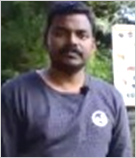
Dr. R. Rajamanikam delivered lecture on,” Solid waste management during disaster” in which he explains about solid waste, objectives of managing solid waste. He emphasized that Disaster waste is a well-recognized threat to health, safety and the environment, and can also be a major impediment to post-disaster rescue operations.
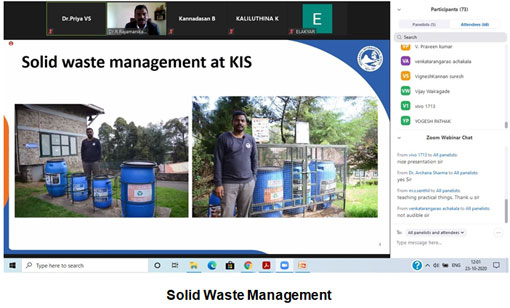
The safe disposal of solid waste is critical for public health, and is especially true during an emergency. Not only will existing collection and disposal systems be disrupted, but there will be extra waste caused by the emergency itself. Initially, for camps of displaced people or refugees and similar new sites, there will be no arrangements in place at all. If solid waste is not dealt with quickly, serious health risks will develop which will further demoralize the community already traumatized by the emergency. This technical note highlights the key issues to consider in managing solid waste during and shortly after a disaster.
Mr. ALLAH PITCHAI K

Mr. Allah Pitchai K delivered lecture on,” Applications of 3D Mapping in Disaster Management” in which he explains about the different dimensions of mapping in disaster management such as human dimensions, physical dimensions. He also explains about monitoring, control AND Resource Management, analysis and assessment studies etc.

He emphasized about Chronic Intelligence such as Past Occurrence, Onset Speed, Frequency of events, Magnitude, Area affected, Terrain info and Demography. He discussed about spatial relations in vulnerable eco-system and its relationship among the Disaster Management.
Dr. S. KOTHANDARAMAN
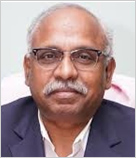
Dr. S. Kothandaraman delivered lecture on,” Keeping Schools safe in Earthquakes” in which he clearly explains about earthquake-prone communities that need earthquake-resistant schools. He elaborated that earthquakes cause the collapse of school buildings and the injury and death of staff and students.
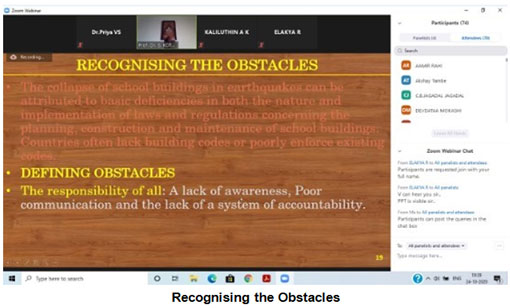
Further, when schools are closed because of earthquake damage, education is hampered, community life disrupted, and potential emergency shelters unavailable. Where school attendance is compulsory, communities have an obligation to provide a safe study and work environment. He also discussed about why do schools collapse even during moderate earthquakes. Experts agree that many collapse due to avoidable errors in design and construction. Often, the needed technology is not applied and laws and regulations are not sufficiently enforced. Application of existing knowledge can significantly lower the seismic risk of schools and help prevent further injury and death of school occupants during earthquakes. Moreover, this can be accomplished at reasonable cost and within a reasonable period.
Feedback Analysis Report
Feedbacks about the STTP were collected from the participants through Google forms for carrying out improvement in the upcoming STTP. Regarding the overall experience of the STTP, nearly 83.3% of the participants found that the training programme was excellent and more than 16.7% of the participants registered that the training programme was good.
Certificate of Participation
The sample participation certificate for the participants is given below

16.11.2020 to 21.11.2020 (6 days)
AICTE sponsored Short Term Training Programme (STTP)–“Disaster mitigation: A shift from disaster management towards disaster preparedness”- Phase-3 was conducted from 16.11.2020 to 21.11.2020 through online mode with the speakers as listed in the below table using Microsoft teams meeting.
| Programme Schedule | ||
|---|---|---|
| 16.11.2020 (Day – 1) | ||
| 10.00AM -11.30 AM | Impact of Urbanization on flooding | Dr. B.V. Mudgal Professor, Centre for Water Resources, Anna University |
| 11.30 AM- 01.00 PM | Understanding Disasters and Resilience: Concepts, Perspectives, Concerns and Experiences | Dr.S.Janakarajan Professional Consultant, MIDS President, SaciWATRs, Chennai |
| 01.00 PM-02.00 PM | Lunch Break | |
| 02.00 PM-03.30PM | Intelligent Transportation systems for Disaster management | Dr. S.Moses Santhakumar, Professor Civil engineering department NIT Trichy |
| 17.11.2020 (Day – 2) | ||
| 10.00 AM-11.30 AM | Mitigation strategies of hydrogen sulphide emission | Dr. V.Preethi Associate Professor Hindustan Institute of Science and Technology, Chennai |
| 11.30 AM – 01.00 PM | GIS Applications in Disaster Management | Dr E.S.M Suresh, Professor & Head, Dept. of Civil and Environmental Engineering National Institute of Technical Teachers Training and Research (Ministry of Education, Govt. of India) Taramani,Chennai. |
| Lunch Break | ||
| 02.00 PM-03.30 PM | Soil Nailing Techniques to encounter land slide Hazards in Hilly area with a case study. | Mr. Karthikeyan A M/S. Karthikeyan Associates Arumbakkam Chennai |
| 18.11.2020 (Day – 3) | ||
| 10.00 AM-11.30 AM | Prevention and control of corrosion in RC structures: Preparedness to avoid major disasters | Dr. M.S. Haji Sheik Mohammed Professor of Civil Engineering, Dean – Academic Affairs, Director – Centre for Prevention and Control of Corrosion in Concrete Structures (PC3S) BSACIST, Chennai |
| 11.30 AM – 01.00 PM | Geospatial technology for urban flood modeling and management | Dr.K.Srinivasaraju Associate Professor, IRS, Anna University |
| 01.00 PM-02.00 PM | Lunch Break | |
| 02.00 PM-03.30 PM | Potential impacts of climate change on reservoir services: Specific reference to Quantity and Quality | Dr. E. Arun Babu Assistant Professor (Sl.Gr) Centre for Water Resources Anna University, Chennai |
| 19.11.2020 (Day – 4) | ||
| 10.00 AM-11.30 AM | Geospatial Technology for Hazard Mapping and Disaster Management. | Dr. R. Jaganathan, Dean, Research Professor and Head Department of Geography School of Earth and Atmospheric Sciences University of Madras,Guindy Campus, Chennai |
| 11.30 AM-01.00 PM | Disaster mitigation of structures | Dr.S.Senthil Selvan Professor, Department of Civil Engineering SRM University, Kattankulathur, Chennai |
| 01.00 PM-02.00 PM | Lunch Break | |
| 02.00 PM-03.30 PM | Early warning systems of IMD: An overview | Dr. S. Balachandran, Scientist F & Head, Regional Meteorological Centre, College Road, Chennai-6. |
| 20.11.2020 (Day – 5) | ||
| 10.00 AM-11.30 AM | Pandemic and Sustainability | Dr. Ambika S Assistant Professor, Environmental Engineering, Civil Engineering Department C-214G, Indian Institute of Technology Hyderabad, Telangana |
| 11.30 AM – 01.00 PM | Impact of Covid-19 Pandemic | Dr. A.Sadhana Rajkumar Nutritionist , Diet and Fitness Consultant |
| 01.00 PM-02.00 PM | Lunch Break | |
| 02.30 PM-04.00 PM | Climate Change: New Dimensions in Disaster Management | Dr. Athira P, Assistant Professor, Department of Civil Engineering, IIT Palakkad |
| 21.11.2020 (Day – 6) | ||
| 10.00 AM-11.30 AM | NDMA guidelines for landslide mitigation | Dr.Vasanthi Padmanabhan Dean School of Infrastructure BSACIST |
Details of Session:
Dr. B.V. Mudgal
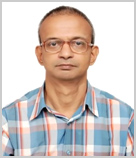
Dr Basavaraj Veeranna Mudgal, deliverd on Impact of Urbanization on flooding. The need for Disaster Preparedness and Flood Assessment in Urban Areas was highlighted in thesession. The need for real time flood modeling and the Emergency Action Plan for Dam Safety was also explained during the session

Dr.S.Janakarajan
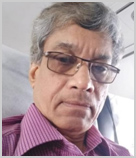
Professor Janakarajan delivered a lecture on Understanding Disasters and Resilience: Concepts, Perspectives, Concerns and Experiences. Professor Janakarajan highlighted the need for Disaster management and discussed the biggest limitation that is the lack of data base.

Some of the important questions related to Resilience was raised and Adaptation challenges was laos highlighted. SLD process to undertake a resilience planning effort along with the case studies was discussed in the session
Dr. S. Moses Santhakumar
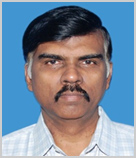
Dr. S. Moses Santhakumar delivered the lecture on the Intelligent Transportation System. The key points discussed during the session includes, the enabling Technologies related to ITS, Geographical Information Systems, GPS. The need for Interface in Transportation Data Acquisition, the importance of Pneumatic road tubes, Traffic Flow Sensors – Non-Intrusive Detectors, Video Image Vehicle Detection System (VIVDS), Automatic Vehicle Identification (AVI) System and Incident Management System with Variable Message Signs was highlighted in the session
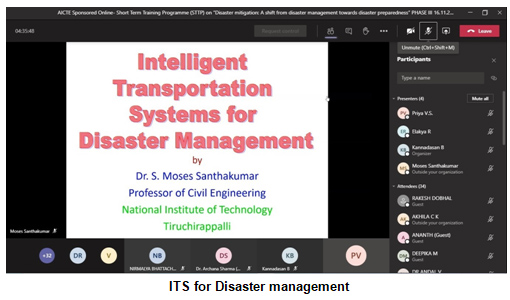
Dr. V.Preethi

Dr.V.Preethi delivered lecture on Mitigation strategies of hydrogen sulphide emission. Some of the key points discussed in the session includes Sources of H2S, Environmental effects of H2S and s2 , Detection of H2S, Conventional techniques for H2S removal Mechanical/operational H2S mitigation techniques, Chemical H2S mitigation techniques etc.

Prof. Dr. E.S.M. SURESH
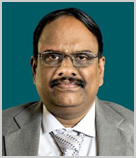
He has conducted more than 300 training programs for Polytechnic College faculty and More than 200 for Engineering College, 10 International Training Programs sponsored by ITEC/TCS/SCAAP (5 in Civil Engineering and 5 in Educational Media).

Dr. E.S.M. Suresh delivered the lecture on GIS Applications in Disaster Management and the few key points discussed includes Disaster management, ICT tools in disaster management, GIS in disaster management, GIS based maps for disaster management(flood), GIS in emergency management, DMS – Space enabled products and services
Mr A.Karthikeyan

Mr A.Karthikeyan Post Graduated, M.E- Soil Mechanics and Foundation Engineering in College of Engineering Guindy, Anna University, Chennai from 1998 to 2000. During school days, Mr A.Karthikeyan received award from “President of India” for the service in The Bharat Scouts & Guides in 1989.
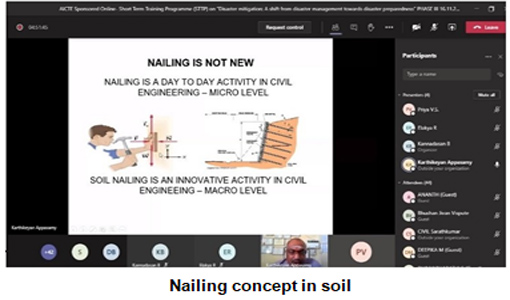
Mr A.Karthikeyan Started his Own Business as an Entrepreneur since 2000. Practicing as a Structural and Geotech. Consultant. Carrier record crosses 1800 projects includes Residential Apartments, Schools, Colleges, Hospitals, Hotels, Temples, Churches, Mosques, Shopping Malls, Industrial buildings, Radio Towers, Earthen Dam, Machine Foundations, Rehabilitation of Structures, Underpinning, Earth Retaining Structures etc., Other than a Design Engineer, Guest faculty for Part time B.E in College of Engineering Guindy, Anna University, Chennai, from 2010 to 2016. Mr A.Karthikeyan delivered the lecture on Soil Nailing Techniques to encounter land slide Hazards in Hilly area with a case study. the important points discussed includes; Soil Nailing, Land slide and its effects, Landslide mitigation, Soil nail techniques, Installation methods of soil nailing.
Dr. M.S. Haji Sheik Mohammed

His immense passion in teaching and ethusiasim raised him to the positions of Professor of Civil Engineering and currently serving as the Dean – Academic Affairs, BS Abdur Rahman Crescent Institute of Science and Technology.

Dr. M.S. Haji Sheik Mohammed delivered the lecture on Prevention and control of corrosion in RC structures: Preparedness to avoid major disasters . the key points discussed includes Corrosion cycle of steel, Cost of corrosion, Mechanism of protection of steel by concrete, Two major causes / types of corrosion in concrete structures, Severe distress due to corrosion
Dr.K.Srinivasaraju

A few key points discussed:
Geomatics, Urban flooding, Mobile laser scanner, 3D city model mapping

Dr. E. Arun Babu

A few key points discussed:
Reservoir Services, Climate Change, Quantity of Reservoir Water, Impact of climate change on Reservoir services, Mathematical and statistical tools used to study impacts of climate change on reservoirs, Case studies and SWAT Modelling

Dr.S.Senthil Selvan
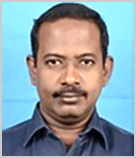
The key points discussed: Why is seismic engineering not widespread?, Cyclones affect houses because of enormously powerful winds, Design and maintenance of house, Basic Design Concepts #1 to #8, Behaviour of RC buildings during earthquake, Structural Design procedure, Disaster and Mitigation of Steel buildings during earthquake

Dr. S. Balachandran

Dr. S.Balachandran joined the India Meteorological Department as operational forecaster in 1992 at Pune. During last 28 years he served in various capacities at different units like Instrumentation, Research, and Operational units of IMD at Pune, Delhi and Chennai. He is a faculty member of training centres of IMD.
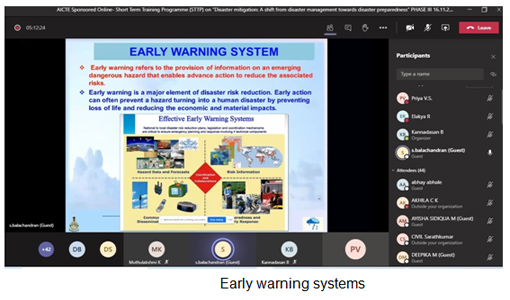
He represented IMD in Technical meetings held at National Hurricane Centre, Florida , USA, South Korea, France, Myanmar and Maldives. He served as working group member of International Tropical cyclone research team. He Served as Member , Board of studies – Physics , Bharathiar University. At present, he is serving as the deputy Director General of Meteorology and Head, Regional Meterological Centre Chennai which is the nodal Centre for weather forecasting services of southern states comprising Tamilnadu, Kerala, Karataka and Andrapradesh. The key points discussed includes Early warning system, Damages due to tropical cyclone, Observational tools, Automatic weather stations.
Dr. Ambika S

A few key points discussed:
COVID – 19 in India, Preventive measures of COVID – 19 in India, Triple Bottom line aspects, Impact of air pollution on pandemic, Pandemic and sustainability

Dr. A.Sadhana Rajkumar
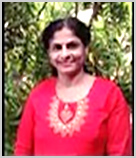
A few key points discussed:
COVID – 19 in India, Preventive measures of COVID – 19 in India, Need for a healthy diet systems, Impact of pollution on pandemic and its impact on health, Sustainability in health
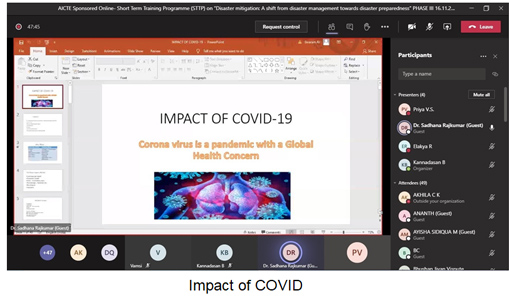
Dr. Athira P
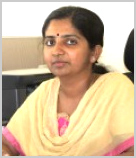
A few key points discussed:
The Human Cost of Disasters 2000-2019, Disaster Risk and Disaster Risk Management Disaster, Risk Drivers, Possible Disaster Risks, Climate Change, DRR and Climate Change Adaptation
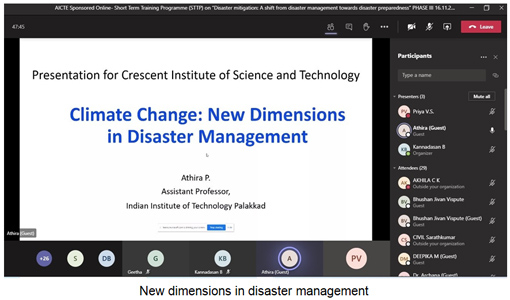
Dr.Vasanthi Padmanabhan
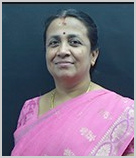
The key points discussed:
Land slide and effects, Landslide effects, Landslides mitigation techniques, Capacity building, PM’s 10 Point agenda

Feedback Analysis Report
Feedbacks about the STTP were collected from the participants through Google forms for carrying out improvement in the upcoming STTP. The analyses of the report are given below.
Regarding the effectiveness of the webinar, nearly 86% of the participants found that the webinar to be excellent and more than 14% of the participants registered that the webinar was good. Overall 98 % found that the STTP was effective.
Certificate of Participation
The sample participation certificate for the participants is given below

“Distribution of Power From Practical Perspective” conducted on 18.07.2020
The Department of Electrical and Electronics Engineering had organized a Webinar on 18.07.2020 on the topic “Distribution of Power From Practical Perspective”. The resource person was Dr. Mohamed Ismail, Manager- HV Distribution, Connection Services Department, Distribution power division, Dubai Electricity and Water Authority (DEWA).

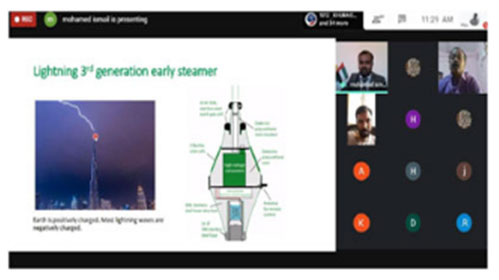
Inauguration of 45th Indian Social Science Congress in association with BSACIST

The inaugural ceremony of XLV Indian Social Science Congress held at B.S.Abdur Rahman Crescent Institute of Science and Technology (Deemed to be University) on March 28 10.00 AM at its Vandalur campus in Chennai. Environment, Energy and Health as its focal theme. The program was started with Tamil Thai Valthu.
Dr. T. Harinarayana, organizing secretary formally welcomed all the dignitaries present on the dais and participants from various parts of the country, colleagues & students. He mentioned about the significance of Indian Social Science Congress and its aims about bringing together a group of researchers from all over India. Prof. D. M. Diwakar, General Secretary Indian Social Science Academy, described the aim of the congress. He emphasized on the scientific inquiry is the solution for the entire problem in the society.
Following new publications were released during the inaugural function of XLV ISSC; 1. Human Future in Digital era (Chief Guest), 2. Social Science Abstract vol.45,2022 (President), 3. Souvenir of XLV Indian Social Science Congress (Chancellor)
Indian Social Science Academy Silver Jubilee P.V.Sukhatme Gold Medal is awarded to Sri P.Sainath for his outstanding contribution to scientific understanding and solutions of problems of hunger, perennial poverty, unemployment and sufferings of people of democratic republic of India. He thanked Indian Social Science Academy for giving this prestigious award in the name of P.V.Sukhatme famous Indian statistician and pioneer in applying random sampling methods in agricultural statistics and in biometry and influential in the establishment of the Indian Agricultural Statistics Research Institute.
The senior journalist of NDTV Ravish Kumar was awarded with ‘BASANT SARKAR GOLD MEDAL’ for upholding and promoting democratic values of equality, freedom and fraternity through honest and scientific journalism fearlessly and boldly. He also thanked Indian Social Science Academy for giving the prestigious award during the congress.
Prof. Dr. Mahadhavan Nair Rajeevan, the former Secretary of Ministry of Earth and Atmospheric sciences, Government of India inaugurated and delivered the inaugural address of the 45th Indian Social Science Congress. He congratulated the Social Science Academy and BSA Crescent Institute for choosing the focal theme Environment, Energy and Health. He focused on the importance of Social science in order to formulate effective solution for society. He said social science can play important role in the entire field by a multidisciplinary approach and social sciences and natural sciences are closely related. He suggested to Government of India to include and involve one social scientist in the big research projects by DST and CSIR.
Dr.G.Parthasarathy, President of Indian Social Science Academy gave his Presidential address on the topic of Minerals- Materials from Nature, and for Nature : Society, Environment and Energy/ Circular Economy. He began his talk by addressing the gatherings and spoke about ISSA and Chinese academy of sciences. He spoke about the Importance of Health by quoting the saying “ Noyatra Vaazhve Kuraivatra Selvam” and further he spoke about the circular Economy and health. He shared few examples from Mineral-World in improving the environmental (Health) conditions and improving the energy needs of our Nation. He said that our Mother Earth has about 4300 Mineral species. Bob Hazen coined the term “Mineral Evolution “. He used this term in the sense of an irreversible sequence of events leading to increasingly complex and diverse assemblages of minerals. He then spoke about Clay Minerals, especially a group of phyllosillicates of tetrahedral (T) and octahedral (O) has its applications in drug carrier and delivery, support for catalyst and fillers for polymeric matrices.
The inaugural function felicitated by Dr. A. Peer Mohamed, Vice Chancellor Dr. A. Azad, Registrar BSA Crescent institute of Science and Technology. In the end, Dr. Raja Hussain, Additional offered a vote of thanks to all the invited guests and participants for gracing the occasion by their solemn presence. He also thanked Indian Social science Academy for providing all kind of support to conduct such congress in the Crescent Institute.
Day – 1 (28.03.2022)
The 45th Indian Social Science Congress was successfully inaugurated on March 28th, 2022. On this historic occasion, the Indian Social Science Academy, as well as dignitaries from the B.S.Abdur Rahman Crescent Institute of Science and Technology, were present. publications were also released. Approximately 500 abstracts were received as a response of the outpouring support from our delegates across the country.
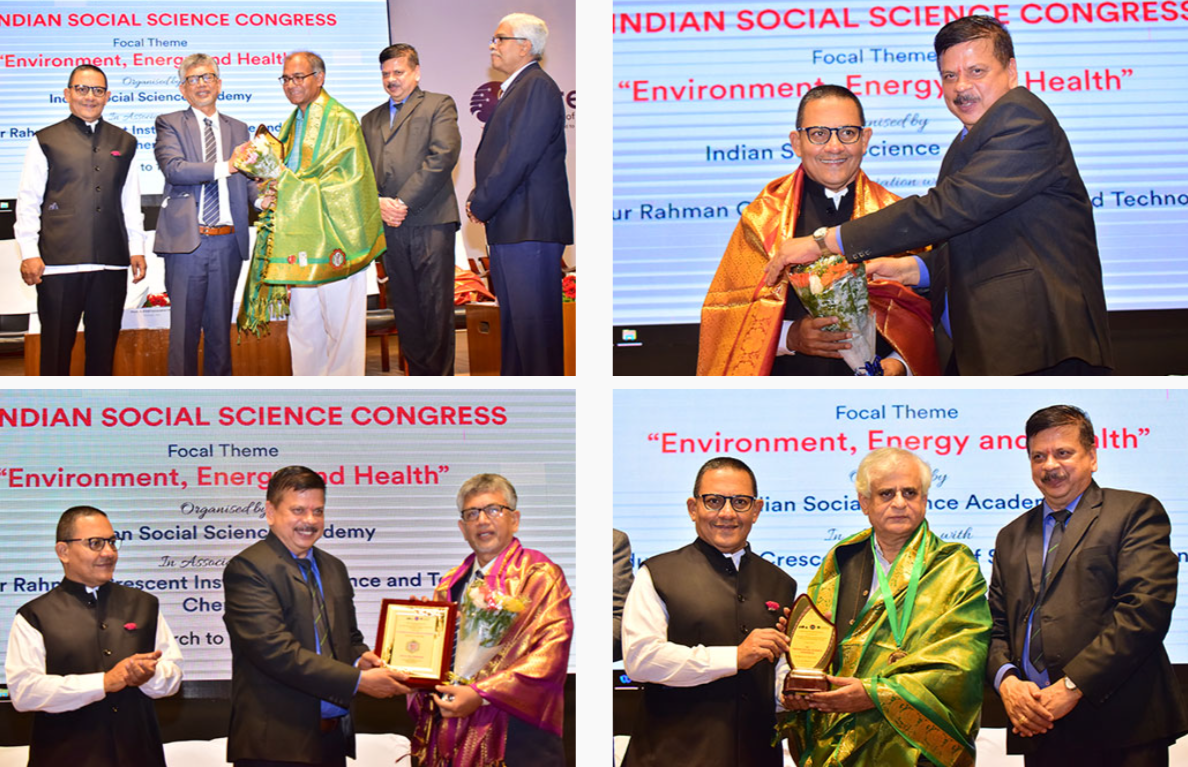
Day – 2 (29.03.2022)
Dr. Gufran Baig of the National Institute of Advanced Studies (NIAS), Indian Institute of Science (IISc) campus, spoke on the “Physics of Air Quality and Climate Change” which was a delightful start to the day. It was a truly eye-opening experience.


Prof. Dr. P. Kaliraj, Vice Chancellor of Bharathiyar University – Coimbatore, discusses the WHO’s Triple Billion Targets, the impact of Industry 4.0 on work, as well as the impact of digital technology on jobs. It was a fantastic session that brought attention of emerging technologies.

Parallel sessions on diverse topics are being held as national seminars and workshops at BSA Crescent Institute of Science and Technology as part of the 45th Indian Social Science Congress.

It’s a magnificent day that began with a session on Sustainable Building Architecture by Dr.R.Velraj, Vice Chancellor – Anna University, Chennai.

Dr. Santosh K Kar, Former Professor School of Biotechnology, Jawaharlal Nehru University, New Delhi, spoke about bettering the health of our citizens and preventing environmental degradation.

Dr. Sankar Kumar Nath, Department of Geology & Geophysics, IIT Kharagpur, led a fascinating debate on Probabilistic Seismic Hazard Assessment of India.

V.N.Bhoraskar, Adjunct & Senior Professor –Dept.of Physics, S.P. Pune University, delivered a brilliant talk on waste water treatment and environmental pollution analysis using radiation technology with a focus on human health.

Prof. Shakeed Ahmed, Maulana Azad National Urdu University, Hyderabad, presented a nature-conscious discourse on ground water conservation.

Dr. Sudha Bhoraskar, Retd.Professor, Dept.of Physics, S.P.Pune University, led a mind-blowing discussion on Plasma Application for Municipal Waste Management with Energy as a By-Product.

Day 3 of the 45th Indian Social Science Congress continuing with the thoughtful and delightful sessions of numerous parallel seminars at B.S.Abdur Rahman Crescent Institute of Science and Technology.
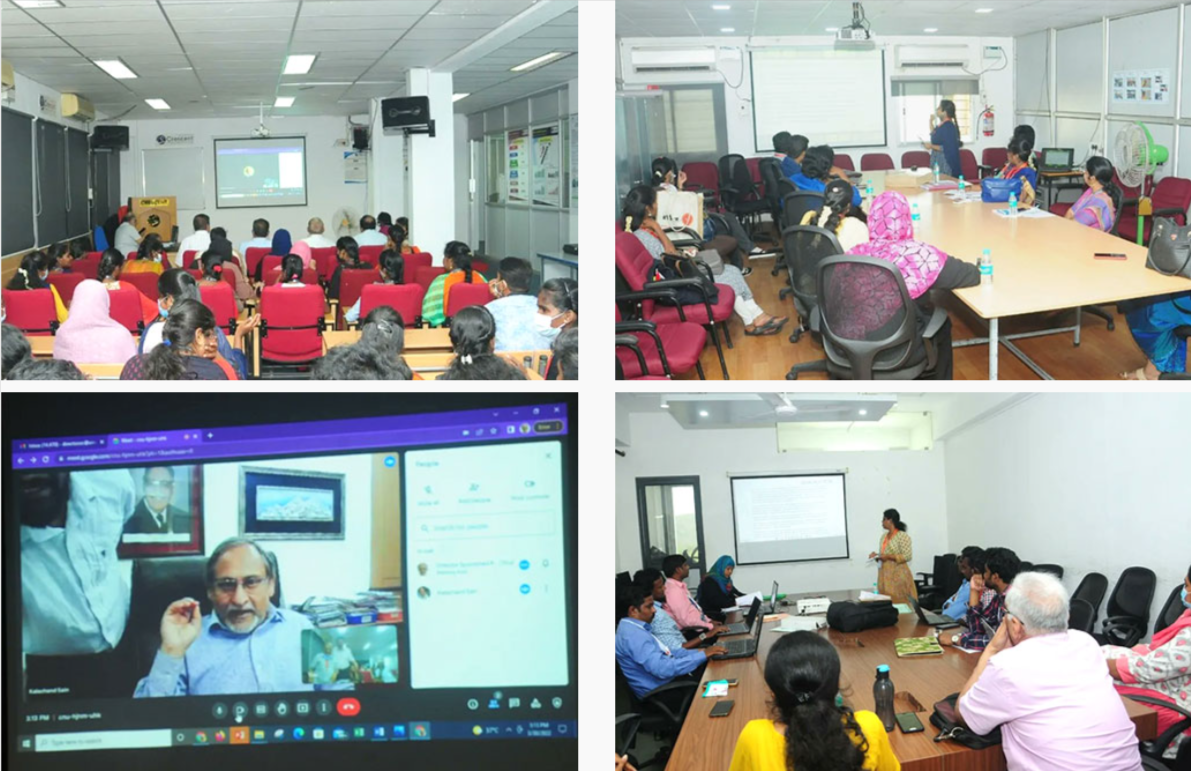
An Indian Journalist, Shri. P. Sainath, gives an interesting and informative speech on “Journalism as a Social Science.” It was genuinely an eye-opening moment.

It is a splendid morning with a dynamic speaker, Dr.A.Venu Gopal, Director, CSIR-NPI, Delhi who spoke on “Metrology for Societal Applications”.

Brigadier P.Ganesham, VSM (Retd.), Founder President – Palle Srujana delivered a remarkable discussion on the Impact of Grassroots Creativity on “Environment, Energy, and Health,” with the intent of giving village innovations a voice, visibility, and velocity.


Day 4 of the 45th Indian Social Science Congress is proceeding at B.S.Abdur Rahman Crescent Institute of Science & Technology, with concurrent symposia and thematic forums by eminent participants.

Day – 5 (01.04.2022)
Day 5 of the 45th Indian Social Science Congress began as tremendous like earlier with the flourishing speech of Dr. Jagannathan, Professor & Head – Dept.of NMR & MRI, AIIMS – New Delhi, On Role of MRI in Medicine and Healthcare.

Dr.Rana Pratap Singh, Director-IQAC & Dean – Academic Affairs, Central University, Lucknow led a fascinating talk on Converting Carbon Source into Carbon Sink

Ms.Keerthana.S.Kumar, a passionate young lady from Delhi University, hosted an engaging session on Disability and Gender Choir.

Dr.Harsha Merchant, Principal-Aishabhai College of Education, Mumbai given a fabulous presentation on Mental Health. It was such indeed an eye-opening session.

BSACIST feel delighted and enthusiastic for this incredible opportunity. As the 45th Indian Social Science Congress comes to an end today, We are privileged to have Dr.A.Venu Gopal Achanta, Director, CSIR-NPL, Delhi as a chief guest along with the dignitaries from ISSC.
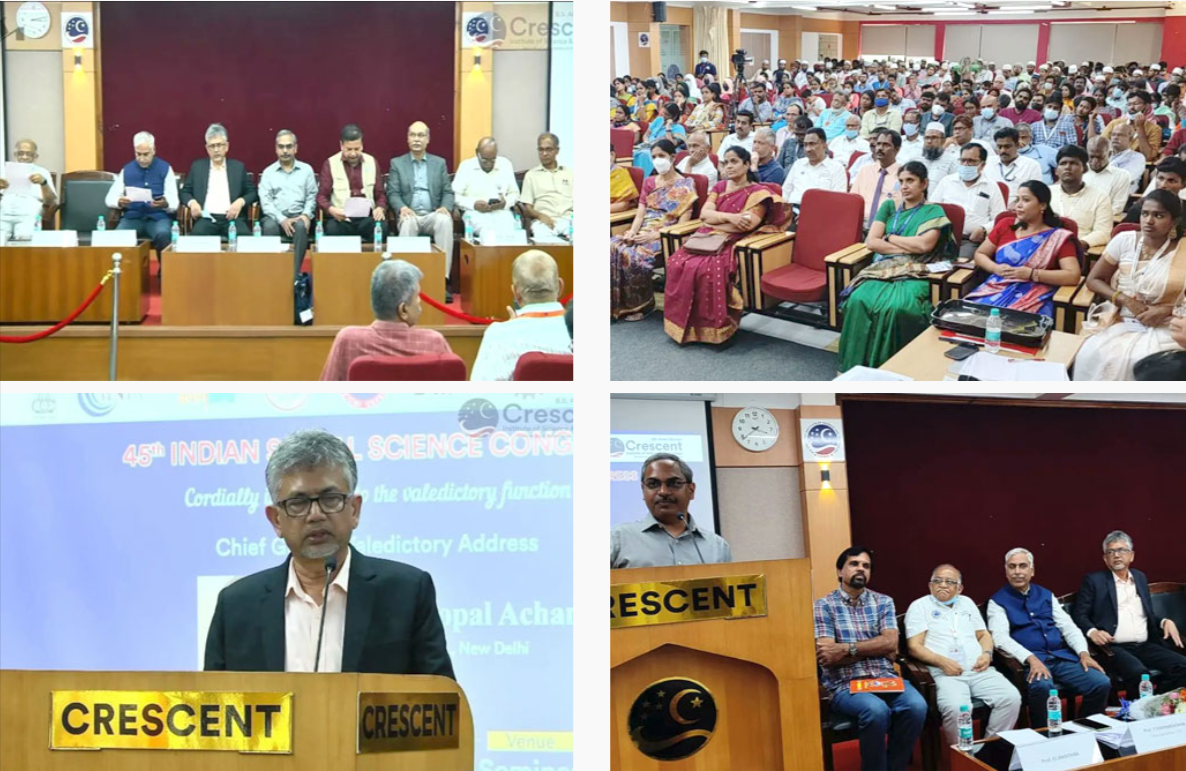
Enhance water-use efficiency comprehensively across various sectors and guarantee the sustainable extraction and provision of freshwater. B.S. Abdur Rahman Crescent Institute of Science and Technology has released guidelines and operational protocols aimed at minimizing water usage.
Maintaining a clean environment is indeed a great place to live. If we keep our premises neat & clean in-turn our mind will be fresh and campus ambiance will be good, therefore we request our staff and students of our campus to drop the waste item in appropriate dustbins placed in the campus.
Water is becoming a costly commodity and 80 % of the water requirements of this campus are met by the out sourced contract. As a result, we are promoting the conscious usage of water by all the stakeholders of the campus viz., students, scholars, faculty members, supporting staff and their families. In addition, awareness programmes such as World Water Day Celebration, Seminar on Water Usage etc., are being regularly organized.
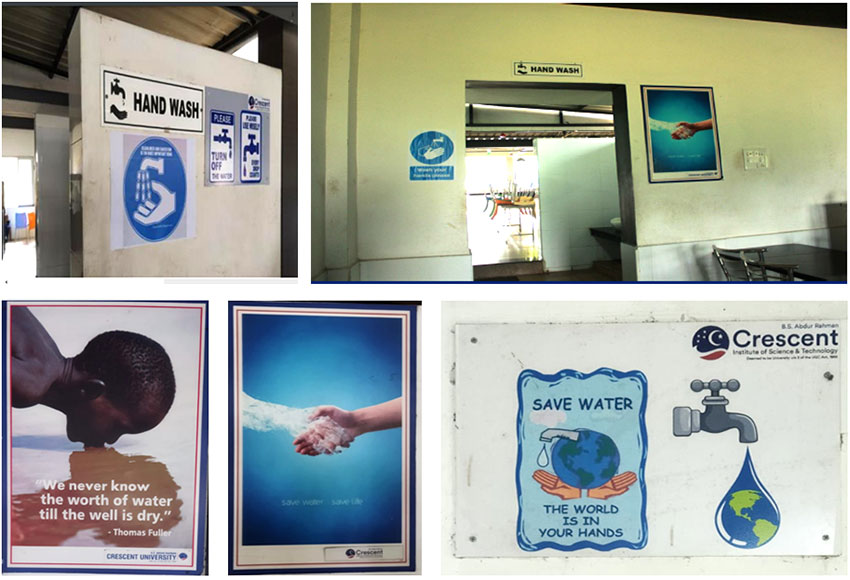
Academic Year 2020-21

World Water Day 2021
The Department of Civil Engineering, School of Infrastructure organized World Water Day 2021, through online on 22.03.2021. Around 83 participants including faculty members and students participated in this programme. The guest speaker Dr.Sekhar Raghavan, Director, Rain Centre, Adyar, Chennai delivered lecture on “Rain Water Harvesting for Urban Areas”, in which he highlighted the importance of Rainwater and its conservation through various methods.
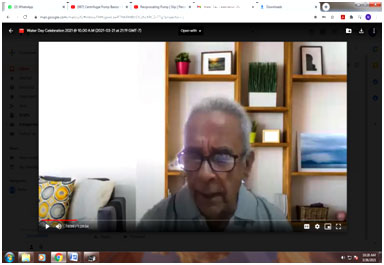
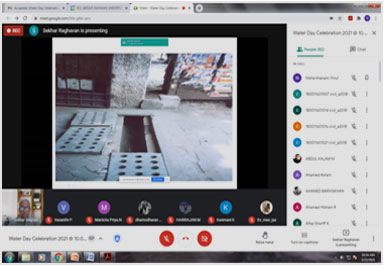
As a part of Jal Sakthi Abhiyan introduced by our Honourable Prime Minister Dr.Narendra Modi, an awareness campaign was done by the team of faculty members and the students at Karanai Puducherry Panchayat in Urapakkam on September 5, 2021 regarding the Safe Water Conservation and to avoid the Single use of plastic.

“Happiness lies in sharing, share a little amount from your total.” We the Rotaract Club of Crescent, sponsored by Rotary Club of Madras Mount (Rotary International District 3232), organized an event “VAWEZ”. Vawez 2022 is a cultural fundraising event for installing mist spray nozzle faucets which help bring down the water wastage by 60 to 80%. We have organized this grand cultural event to SAVE WATER for our future and it’s our responsibility too. With the help of this event, we are going to start this initiative in government schools in and around Chennai. Vawez 2022 – The grand cultural event was held on 24th April 2022 at Santhome Higher Secondary School Auditorium, Mylapore, Chennai with more than 3500+ audience. Rtr. PP. Shivananth is the Chairman of this grand cultural event of the year and we have collaborated with 21 college-based clubs for this cultural event Vawez 2022.

The five days special camp has been organized by the NSS units of BS Abdur Rahman Crescent Institute of Science and Technology at Keerappakam, Arungal, and Murugamangalam panchayaths in the Kattankullathur union of Kanchipuram district of Tamil Nadu during the period of 27.09.2021 to 01.10.2021. There were various programmes and functions were organized under the leadership of the NSS units of the Crescent Institute. Programmes like cleaning of school premises, awareness of healthy food habits, importance of hygiene and sanitation, manuring and irrigation, importance of disaster management, farm pond, rainwater harvesting and conservation methods- and various sports, funs and cultural programmes for the school children’s and for NSS volunteers. The main motives for conducting the special camp is to develop the society, enlighten the villagers and NSS volunteers by giving awareness on various socio-economic issues facing by the downtrodden sections. Around 150 volunteers from the three III units of the NSS Crescent Institute of Science and Technology including boys and girls were actively participated each and every programme conducted in the village as part of special camp.
Valedictory function was organized in the last day of the special camp at the Keerapakkam panchayath middle school premises. The function was inaugurated by our Honourable registrar Dr. A. Azad of BSA Crescent Institute of Science and Technology.
Various program conducted by NSS units of Crescent at Keerappakam, Arungal and Murugamangalam panchayaths

Academic Year 2020-21
NSS Special Camp – Keerappakam, Arungal and Murugamangalam panchayaths, Kanchipuram district
The five days special camp has been organized by the NSS units of BS Abdur Rahman Crescent Institute of Science and Technology at Keerappakam, Arungal, and Murugamangalam panchayaths in the Kattankullathur union of Kanchipuram district of Tamil Nadu during the period of 27.09.2021 to 01.10.2021. There were various programmes and functions were organized under the leadership of the NSS units of the Crescent Institute. Programmes like cleaning of school premises, awareness of healthy food habits, importance of hygiene and sanitation, manuring and irrigation, importance of disaster management, farm pond, rainwater harvesting and conservation methods- and various sports, funs and cultural programmes for the school children’s and for NSS volunteers. The main motives for conducting the special camp is to develop the society, enlighten the villagers and NSS volunteers by giving awareness on various socio-economic issues facing by the downtrodden sections. Around 150 volunteers from the three III units of the NSS Crescent Institute of Science and Technology including boys and girls were actively participated each and every programme conducted in the village as part of special camp.
Valedictory function was organized in the last day of the special camp at the Keerapakkam panchayath middle school premises. The function was inaugurated by our Honourable registrar Dr. A. Azad of BSA Crescent Institute of Science and Technology.
Various program conducted by NSS units of Crescent at Keerappakam, Arungal and Murugamangalam panchayaths

Technical Support For The Community
Automatic Water Tank Level Controller
The Institute support water conservation off campus. The Institute is constantly involved in developing technologies that are aimed to reduce the issues related to water and also to improve its conservation. Research are being conducted by the students and faculty of the Institute in developing sensors, ROBO, etc for various purposes such as water body restoration, reduce the water spillages from sources. The service of the developed technologies is extended to the local community also for supporting water conservation. Some of the initiatives taken by the Institute are given below
- To be a primary support to the rurally backward society by creating innovative and needy technical projects, the students of ECE have developed a controller to reduce water wastage. In order to avoid wastage of water due to overflow from the school water tank an ‘Automatic Water Tank Level Controller’ was completed by Mr.J.Prasanna, Mr.S.Ganesh and Mr.K.Lokeshwaran of ECE (2016-2020 batch) under the guidance of Mrs.K.IndiraGandhi,AP[Sr.Gr]/ECE.
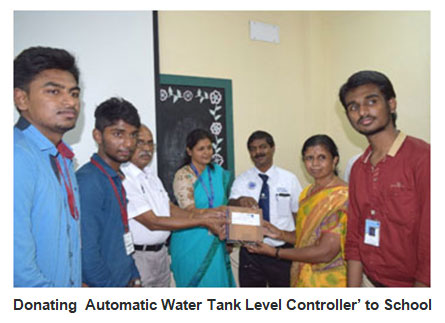
Robo for Pond cleaning
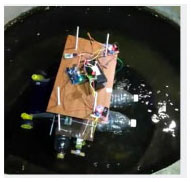
Smart Water Quality Monitoring for Agriculture
Dr. C. Tharini, Professor, serve as Knowledge Expert for the CIIC Start up “Shrimp Hoard Technologies Pvt Ltd” which received Rs 5 Lakhs grant for the project ‘Sensor based smart water quality monitoring for agriculture” from EDII, Govt of Tamilnadu.
SES REC Certificate and Action Plan of Institution
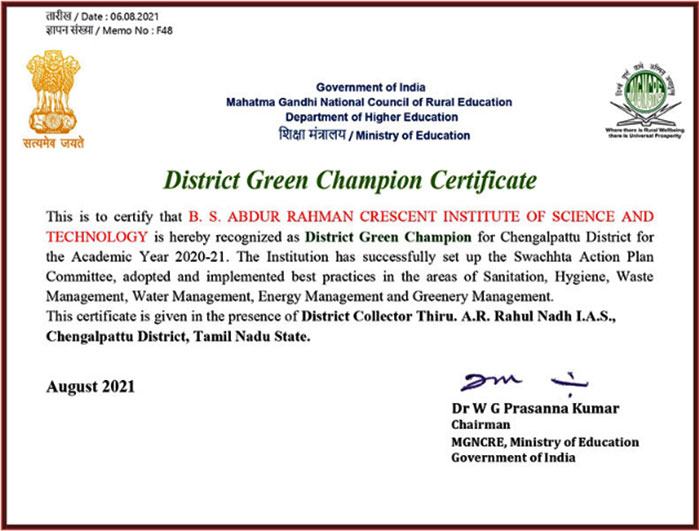
SES REC Action Plan of Institution
B.S.Abdur Rahman Crescent Institute of Science and Technology takes initiatives to maintain sustainability in several aspects such as water reuse, water conservation, rainwater harvesting, implementing sustainable technologies for water and wastewater treatment etc. One of the major source of water supply for the Institute is from well. Sufficient care is taken that the water is drawn from the well at a constant phase and it is not over exploited. It is also ensured that the motors and other pipe appurtenances are in proper function so that the loss of water during extraction is prevented.
As a sustainable approach, the rainwater harvesting pipelines collecting rain water from the Mens Hostel is being redirected to the one of the wells in the Campus. The rainwater collection pipe discharging rainwater into the well is shown in the figure below. This would serve as a sustainable method to recharge the ground water and it would also reduce the burden of the well for the water supply. Hence the rain water can also be harvested and effectively utilized. The solar panels are also fixed on the surface of the wells inorder to capture the energy form the sunlight. It is further utilized for supplying power to the motors used for extracting water from the well. The Solar powered pumping system is also an approach aiming towards sustainability.
- B.S Abdur Rahman Crescent Institute of science and technology is one of the pioneers in implementing solutions to save water.
- The institute has implemented rain water harvesting system in the campus with a strong desire to utilize the rain water at maximum extent.
- The Institute has taken tremendous efforts to reduce the water consumption and also to treat the wastewater generated within the campus so that it can be effectively reused for gardening and toilet flushing.
- In the forefront to save water, our institute of science and technology has initiated and executed the rainwater harvesting in the campus.
- Rainwater harvesting facility is done in all blocks to collect rainwater from the roof of all buildings.
- The harvested water is diverted to open wells in institute campus, Men’s Hostel and ladies hostel.
- The placement of rainwater facility within the campus is decided upon by considering the profile of the land so as to drain the maximum amount of water collected with ease.
- In the buildings, sufficient plumbing connections are provided to trap the rain water from the roof tops.
- Underground connections are ensured to connect the collected water from the roof top to the rainwater recharge pit.
- It was also ensured that the rainwater harvesting structures are constructed as per the norms. The recharge pit provided to collect the rain water is series of filter bed.
- This initiative took shape when the institute faced shortage of water during summer. Cost of buying water was becoming a financial burden. The only alternative to the water crisis was to use the available water more effectively.
- The features of the recharge pit are described below.
- A mesh is provided at the inlets of rain water pipes so that solid waste/debris is prevented B.S.Abdur Rahman Crescent Institute of Science and Technology has taken initiatives to install rain water harvesting pits in the campus from entering the pit system.
- The recharge pits are of size 2m x 2m x 2m is excavated
- The recharge pit comprises different set of filter media. The filter media comprises of thick layers of boulders at the bottom followed by layers of gravels and coarse sand.
- This enables the filtration of water and also prevents the deposition of silt on the recharge pit.
- Access Manhole frames and covers are provided.
- The rain water is also stored in Underground sumps of Life Science block, Mechanical Science Block and New Staff Quarters.
B.S. Abdur Rahman Crescent Institute of Science and Technology has taken initiatives to install rain water harvesting pits in the campus.
Rainwater harvesting facility is done in all blocks to collect rain water from the terrace. The harvested water is diverted to open wells in institute campus, Men’s Hostel and ladies hostel. The rain water is also stored in Underground sumps of Life Science block, Mechanical Science Block and New Staff Quarters. The rain water is stored after passing through the pre-filter as shown in Figure below.
| S.No | CAMPUS/BLOCKS | Number of Rain Water Harvesting | Quantity of Water Collected(L) |
|---|---|---|---|
| 1 | College/Life Sciences Block | 1 | 10000 (Approx) |
| 2 | New Architecture Block | 1 | 10000 (Approx) |
| 3 | Computer Science block | 1 | 10000 (Approx) |
| 4 | Pharmacy Block | 1 | 10000 (Approx) |
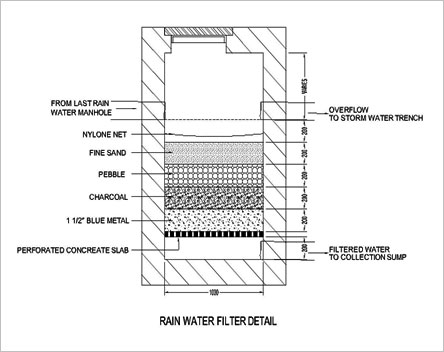
The special features of the filtration unit connected with the rain water harvesting system is given as follow

Special Features
- Dual Intensity Filter works on the principle of cohesive & centrifugal force.
- Works on Gravitational force (No external energy required)
- Compact in size and wall mounted
- Automatic flush out of dirt particles
- Flexibility in pipe connection to any angle and degree
- Provision of bypass valve
In our Institute Rainy filter –FL 500 is used as part of the rainwater harvesting system. The technical specifications of Model FL 500 is given below
Rainy Filter – FL 500
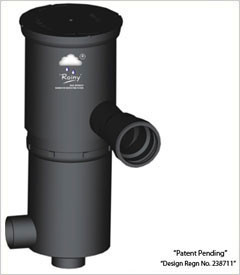 | Suitable up to area: | 500 SQMTRS |
| Max: Intensity of Rainfall: | 75 mm/hr | |
| Working Principle : | Cohesive Force & Centrifugal force | |
| Operating Pressure: | Less than 2 feet of head (0.060kg/cm2) | |
| Capacity: | 480 LPM | |
| Filter Element: | SS-304 Screen | |
| Mesh Size: | 250 Microns | |
| Inlet: | 110 MM | |
| Clean Water Outlet: | 90 MM | |
| Drain Outlet: | 110 MM | |
| Housing: | High Density Polyethylene | |
| Efficiency of Filter: | Above 90% | |
| Source of Power: | Gravity |
The characteristic features of FL Series Dual Intensity RWH Filter are its capacity to take up the load up to 10 to 500 square meters of Roof area with variable intensity of rainfall of 5 to 75 mm/ hour with a discharge capacity of 10 To 480 Liters per minute.
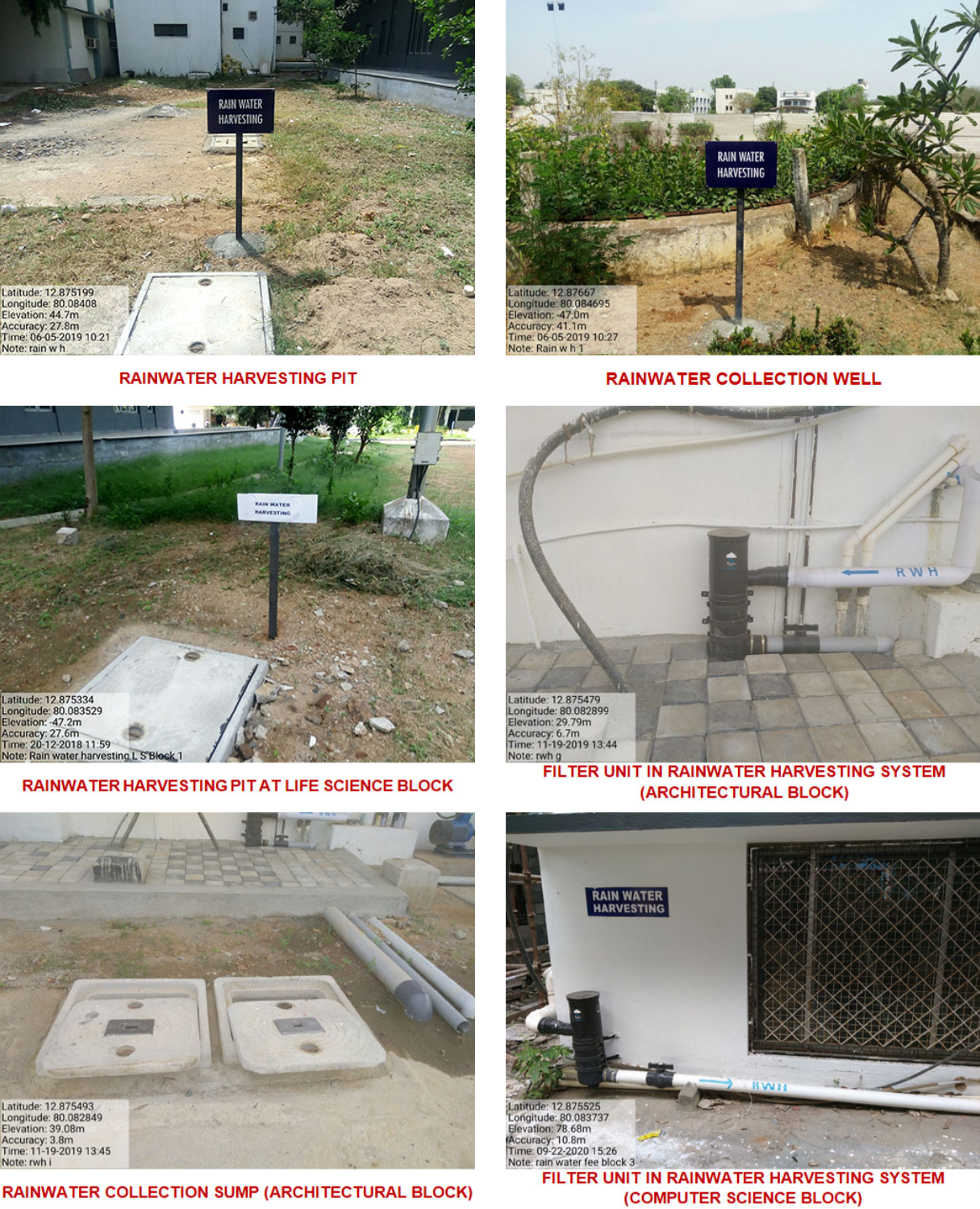
Academic Year 2020-21
As a sustainable approach, the rainwater harvesting pipelines collecting rain water from the Mens Hostel is being redirected to the one of the wells in the Campus. The rainwater collection pipe discharging rainwater into the well is shown in the figure below. This would serve as a sustainable method to recharge the ground water and it would also reduce the burden of the well for the water supply. Hence the rain water can also be harvested and effectively utilized.
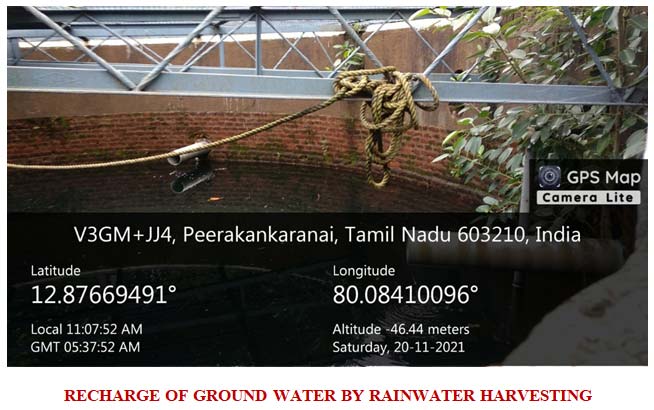
The solar panels are also fixed on the surface of the wells inorder to capture the energy form the sunlight. It is further utilized for supplying power to the motors used for extracting water from the well. The Solar powered pumping system is also an approach aiming towards sustainability

In our institution, one part of water is extracted from 3 bore wells and remaining part of water requirement is fulfilled by water Lorries. Water Lorries ferrying drinking water from the nearby areas, in addition to own resources of the institute available in the campus.
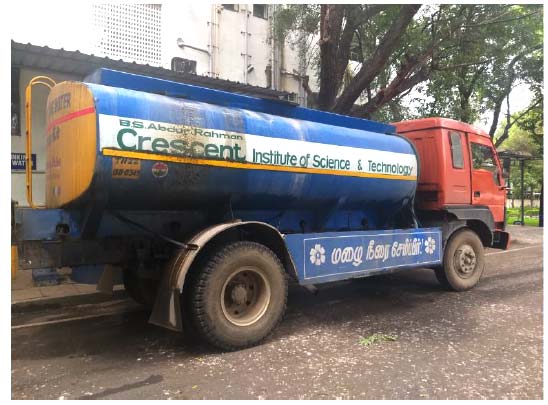
| Sl.No. | Month / Year | No.of Loads | Total Qty. in (Ltrs.) | Annual Total Consumption |
|---|---|---|---|---|
| 1 | Jun-20 | 561 | 56,10,000 | 5,87,40,000 litres (58,740 m3) |
| 2 | Jul-20 | 408 | 40,80,000 | |
| 3 | Aug-20 | 471 | 47,10,000 | |
| 4 | Sep-20 | 409 | 40,90,000 | |
| 5 | Oct-20 | 437 | 43,70,000 | |
| 6 | Nov-20 | 229 | 22,90,000 | |
| 7 | Dec-20 | 57 | 5,70,000 | |
| 8 | Jan-21 | 147 | 14,70,000 | |
| 9 | Feb-21 | 741 | 74,10,000 | |
| 10 | Mar-21 | 1120 | 1,12,00,000 | |
| 11 | Apr-21 | 755 | 75,50,000 | |
| 12 | May-21 | 539 | 53,90,000 | |
| 13 | Jun-21 | 510 | 51,00,000 | |
| 14 | Jul-21 | 503 | 50,30,000 | |
| 15 | Aug-21 | 622 | 62,20,000 | |
| 16 | Sep-21 | 968 | 96,80,000 | |
| 17 | Oct-21 | 875 | 87,50,000 | |
| 18 | Nov-21 | 638 | 63,80,000 | |
| 19 | Dec-21 | 972 | 97,20,000 |
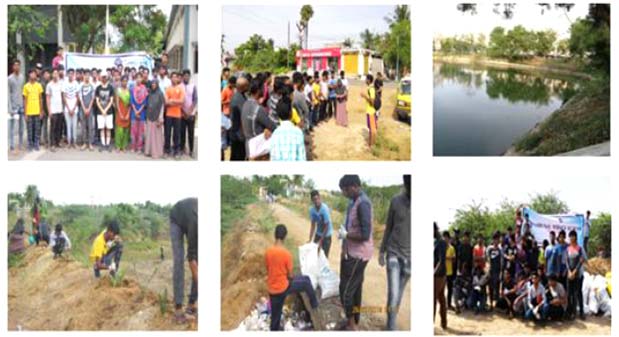
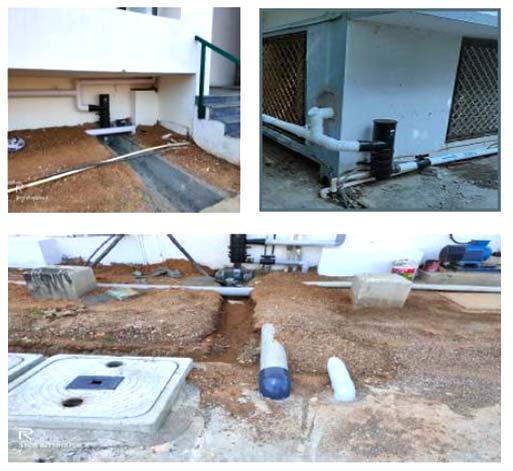
The vital and limited resource of water plays a crucial role in ensuring human security within the context of the environment. Freshwater sustainability emerges as the foremost challenge in sustainable development due to its significance as our planet’s most precious and finite resource. The risks to economies, societies, and the environment escalate when a community’s water resources become scarce or vulnerable. To address the competing demands for this finite resource, a proactive integrated management approach becomes essential. Achieving water sustainability requires a collaborative, community-driven effort with active articipation from all community members. The objective is to formulate innovative and well-coordinated water management plans that prioritize value creation and security for all stakeholders.

BSACIST follows,
- Ministry of Jal Shakthi, Guidelines to regulate and control Ground Water Extraction in India and Other Water related Standards https://jalshakti-dowr.gov.in/
- Tamil Nadu Government Act – Regulation of water for irrigation and drinking water needs and Flood control measures. https://cms.tn.gov.in/sites/default/files/documents/wrd_e_cc_2022_23.pdf
- The Rain Water Harvesting movement launched in 2001 was the brainchild of the Honourable Chief Minister. It has had a tremendous impact in recharging the groundwater table all over Tamil Nadu. Amendments made to Section 215 (a) of the Tamil Nadu District Municipalities Act, 1920 and Building Rules 1973, have made it mandatory to provide RWH structures in all new buildings. To consolidate the gains, various measures have been taken up for rejuvenation of RWH structures created already in both public and private buildings, besides creating new ones. IEC activities will be continued in the Town Panchayats to sensitize all the stake holders to sustain the momentum. During 2011-12, in order to give a fillip to this laudable programme, the Town Panchayats have undertaken the construction of new RWH structures and renovation of old RWH structures. IEC activities are being carried out in Town Panchayat areas to sustain the momentum of the programme.

Action taken by BSACIST as per the Recommendations of the Audit Report
Utilize more amount of treated water from STP plant since most of the approving agencies like AICTE, UGC etc., are now requesting to utilize the treated water. https://crescent.bytdigital.com/iqac-csi-sdg6-2021-23/#wwtp
To check the quantity of water utilized by each buildings by connecting digital water flow meter and optimize the water usage

- Similar to raw water measurement; water inlet to the STP & treated STP water pipe line must be fitted with flow meter and check the quantity of inlet & outlet water
- Prepare and maintain a Single Line Diagram (SLD) for water distribution network

- Paste water and energy saving slogans at appropriate places https://crescent.bytdigital.com/iqac-csi-sdg6-2021-23/#pcwu
- Bio-Sewage Treatment Plant as it reduces the amount of energy required to operate the plant and environmental friendly operation

- Captures almost 100 % rain water harvesting through i) Recharging pits and ii) Open well type storage pits https://crescent.bytdigital.com/iqac-csi-sdg6-2021-23/#swec
- Water treatment log maintained indicating the water inlet, treated and outlet water quantity

- Set a policy and fix a target for usage of treated water; ensure that the plan is being executed without any deviation. Increase the percentage of usage of treated water year by year https://crescent.bytdigital.com/wp-content/uploads/2022/11/SDG-6-6.4.1-Water-Management-and-Reuse-Policy.pdf
- Awareness campus must be conducted to all the stakeholders at regular interval. Thorough this initiative; Painting, Photography, Slogan and Poster making contest are conducted to create consciousness among the students and the faculties.
Water is becoming a costly commodity and 80 % of the water requirements of this campus are met by the out sourced contract. As a result, we are promoting the conscious usage of water by all the stakeholders of the campus viz., students, scholars, faculty members, supporting staff and their families. In addition, awareness programmes such as World Water Day Celebration, Seminar on Water Usage etc., are being regularly organized.

https://crescent.bytdigital.com/iqac-csi-sdg6-2021-23/#wmeo
https://crescent.bytdigital.com/iqac-csi-sdg6-2021-23/#owcs
Academic Year 2020-21
- B.S Abdur Rahman Crescent Institute of science and technology is one of the pioneers in implementing solutions to save water.
- The institute has implemented rain water harvesting system in the campus with a strong desire to utilize the rain water at maximum extent.
- The Institute has taken tremendous efforts to reduce the water consumption and also to treat the wastewater generated within the campus so that it can be effectively reused for gardening and toilet flushing.
- In the forefront to save water, our institute of science and technology has initiated and executed the rainwater harvesting in the campus.
- Rainwater harvesting facility is done in all blocks to collect rainwater from the roof of all buildings.
- The harvested water is diverted to open wells in institute campus, Men’s Hostel and ladies hostel.
- The placement of rainwater facility within the campus is decided upon by considering the profile of the land so as to drain the maximum amount of water collected with ease.
- In the buildings, sufficient plumbing connections are provided to trap the rain water from the roof tops.
- Underground connections are ensured to connect the collected water from the roof top to the rainwater recharge pit.
- It was also ensured that the rainwater harvesting structures are constructed as per the norms. The recharge pit provided to collect the rain water is series of filter bed.
- This initiative took shape when the institute faced shortage of water during summer. Cost of buying water was becoming a financial burden. The only alternative to the water crisis was to use the available water more effectively.
- The features of the recharge pit are described below.
- A mesh is provided at the inlets of rain water pipes so that solid waste/debris is prevented B.S.Abdur Rahman Crescent Institute of Science and Technology has taken initiatives to install rain water harvesting pits in the campus from entering the pit system.
- The recharge pits are of size 2m x 2m x 2m is excavated
- The recharge pit comprises different set of filter media. The filter media comprises of thick layers of boulders at the bottom followed by layers of gravels and coarse sand.
- This enables the filtration of water and also prevents the deposition of silt on the recharge pit.
- Access Manhole frames and covers are provided.
- The rain water is also stored in Underground sumps of Life Science block, Mechanical Science Block and New Staff Quarters.
RAIN WATER HARVESTING STRUCTURES AND UTILIZATION IN THE CAMPUS
B.S. Abdur Rahman Crescent Institute of Science and Technology has taken initiatives to install rain water harvesting pits in the campus.
Rain Water Harvesting
Rainwater harvesting facility is done in all blocks to collect rain water from the terrace. The harvested water is diverted to open wells in institute campus, Men’s Hostel and ladies hostel. The rain water is also stored in Underground sumps of Life Science block, Mechanical Science Block and New Staff Quarters. The rain water is stored after passing through the pre-filter as shown in Figure below.
| S.No | CAMPUS/BLOCKS | Number of Rain Water Harvesting | Quantity of Water Collected(L) |
|---|---|---|---|
| 1 | College/Life Sciences Block | 1 | 10000(Approx) |
| 2 | New Architecture Block | 1 | 10000 (Approx) |
| 3 | Computer Science block | 1 | 10000 (Approx) |
| 4 | Pharmacy Block | 1 | 10000 (Approx) |

The special features of the filtration unit connected with the rain water harvesting system is given as follow

Special Features:
- Dual Intensity Filter works on the principle of cohesive & centrifugal force.
- Works on Gravitational force (No external energy required)
- Compact in size and wall mounted
- Automatic flush out of dirt particles
- Flexibility in pipe connection to any angle and degree
- Provision of bypass valve
In our Institute Rainy filter –FL 500 is used as part of the rainwater harvesting system. The technical specifications of Model FL 500 is given below
Rainy Filter – FL 500
Technical Specifications & Parameters of Model FL 500
 | Suitable up to area: | 500 SQMTRS |
| Max: Intensity of Rainfall: | 75 mm/hr | |
| Working Principle : | Cohesive Force & Centrifugal force | |
| Operating Pressure: | Less than 2 feet of head (0.060kg/cm2) | |
| Capacity: | 480 LPM | |
| Filter Element: | SS-304 Screen | |
| Mesh Size: | 250 Microns | |
| Inlet: | 110 MM | |
| Clean Water Outlet: | 90 MM | |
| Drain Outlet: | 110 MM | |
| Housing: | High Density Polyethylene | |
| Efficiency of Filter: | Above 90% | |
| Source of Power: | Gravity |
The characteristic features of FL Series Dual Intensity RWH Filter are its capacity to take up the load up to 10 to 500 square meters of Roof area with variable intensity of rainfall of 5 to 75 mm/ hour with a discharge capacity of 10 To 480 Liters per minute.
RAIN WATER HARVESTING STRUCTURES IN CAMPUS

Rainwater harvesting facility is done in all blocks to collect rain water from the terrace. The details are listed below.
Rain Water Harvesting Details
| S.No | Inlet Pit Detail | Area (sq. m) | Rain water filter capacity ( Litres) | Location |
|---|---|---|---|---|
| 1 | Inlet pit-1 | 156 | 200 | Mechanical Science Block |
| Inlet pit-2 | 122 | 200 | ||
| Inlet pit-3 | 296 | 300 | ||
| Inlet pit-4 | 175 | 200 | ||
| Inlet pit-5 | 243 | 300 | ||
| 2 | Inlet pit-1 | 191 | 200 | Ladies Hostel-New Block |
| Inlet pit-2 | 188 | 200 | ||
| Inlet pit-3 | 132 | 200 | ||
| 3 | Inlet pit-1 | 68 | 100 | New Staff quarters |
| Inlet pit-2 | 65 | 100 | ||
| Inlet pit-3 | 81 | 100 | ||
| Inlet pit-4 | 66 | 100 | ||
| Inlet pit-5 | 81 | 100 | ||
| Inlet pit-6 | 66 | 100 | ||
| 4 | Inlet pit-1 | 61 | 100 | Men’s Hostel-A&B BLOCK |
| Inlet pit-2 | 71 | 100 | ||
| Inlet pit-3 | 43 | 100 | ||
| Inlet pit-4 | 132 | 200 | ||
| Inlet pit-5 | 132 | 200 | ||
| Inlet pit-6 | 43 | 100 | ||
| Inlet pit-7 | 71 | 100 | ||
| Inlet pit-8 | 61 | 100 | ||
| 5 | Inlet pit-1 | 297 | 300 | Men’s Hostel -C& D BLOCK |
| Inlet pit-2 | 297 | 300 | ||
| 6 | Inlet pit-1 | 71 | 100 | Men’s Hostel -PG BLOCK |
| Inlet pit-2 | 71 | 100 | ||
| Inlet pit-3 | 71 | 100 | ||
| Inlet pit-4 | 71 | 100 | ||
| Inlet pit-5 | 71 | 100 | ||
| Inlet pit-6 | 71 | 100 | ||
| Inlet pit-7 | 71 | 100 | ||
| Inlet pit-8 | 71 | 100 | ||
| 7 | Inlet pit-1 | 275 | 300 | Pharmacy Block |
| 8 | Inlet pit-1 | 340 | 300 | Library Block |
Department of Electronics and Communication Engineering
| Name of the Scheme | Corporate Social Responsibility (CSR) scheme |
| Funded By | Jasmin Infotech Pvt Ltd, Chennai |
| Client | Saranalayam Old Age Home, Mannivakkam , Chennai |
| Project Implementation | Department of ECE, B.S.Abdur Rahman Crescent Institute of Science & Technology (BSACIST), Chennai. |
| SDGs Addressed | SDG 3, SDG 7, SDG 9, SDG 10 |
The department of ECE received the fund Rs 1.5 Lakh from Jasmin Infotech Pvt Ltd Chennai under CSR scheme to implement the project titled “Digital Assistance to Saranalayam old age Home”.
Interaction with Saranalayam old age Home
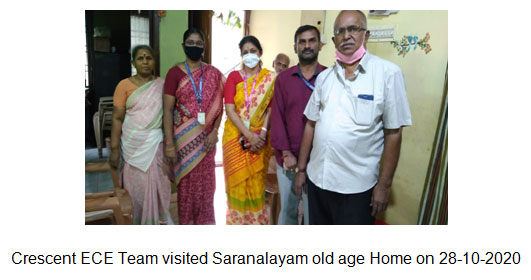
Crescent Team: Dr C.Tharini, Professor & Head, BSACIST, Dr G Kannan, Associate Professor, BSACIST, Ms Padma Usha, Asst Professor (Sr.Grade), BSACIST
Interaction with : Thiru. J.Manikumar, Managing Trustee, Saranalayam, Ms N.Nithya, Care Taker, Saranalayam
Based on the interaction with Saranalayam old age home administrator and care taker the following projects were implemented.
Implementation of Surveillance Cameras in Saranalayam Old age Home with support of Social technical Services club students of ECE department.


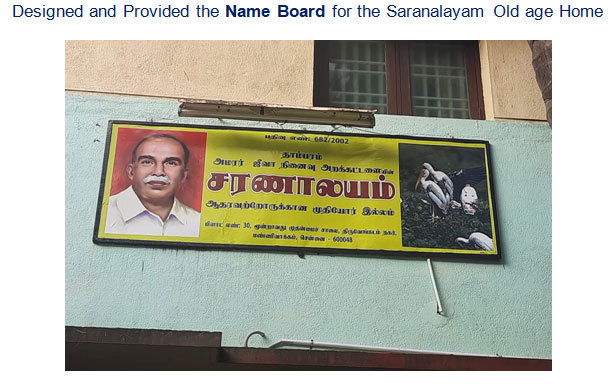
Implementation of Automatic Water Level Controller with the help of our student team along with faculty mentor of B.S.Abdur Rahman Crescent Institute of Science & Technology.


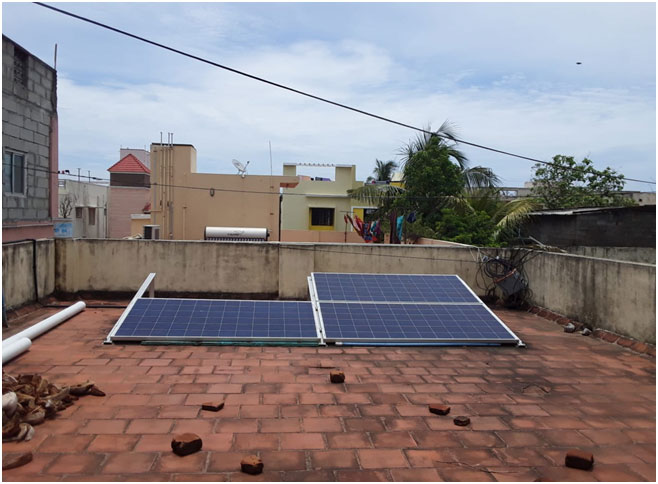

The department of ECE is very much thankful to the Jasmin Infotech Pvt Ltd, for the continuous support and guidance
R. World Institutional Ranking

Swachh Campus Ranking 2019 – Ranking
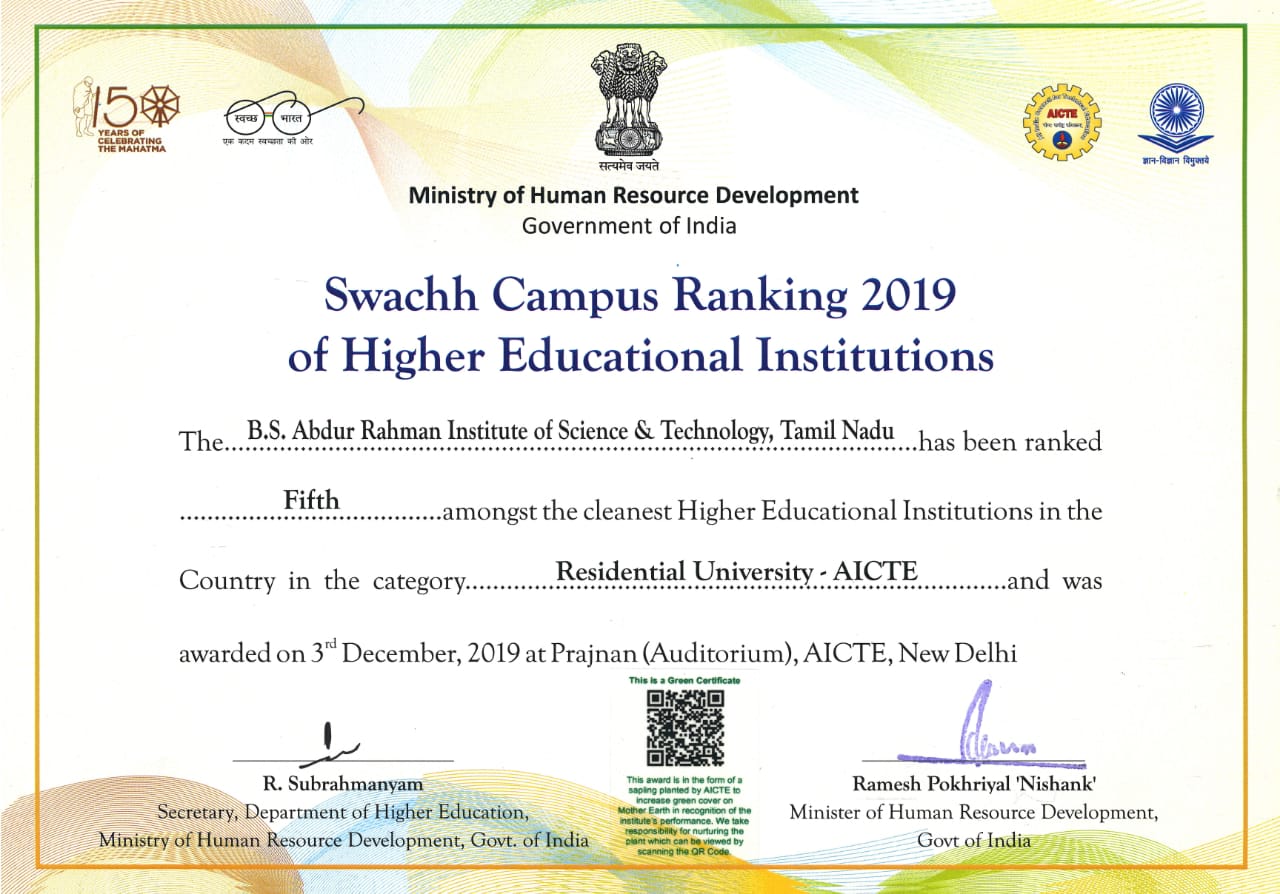
Clean Campus Award 2019 – Appreciation
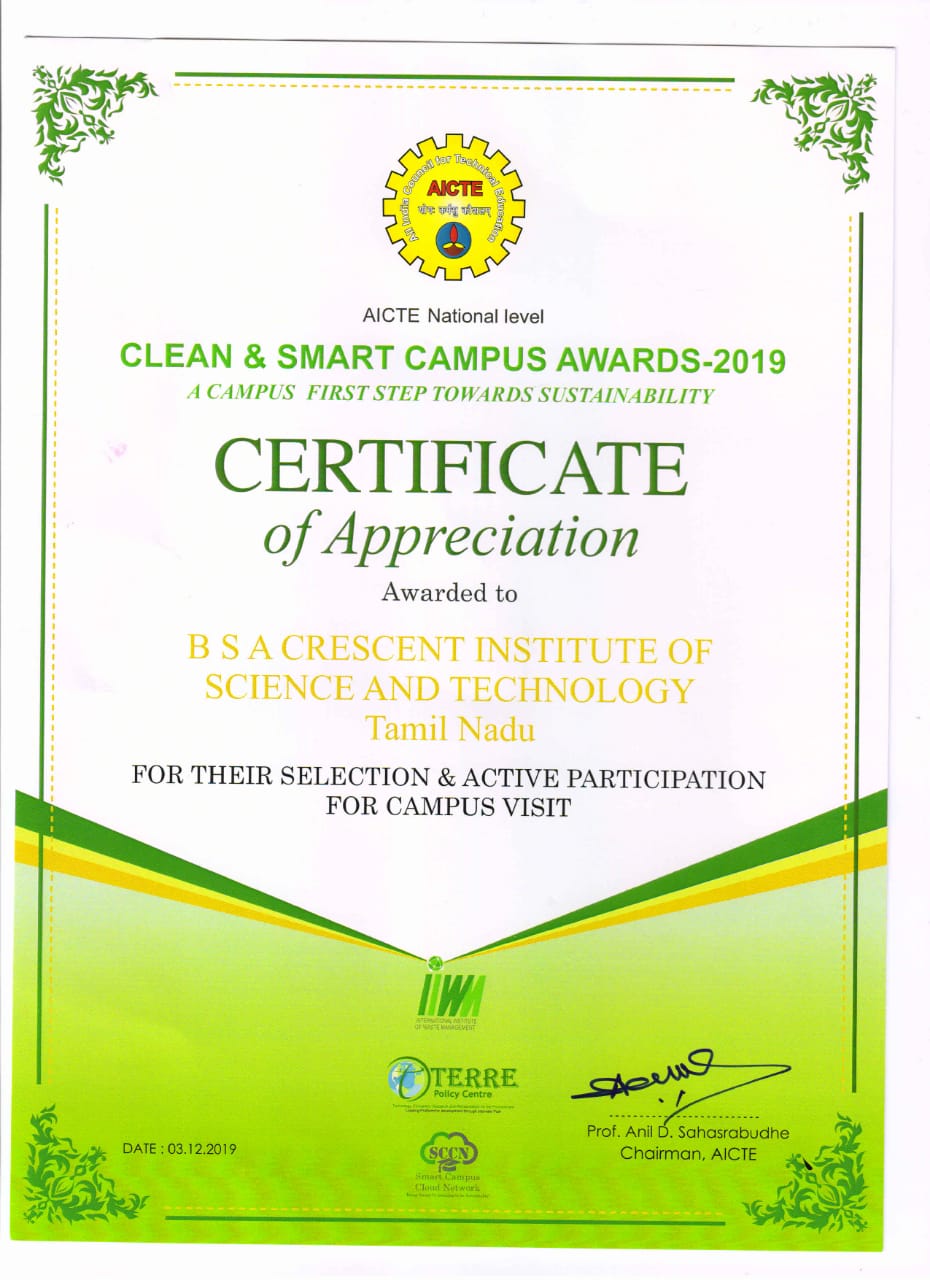
Jal Shakti Abhiyan – Appreciation
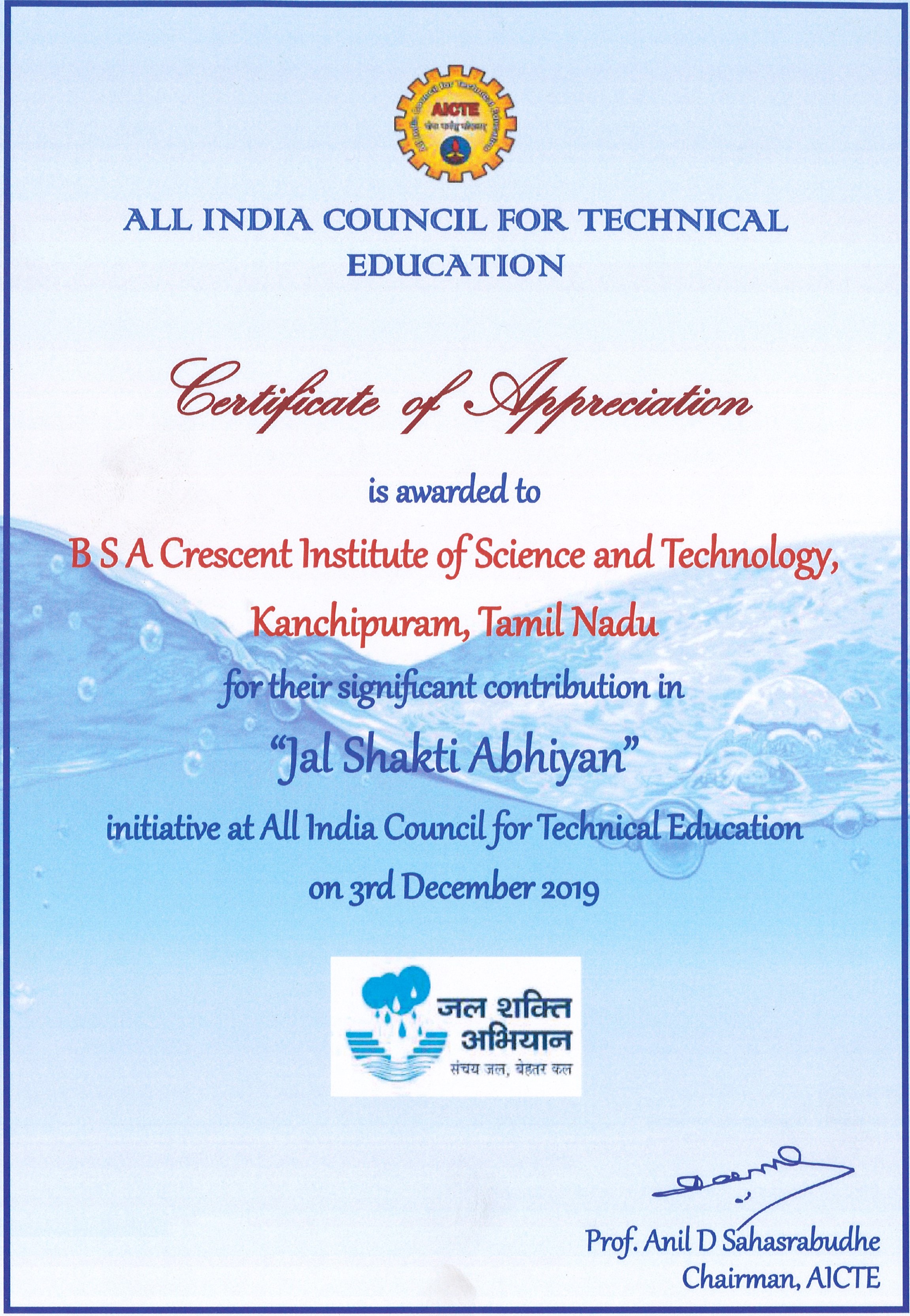
One Student One Tree – Appreciation

University of the year for Eco-Friendly Sustainable Campus – Appreciation

Recognized Social Entrepreneurship, Swachhta & Rural Engagement Cell (SES REC) Institution

District Green Champion Certificate

Beat Covid Campaign Institution Certificate

SDG 6
- Water Sources and Consumption Tracking
- Waste Water Treatment Process
- Preventing Water System Pollution
- Free Drinking Water
- Water – Conscious Building Standards
- Water Conscious Planting
- Water Reuse Policy
- Water Reuse Measurement
- Water Management Educational Opportunities
- Promoting Conscious Water Usage
- Off-campus Water Conservation Support
- Sustainable Water Extraction On Campus
- Co-operation on water security
- Water Sources and Consumption Tracking
- Waste Water Treatment Process
- Preventing Water System Pollution
- Free Drinking Water
- Water – Conscious Building Standards
- Water Conscious Planting
- Water Reuse Policy
- Water Reuse Measurement
- Water Management Educational Opportunities
- Promoting Conscious Water Usage
- Off-campus Water Conservation Support
- Sustainable Water Extraction On Campus
- Co-operation on water security


